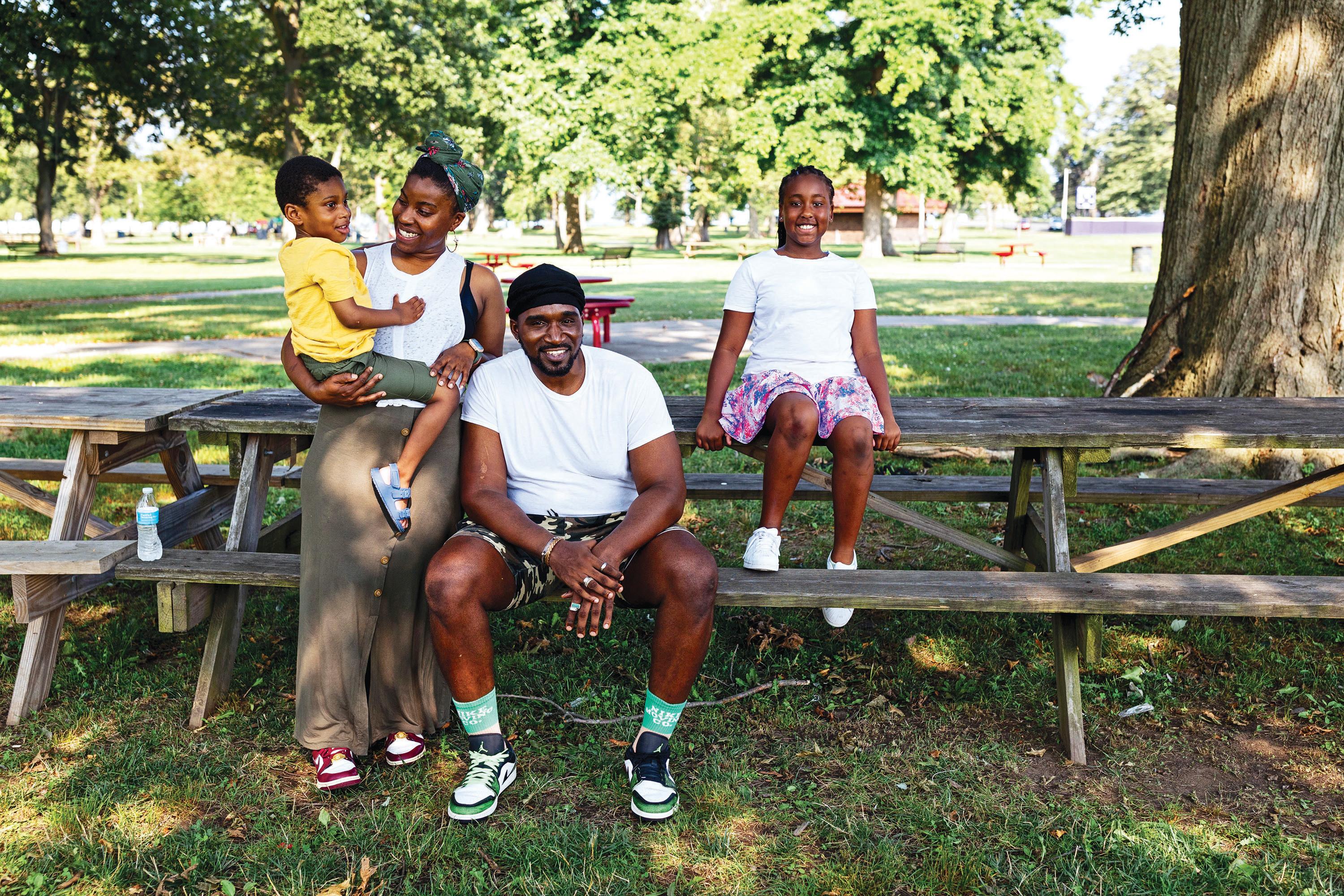




PROTECTING LOCAL ECONOMIES, REGIONAL IDENTITY, AND OUTDOOR RECREATION

PLUS: GOLF COURSES REIMAGINED, LONG ISLAND GETS A GREENWAY, AND A FRESH LOOK AT JUNETEENTH

Return the Favor: Become a Monthly Donor
Help us connect everyone to the benefits and joys of the outdoors with a recurring monthly gift. It’s easy, automatic, and secure.
Our members make our work to create parks and protect public land possible.
START TODAY
tpl.org/monthly
Wolcott Community Forest, which is adjacent to Wolcott Elementary School in Vermont, is frequently used by local children for outdoor recreation and education. CHRIS BENNETT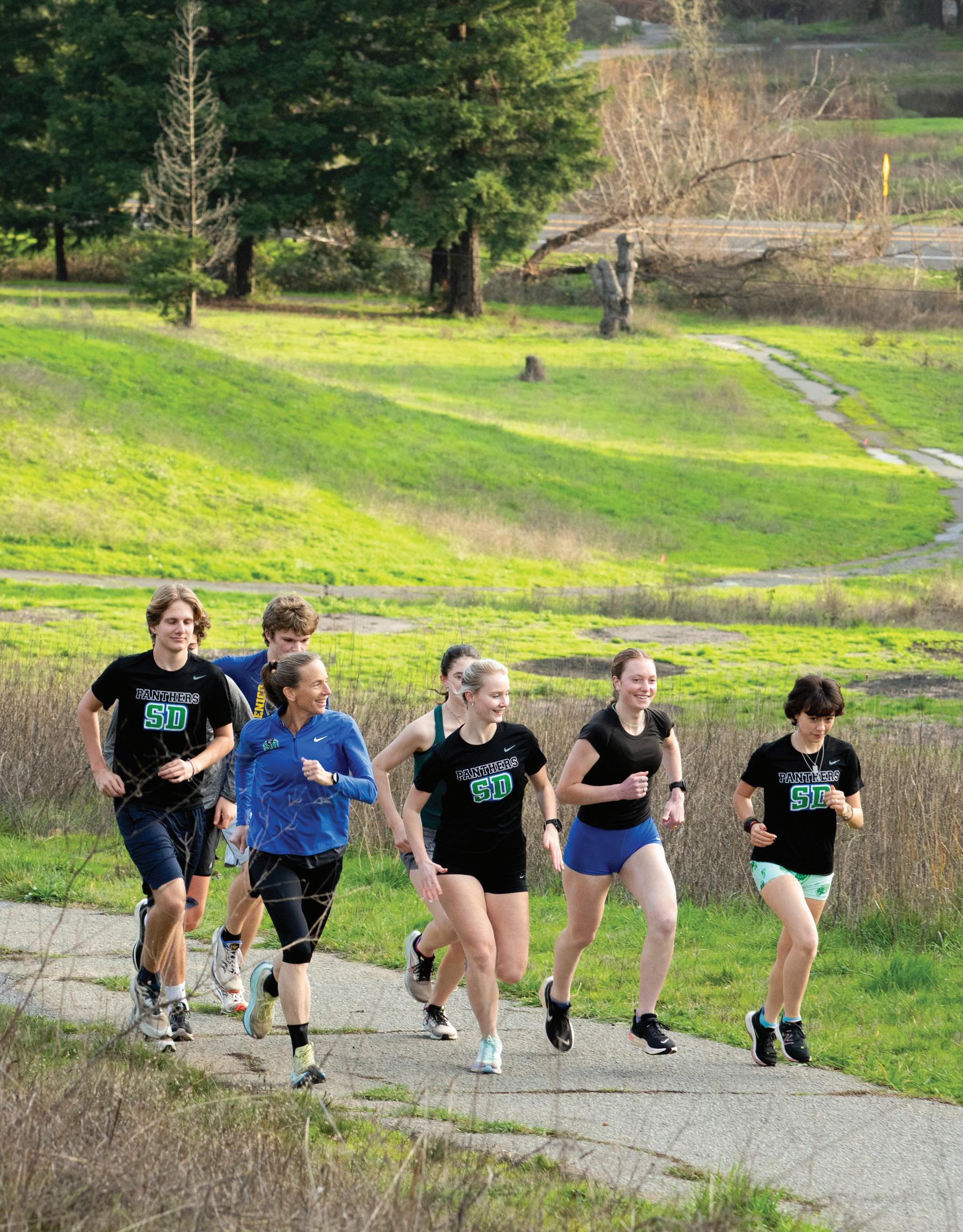
We’re partnering with communities to transform former golf courses into thriving outdoor oases that are accessible, biodiverse, and working to fight climate change.
The Long Island Greenway will stretch from Manhattan all the way to Montauk. At 200 miles long, it will bring 27 communities within a 10-minute walk of the outdoors. And when complete, it will change how Long Islanders and New Yorkers play, commute, and live healthy lives.
Working lands such as forests, farms, and ranches are an important part of our conservation efforts toward climate resilience. These places also support local economies and regional identities.
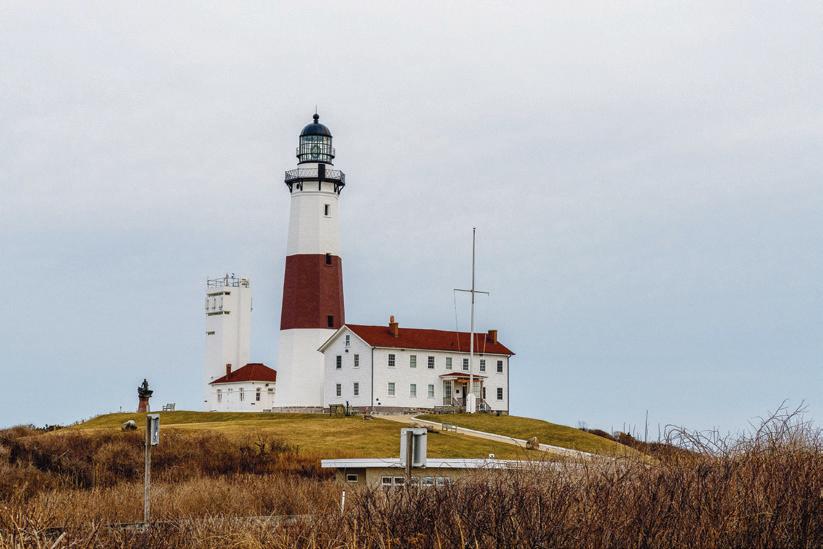
“The relationship we have with local food— we want to have that with timber.”
~ SARAH
IN THE GIVING TREES , PG. 48
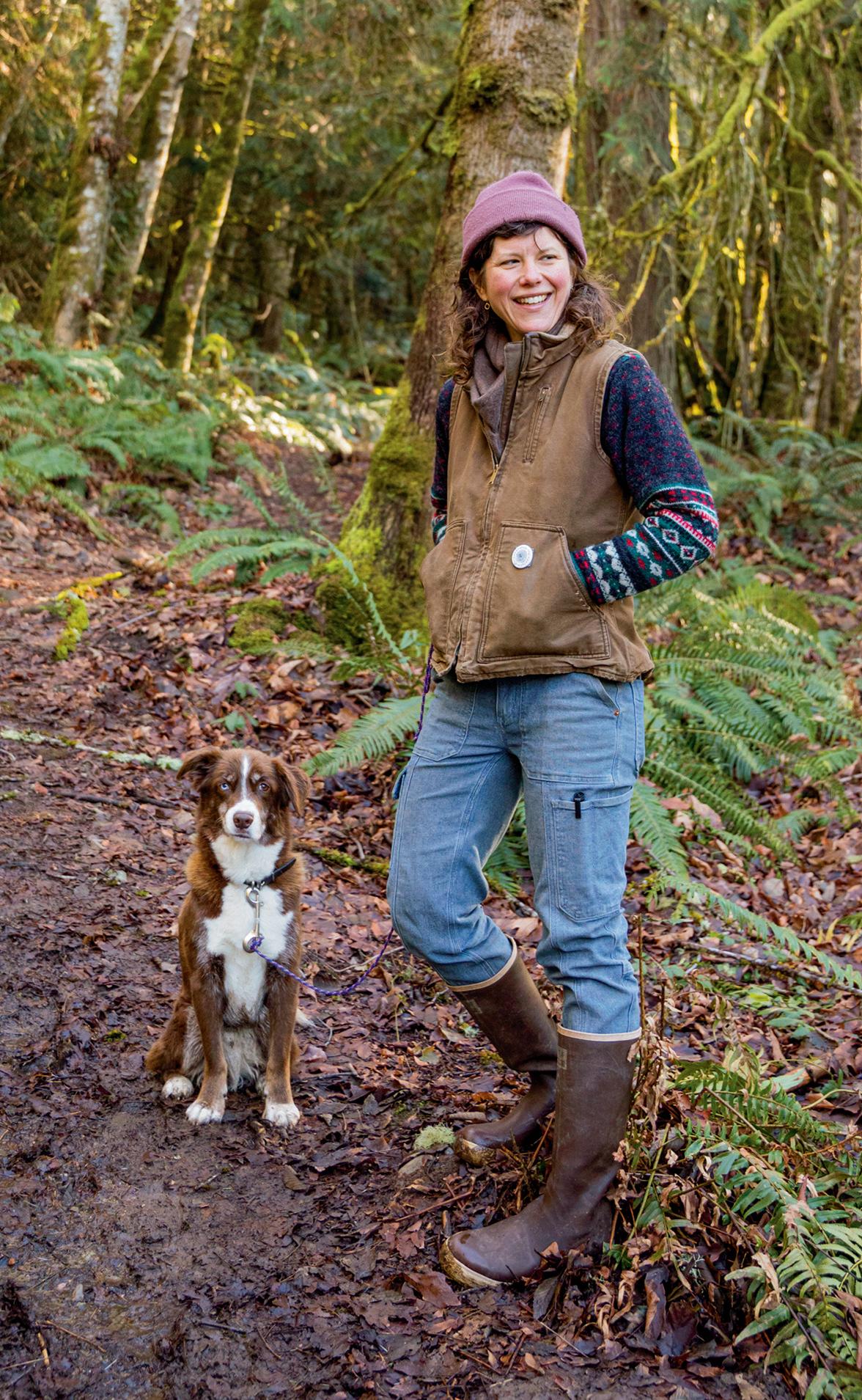
With a variety of ways to give, we offer something to suit everyone.
Use the envelope bound inside this magazine to send your gift, or donate online and learn about more ways to give at tpl.org/support .
Share your love of nature and outdoor adventures with someone you care about. Make a difference and honor a friend or loved one with a tribute gift.
Donate $2,000 or more annually and receive the recognition due a champion, such as invitations to special events and insider updates on our projects. Call 415.495.4014 or email champions@tpl.org to learn more.
Consider including us in your will or estate plan, learn about the benefits of designating retirement funds to TPL, and explore other tax-wise ways to give. Call 202.856.3748 or email plannedgiving@tpl.org to learn more.
Car recycling benefits both people and the environment by conserving natural resources, reducing pollution, and lessening energy consumption. Call 855.500.RIDE (7433) or visit tpl.org/cars to get started.
Simplify your charitable giving and meet your philanthropic goals by giving through your donoradvised fund. Learn more at tpl.org/daf. Scan with your mobile device’s camera to make a gift today!
Trust for Public Land depends on your support. You make our work possible.
tpl.org/support
From the President · 11
Our departing CEO shares a message of gratitude and expresses faith in TPL’s future.
Board Spotlight · 12
Get to know Kenneth Wong.
First Look · 13
Advice for beginning birders, a tour of climate-smart TPL parks, historymaking tribal lands work, and a conversation about equity and climbing the world’s tallest peak.
On Topic · 58
A compendium of insightful book, show, and podcast recommendations to bring you closer to the outdoors.
TPL Near Me · 60
A Dallas, Texas, high school student on the healing power of her community park.
Member Center · 62
Offices · 63
Trail’s End · 64
Juneteenth has more to do with public lands than you might guess.
on the cover
TPL Senior Director of Field Programs
Richard Corff marvels at the towering trees and lush growth along a trail near Washington’s Chimacum Ridge Community Forest.
RICH REID

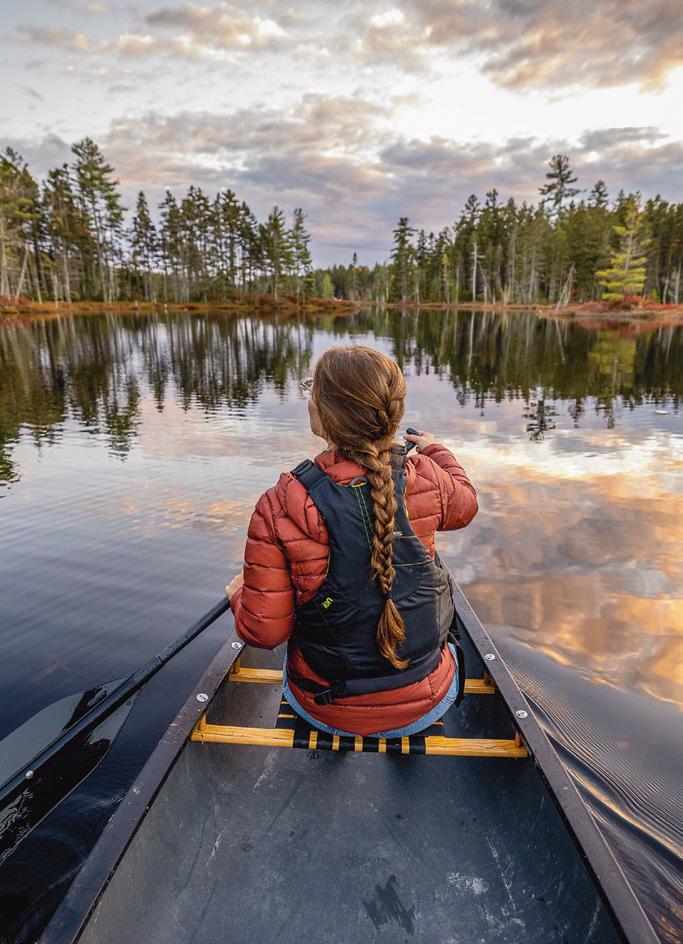


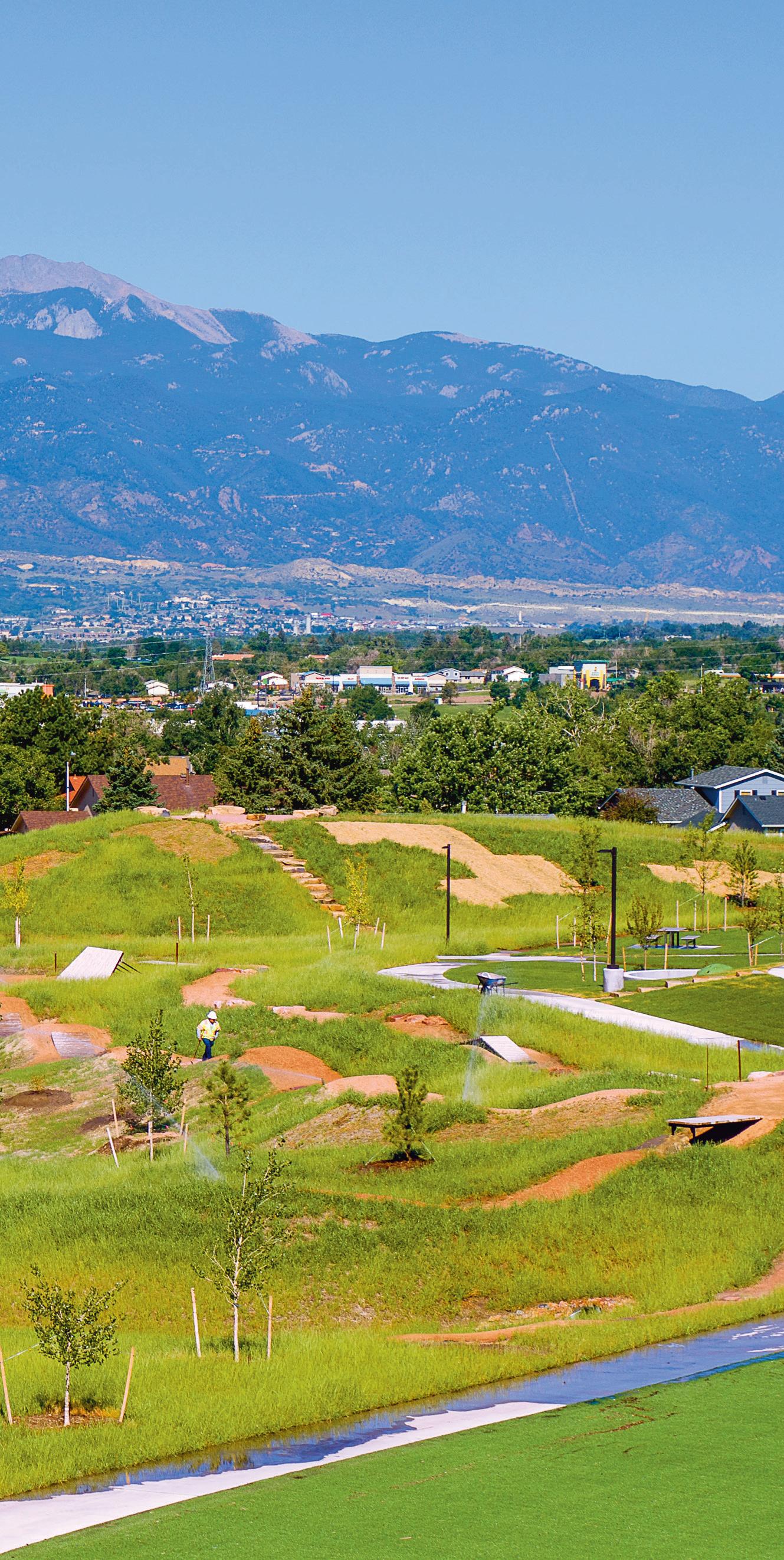
Besides being a gathering place for events and recreation, Panorama Park—which affords an incredible view of Pikes Peak— brings much-needed green infrastructure to a community that has suffered longstanding inequities, such as being about 7 degrees hotter than surrounding neighborhoods. In 2022, TPL completed the renovation of this 13.5-acre park, which features 250 newly planted trees, 20 shade structures, a splashpad, and a hammock zone where residents can find respite from intense summer weather. Even the bike course, shown here, helps retain and manage stormwater. Read more at tpl.org/panorama-story and discover 10 TPL parks that are models for green infrastructure across the country in this issue.
Page · 16
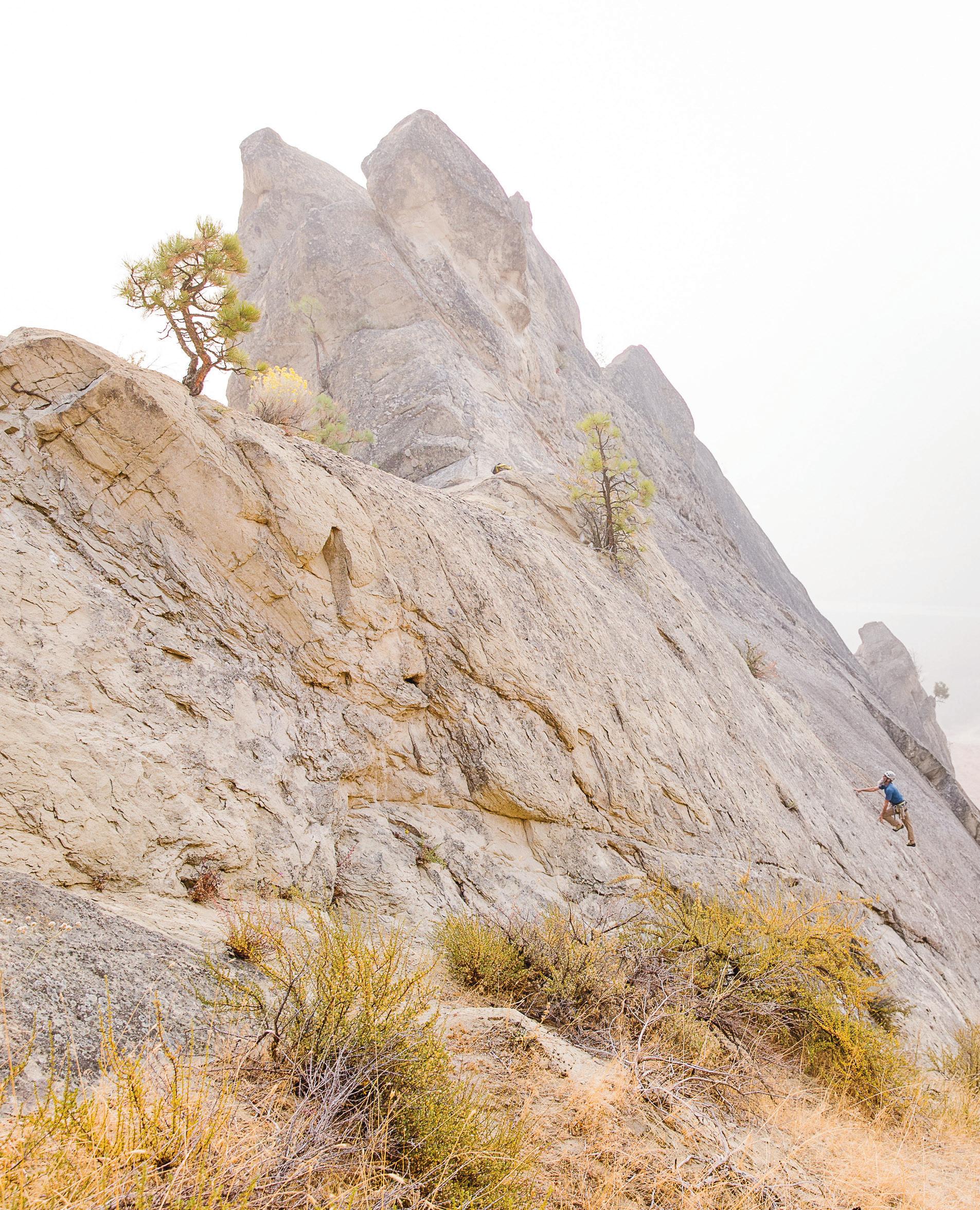
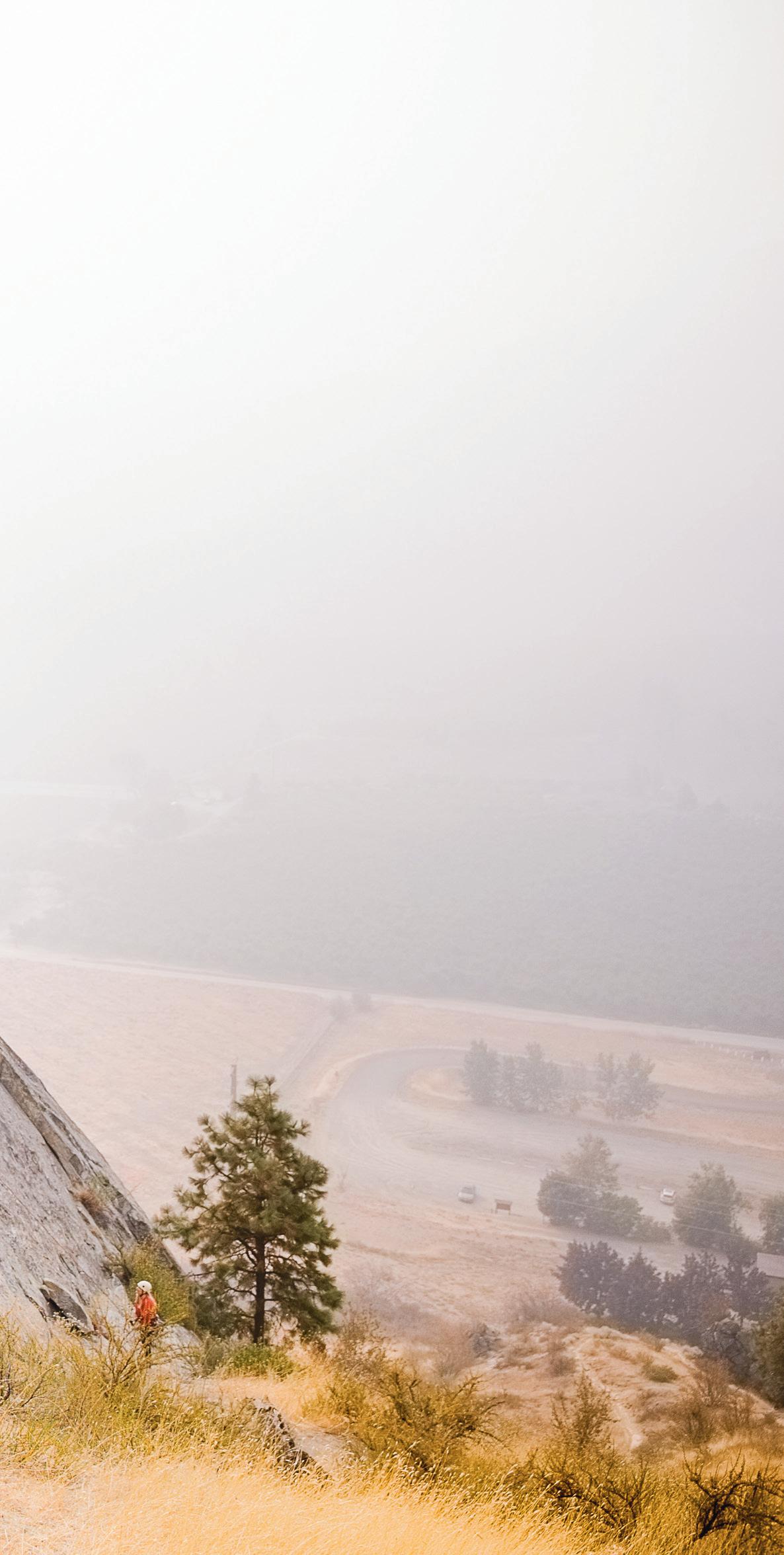
Chelan County, Washington
Once privately owned and closed to recreational use, the striking sandstone spires of Peshastin Pinnacles State Park are now open to climbing enthusiasts forever. Thanks to TPL, Chelan-Douglas Land Trust, and other partners, the park welcomes thousands of climbers and hikers every year to experience the beauty of the Central Cascades and Wenatchee Valley. In this issue, hear from members of Full Circle Everest, the first all-Black team to summit Mount Everest, on the joys and challenges of mountaineering.
Page · 20
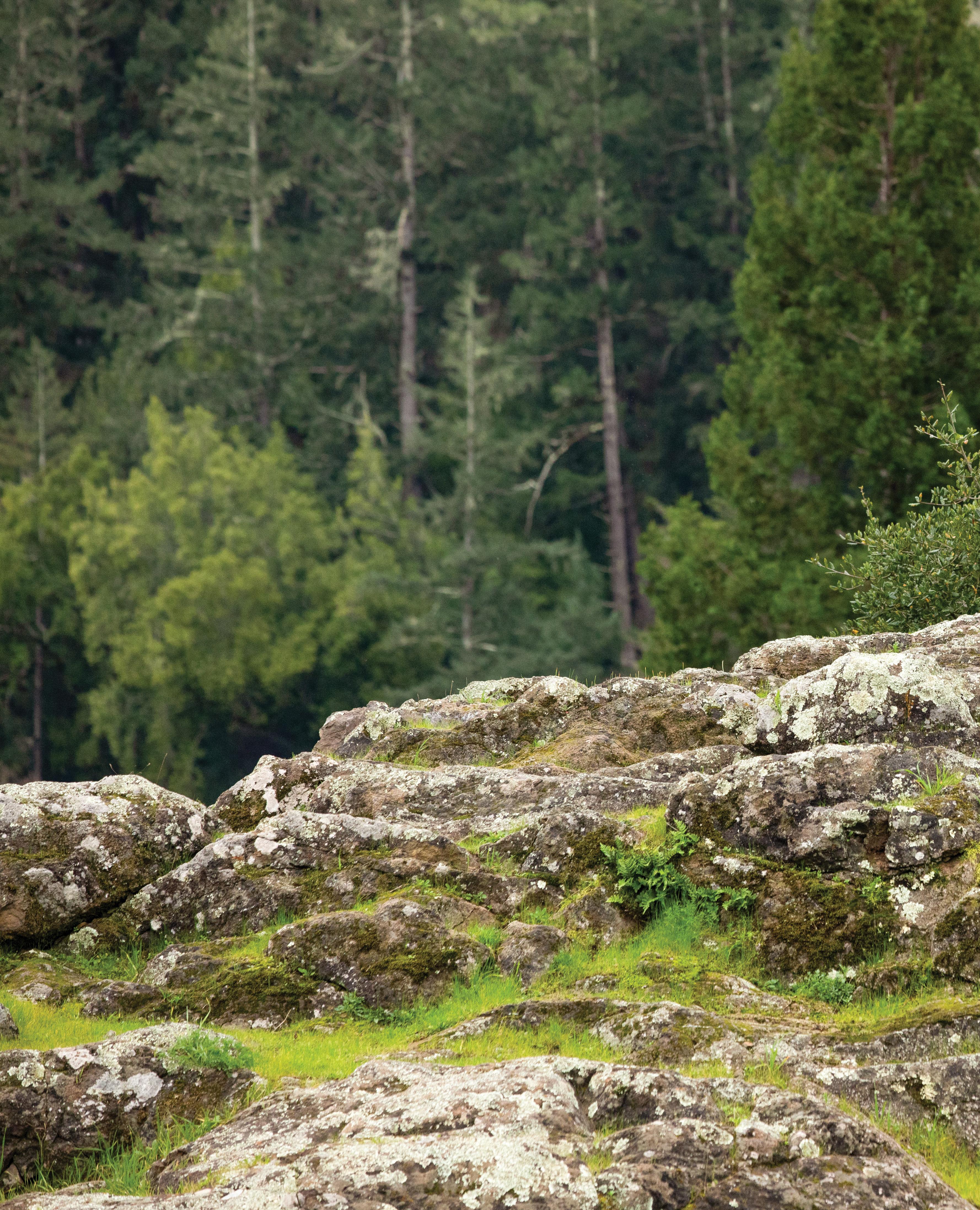
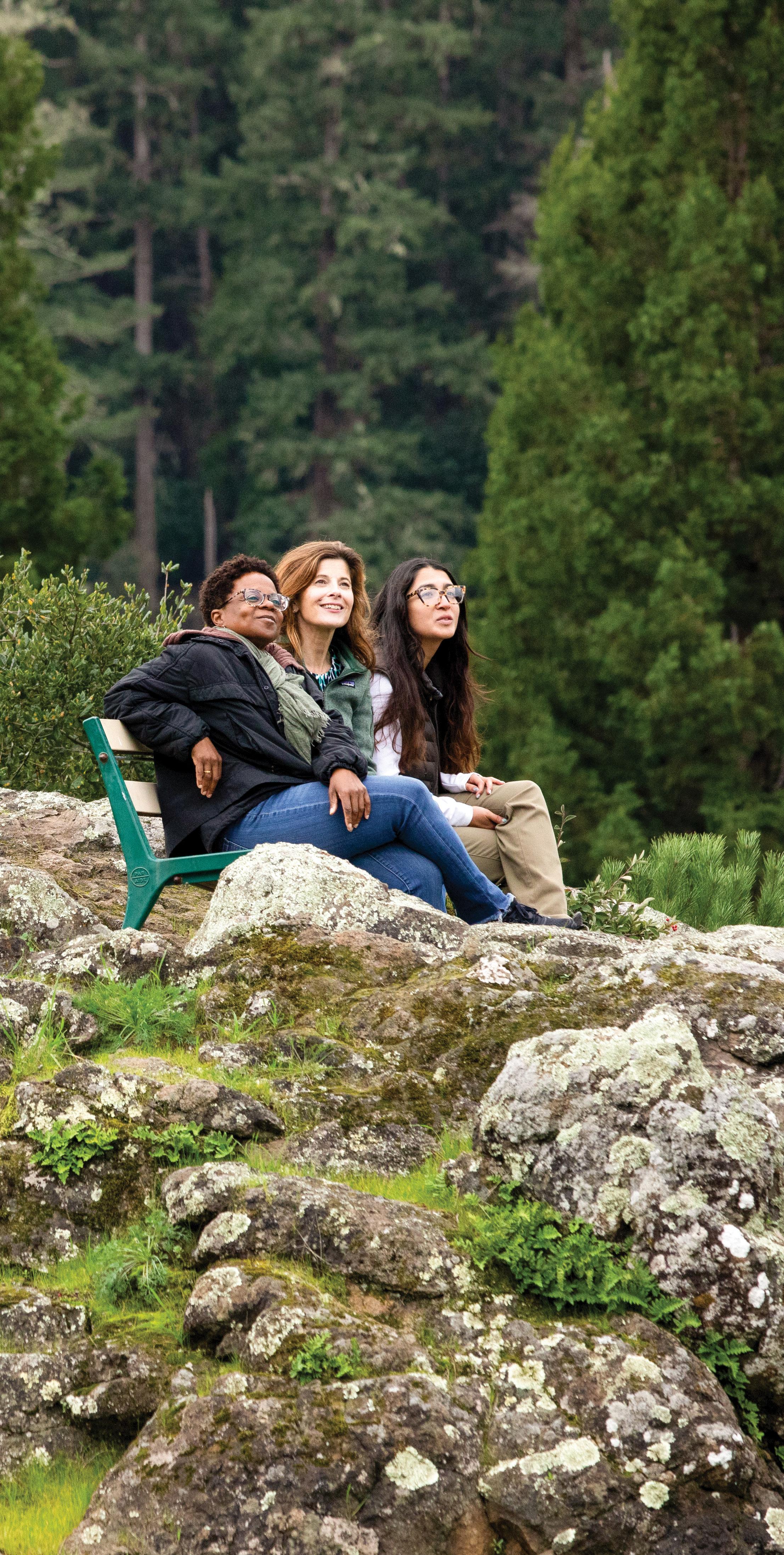
At San Geronimo Commons, a golf course turned community green space nestled in the forested hills north of San Francisco, a major landscape renovation is under way. The changes, which are returning the site to a more natural state, will greatly benefit both people and wildlife. Rather than pesticide-treated grass that requires irrigation, drought-hardy native plants are being added. Wild creeks that were previously forced underground will see daylight for the first time in decades. And residents can now use the site for a wide variety of outdoor recreation. Read more about TPL’s work transforming golf courses into natural areas in this issue.
Page · 26

Become a Conservation Champion and help Trust for Public Land connect even more people to nature. With your annual leadership-level contribution of $2,000 or more, you’ll receive invitations to special events and insider updates on our projects and conservation strategies. Learn more about the impact you’ll have as a Conservation Champion. Contact us at 415.495.4014 or champions@tpl.org.
tpl.org/champions | champions@ tpl.org
Join us online for project updates, stunning photos, and inspiring stories.
Follow us on social media:
@trustforpublicland
@TheTrustforPublicLand
@the-trust-for-public-land

@tpl_org
TrustforPublicLand
Be sure to tag us in your posts!
Sign up for our emails: tpl.org/email-signup
And listen to our podcast, People. Nature. Big Ideas. tpl.org/podcast

executive editor & publisher
Jennifer Ramsey
editorial director
Deborah Williams
managing editor
Amy McCullough
staff writers
Lisa W. Foderaro
Amy McCullough
designers Rachel Andrade
Miya Su Rowe
Ben Whitesell
media production manager
Elyse Leyenberger
As I write my final Land&People letter as Trust for Public Land’s president and CEO, I’m filled with gratitude, hope, and faith in TPL’s future.
I joined TPL six years ago because I was inspired by the organization’s unwavering commitment to equity—the cornerstone of our mission in connecting everyone to the outdoors. I’ve carried that sentiment with me throughout my journey here. It is our people and our collective vision for a better future that drives us forward. It is our hope in action. What an honor it’s been to work alongside staff, supporters, partners, and advocates who’ve helped this extraordinary organization achieve so much. Together, we’ve accelerated our land protection efforts to enhance economic and recreational opportunities. We’re spearheading a movement to make Community Schoolyards® projects a national standard. And we’ve strengthened our focus on equity with our Black History and Culture program and our Tribal and Indigenous Lands program. Our work has connected millions of people to vital green spaces, bringing opportunities to connect with nature and each other and instill a deeper sense of community. Every park, trail, community forest, landscape, or schoolyard adds to our collective power of hope in action.
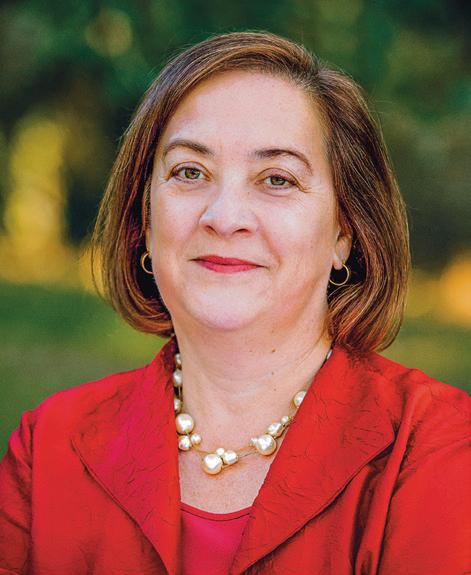
for the benefit of expanded public access to the outdoors and enhanced biodiversity, their hope for climate resilience and a sustainable recreation-based economy is self-fulfilling (page 26).
Every TPL project reflects our “community at the center” commitment. Our work doesn’t just change landscapes; it changes lives.
Our work is made possible by the involvement and support of people who, like us, believe that grassroots efforts can generate national impacts. We’ve built trust and credibility through our community-led approach to placemaking that’s positioned our leadership to drive national momentum in securing federal policies like the current EXPLORE and Outdoors for All Acts. More mayors and parks departments are signing TPL’s 10-Minute Walk® pledge. And we’re leading a nationwide movement to grow awareness and support for parks as critical infrastructure and climate-smart solutions.
© 2024 Trust for Public Land. All rights reserved. 10-Minute Walk, Community Schoolyards, Conserving Land for People, Conserving Nature Near You, Creating Parks and Protecting Land for People, Fitness Zone, Land for People, Land&People, LandVote, Northwoods Initiative, Our Land, Outside For All, Parks for People, Parks Unite Us, ParkScore, The Trust for Our Land, Trust for Public Land, TPL, and all other names of Trust for Public Land programs referenced herein, as well as their logos, are registered or common-law trademarks of Trust for Public Land.
When students design their own Community Schoolyards projects, the results are far more than new playgrounds. By participating in this work, children experience the power of civic engagement; they develop a sense of responsibility to their neighbors and a pride of collective effort. They have a hand in making their communities more climate resilient and experience the wonders of nature in safer, cooler, greener play spaces (page 16).
Acquiring 30,000 acres of forest in Maine’s Katahdin region is hope in action because it not only expands public access in the region, but it’s also important for environmental and economic health, and it’s sacred to the Penobscot Nation. When the largest land return between a U.S.-based nonprofit and a tribal nation is complete, the Penobscot will again be connected to Wáhsehtәk w (page 18), the land central to their identity and culture.
When communities like San Geronimo in Marin County, California, reimagine former golf courses
As I prepare to pass the baton, I know this isn’t the end of the race but a continuation. Each of us plays a vital part in this team effort. We must keep pushing forward with vigor because our work is vital to our individual happiness and the well-being of our nation.
As we approach the elections and the national discourse intensifies, I take great solace in the fact that our work, rooted in hope borne of action, bridges divides among us. At TPL, we’ve always believed in the transformative power of land to bring people together. That’s never been more relevant, and because of it we can look to the future with hope.
Thank you for joining me as a fellow TPL supporter. I am profoundly grateful to be a part of the TPL community, and eager to continue to support and champion this critical work.
 diane regas president & ceo
diane regas president & ceo
chair
Lucas St. Clair
Jodi Archambault
J. Franklin Farrow
Mickey Fearn
Jody S. Gill
Allegra “Happy” Haynes
Alex Martin Johnson
Jennifer Jones
Chris Knight
Christopher G. Lea
Joseph E. Lipscomb
Eliot Merrill
Ignacia S. Moreno
Julie Parish
Michael Parish
David Poppe
Thomas S. Reeve
Diane Regas
Laura Richards
Ted Roosevelt V
Lex Sant
Anton Seals Jr.
Sheryl Crockett Tishman
F. Jerome Tone
Taylor Toynes
Jerome C. Vascellaro
Lindi von Mutius
Keith E. Weaver
Susan D. Whiting
Florence Williams
Kenneth Wong
A RECENT ADDITION to our National Board of Directors, Kenneth Wong is deeply experienced in real estate and has held numerous high-profile positions. During his 40-plus-year career, he’s developed all types of buildings and places, including theme parks, affordable housing complexes, cruise ships, and master-planned communities. Today, Wong is chief operating officer of Related Companies and cofounder of energyRe, a leading renewable energy development company with projects across the United States. His diversified business experience, track record of creating places for people, and entrepreneurship in energy transition make him a unique member of TPL’s community. We asked him why Trust for Public Land is deserving of his time and energy.
What initially brought TPL to your attention? I was always aware of TPL at a distance and had a vague impression of it doing good things—boy, I had no idea! A few years ago, I began a personal quest to find an organization I could invest in, and that’s when I discovered how amazing this organization is.
What particular project or initiative speaks to your values and goals? There are many, but the topper is TPL’s Community Schoolyards® initiative. As someone who has worked in cities and real estate development my entire career, it is the ultimate crossroads of themes that matter: providing safe, clean, outdoor space for all (including kids), reducing heat islands, filtering urban runoff, improving health outcomes, and using the planning and design process to create ownership by the community. Climate change is truly the largest-scale threat to our future, and while every TPL program and initiative is making a difference, schoolyards have the potential to change the world for many people fast.
What types of challenges do you think TPL is uniquely poised to address? TPL is peoplecentered and values-centered. It builds solutions that produce both immediate results and longterm endurability. There are other fantastic
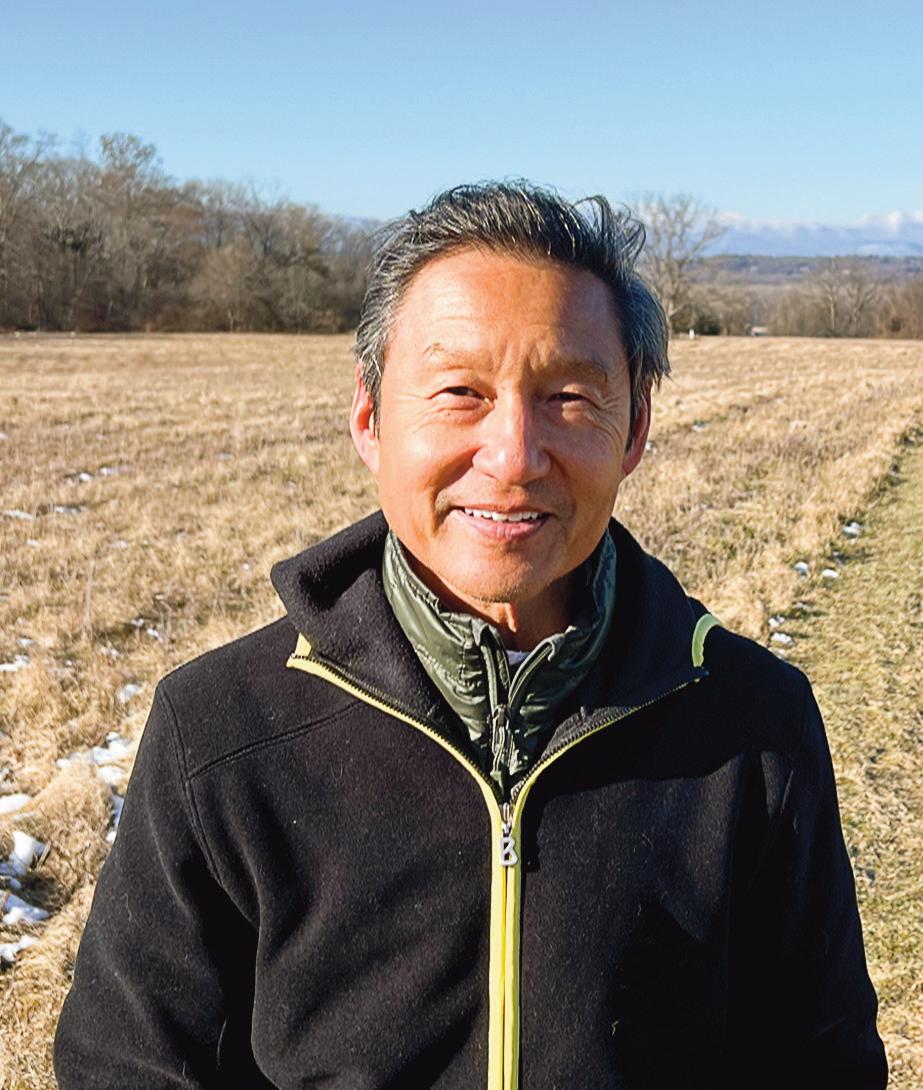
National Board of Directors since 2023
organizations in the conservation space, but TPL is extraordinarily skillful in this way.
What are you most looking forward to achieving as a member of TPL’s national board? I’m most excited about helping TPL scale its best work as powerfully and quickly as possible. I also want to build bridges. We need to find like-minded partners, not just in the nonprofit sector, but with universities, research centers, governments, and across the private sector, to magnify our impact.
On a personal note, how do you most enjoy connecting to the outdoors? Nature and the outdoors have always given me a sense of peace, strength, and connectedness. I love big nature that makes me feel small (mountains, ocean, a desert, a deep forest), as well as little pockets of nature like city parks and squares that connect me to other people. I’m lucky to have access to the outdoors year-round, and to share all those experiences with family and friends. I don’t take it for granted one bit, and that makes me even more passionate about the mission of TPL: we need to help connect everyone to the outdoors.

Famed marine biologist Sylvia Earle said,
“We are at a point in time where we have a choice. Imagine if you didn’t have the facts about what the problems are. Imagine if you didn’t have the solutions. But you have both.” By helping create community green spaces such as Historic Fourth Ward Park in Atlanta, Georgia, TPL is addressing the problem of climate change with smart design solutions that prevent flooding, limit pollution, and cool communities—all while providing places to play. Also see page 16.
TURN THE PAGE FOR: Avian Advice for Beginning Birders
Historic Land Return in Maine
A Climbing Conversation with Full Circle Everest
Birding provides opportunities to experience nature in a deep, fulfilling way—and it can connect you to a whole community of outdoor enthusiasts too. Follow these pro tips to get started, and you’ll soon be appreciating avian life all around you.
By Amy McCullough with Tykee James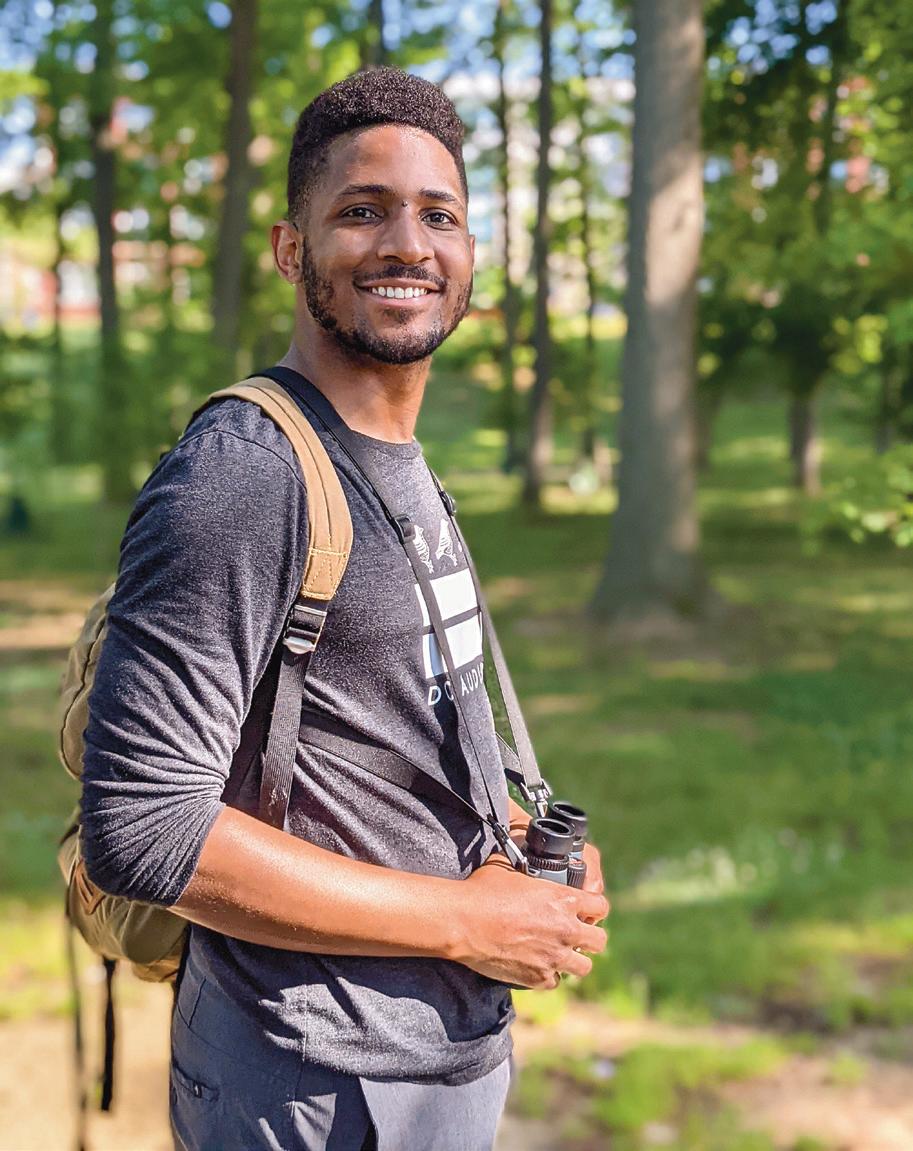
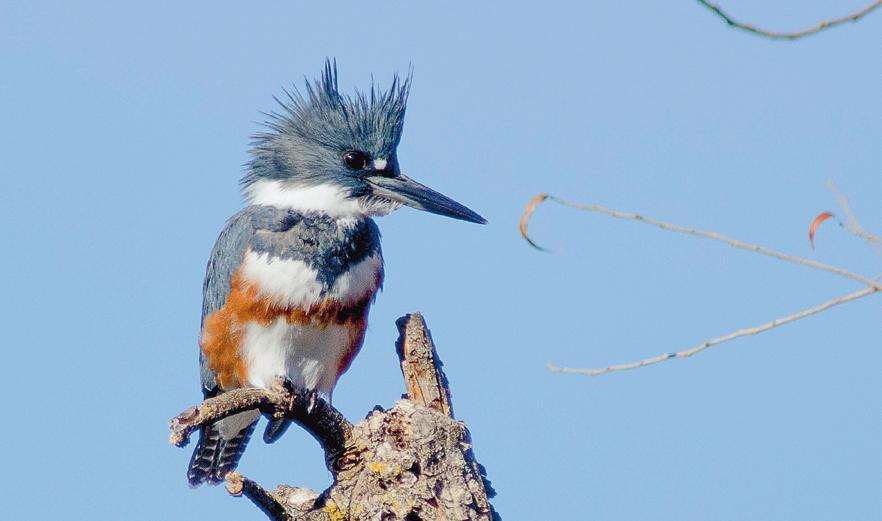
To bird expert and advocate Tykee James, birds are all about joy. He felt his first jolt of winged wonder at age 18, when he witnessed a female belted kingfisher (above) leap off a cattail and sing as it flew across a creek. He was mesmerized. “That bird made nature come to life,” says James (left). This is what birders call a “spark bird,” the species that ignites your interest. And finding yours is just one of several ways to ease into the activity known as birding. Here are a few more pointers to get you started:
1. Start where you are. Whether you’re at home, in a park, or even in a parking lot, there are birds to be seen. You don’t have to go far. You only need to be curious, spend a little time, look around, and be prepared to appreciate what you see. Keeping it simple helps demystify the practice. And while you don’t need special gear, binoculars are a helpful tool.
2. Find your spark bird. As a TPL supporter, you’re very likely a nature lover. While you’re enjoying whatever activities take you outdoors, look for birds. Sooner or later, you’re bound to see one that trips your trigger. Take its picture and identify it with the help of a field guide, another bird enthusiast, or an app (see tip #5). Once you know which bird wowed you, learn more about it.
3. Set a realistic goal. James recommends starting with a “familiar five,” as it’s likely you know at least a handful of birds already. Identify five species you’re comfortable with; then move to a familiar 15 and so on. But try not to get overwhelmed. “It’s not the knowledge of birds
that makes you a birder,” says James. “It’s the joy you have about birds and how you share it.”
4. Notice the details. James says there’s a lot to be gained from paying attention to the little things when observing birds. “‘Small brown bird’ describes a lot of birds,” he notes. Notice that the little brown bird also has a white bar above its eye, and a little black bib, and a yellow beak, and it’s bigger or smaller than this other bird you know. “All of a sudden these details start to collect,” says James.
5. Take a class and/or download an app. Many birding groups offer in-person and online courses. Enroll in one—or download one of the many free apps. James likes Merlin Bird ID for beginners because it includes real-life photos of birds in their habitats. And it can help you narrow down species by taking factors such as time of year, your location, and migration routes into account. But James cautions sound-only IDs because birds are excellent mimics.
6. Tell your bird story. And ask others for theirs. “I always go back to the idea that everybody has a story about birds,” says James, “whether it’s about the robin in your garden or the cardinal you hear on your commute.” Find your own bird story, tell it, and make a space for others to share theirs.
7. Get engaged. Consider recording your observations in an online database like eBird, or participate in events such as the Audubon Christmas Bird Count or the Cornell Lab of Ornithology’s Great Backyard Bird Count. These activities offer a way to engage with other birders and support research that relies on community input.
8. Support birds at home. Bring birds to your yard or neighborhood green space by adding feeders or birdhouses. Such offerings welcome local and migrating species and make for easy birdwatching—from your own window or on a daily walk, for instance. Be sure to provide a diverse mix of seeds and follow other best practices, such as cleaning feeders and raking hulls to prevent the spread of disease.
9. Enjoy the moment.
In the end, don’t forget to acknowledge the journey these creatures make and enjoy the moment. “Birds are going all across the hemisphere,” says James, “and the fact that one stopped in a tree near you and did a little ‘tweet’ before going on in its flight, being in that moment is absolutely magical.”
Turn to page 26 to read about how we’re improving wildlife habitats in California.
Tykee James hosts the podcast On Word for Wildlife, is cofounder of the Freedom Birders movement, and was an organizer of the first Black Birders Week in 2020. A former government affairs coordinator for the National Audubon Society, he is currently co-chair of Amplify the Future, which supports environmental education, and board president of the DC Audubon Society, which is in the process of changing its name.
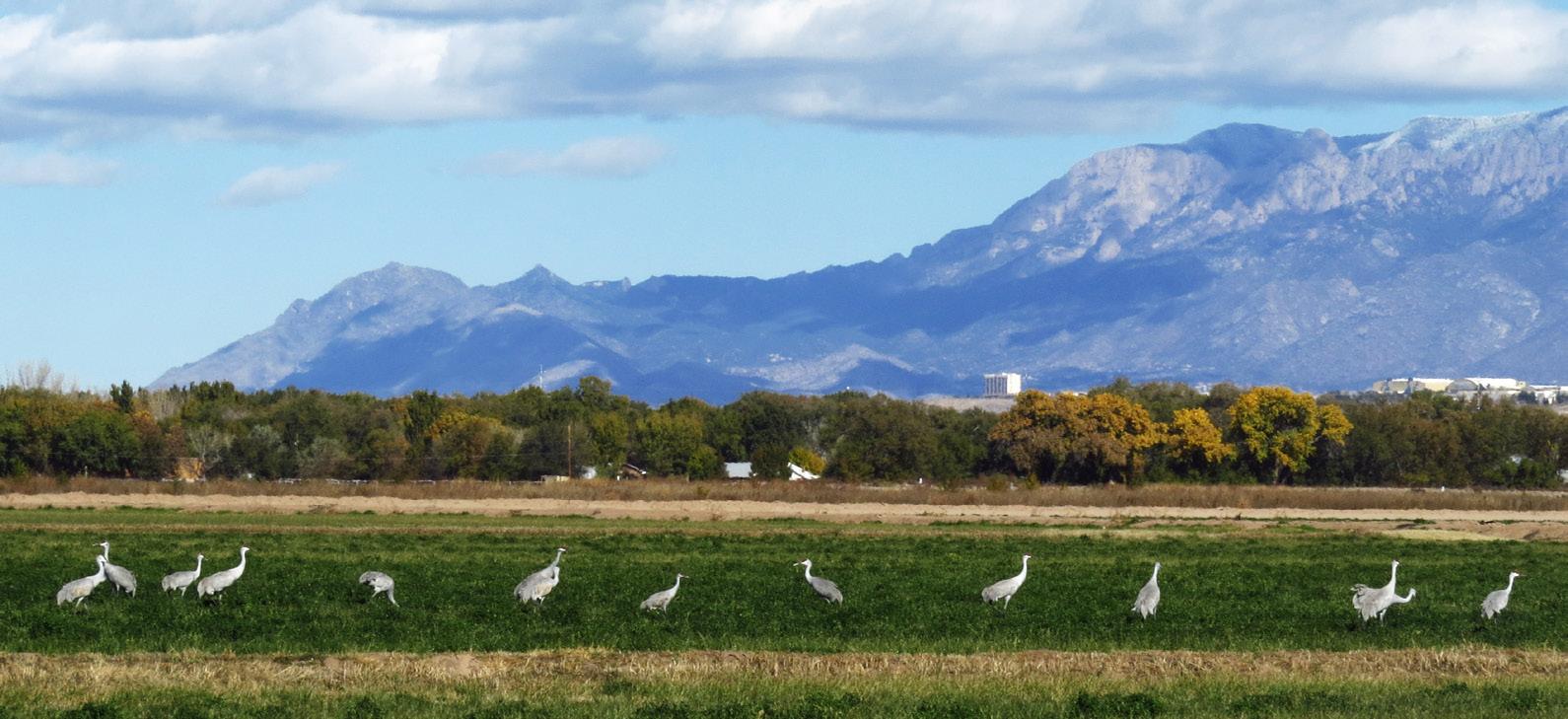
One of the touchstones of spring is the biannual migration of songbirds. TPL’s efforts have helped conserve many important migration paths. Here are a few locations that offer stunning birding opportunities. And don’t worry if you miss the current migration, which winds down in June. These parks and wildlife refuges have plenty of year-round residents too, from songbirds and shorebirds to hummingbirds and hawks.
By Lisa W. FoderaroIn May, all manner of warblers, thrushes, vireos, and flycatchers show up at this sprawling refuge along a 50-mile stretch of coast in southern Maine. One of the most beautiful sites in the preserve is Timber Point, a peninsula south of Portland where some 270 species of birds have been recorded.
This 485-acre green space along the Chattahoochee River, just 40 miles from Atlanta, is a terrific place to see migrating songbirds such as northern waterthrushes, Cape May warblers, and Canada warblers. The woodlands, thickets, and river draw breeding warblers too. And keep your ears open for the squeaky dog-toy sound of the brown-headed nuthatch, which lives among pines in the southeastern U.S.
In the shadow of Albuquerque, the Valle de Oro National Wildlife Refuge (pictured above) hosts an impressive
variety of bird life, from Swainson’s hawks, western kingbirds, and northern rough-winged swallows in spring and summer to northern harriers, horned larks, and Savannah sparrows in fall and winter. The refuge is a mix of hayfields, desert, and bosque, a cottonwood forest habitat that flourishes along rivers and streams in dry regions of the United States.
To fuel their amazingly long migrations, songbirds need food and water. Two properties in the southern Sierra Nevada, Hanning Flat and Desert Springs, provide both in abundance. Lark sparrows, Savannah sparrows, horned larks, prairie falcons, and golden eagles are found in the grasslands at Hanning Flat, while its higher-elevation pine-oak woodlands welcome Cooper’s hawks and sharpshinned hawks. Twenty miles south lies Desert Springs, which attracts neotropical birds flying north. Western tanagers move through in large numbers, as well as blue grosbeaks, black-headed grosbeaks, and a half dozen species of warbler.
When you enjoy the simple pleasures of a park—a shady spot to read or the sight of a duck gliding across a pond—you might not be thinking about what’s going on behind the scenes in the service of climate resilience. But at TPL, we are. When we design and build parks with residents and partners, we incorporate all kinds of climate-smart green infrastructure to improve resilience to heat, floods, and other threats. In doing so, we’re creating a replicable model for park development nationwide. Here are some of our most impactful green spaces— all of which couple function with form in a big way.
By Amy McCullough Illustration by Nate PadavickLos Angeles, CA
The Central-Jefferson and Quincy Jones Green Alley networks near South L.A.’s Central Avenue jazz district turned 11 underused alleys into safe, shaded pedestrian routes featuring trees, flowering vines, and colorful murals. They’re also engineered to manage stormwater, capturing more than 1.5 million gallons per year and replenishing underground aquifers that provide water to a region increasingly at risk of drought.
Bozeman, MT
This award-winning park and nature sanctuary—which is home to over 100 species of birds—undid heavy damage from prior industrialization. Now, its 60 acres include a restored riverfront, regenerated wetlands, and natural streams that greatly improve local water quality, plus a community garden to feed residents.
Greenbelt | Dallas, TX
| Denver, CO
Once a trash-strewn vacant lot, this 5.5-acre park, which serves 42,000 nearby residents, is now a restored native shortgrass prairie with an outdoor classroom, walking trails, interactive play spaces, and art designed with local students. It also features a central arroyo that collects and cleans stormwater before releasing it.
This ambitious greenbelt will include three new TPL parks and a 17-mile trail stretching across southern Dallas, adding vital green space for nearly 200,000 residents who increasingly face recordsetting heat. Climate-smart features include native rain gardens and lighting that’s 100 percent solar-powered, which will save $71,000 in electricity costs over the next 20 years See page 60 for a deeper look at the greenbelt’s first park.
Peace Park
St. Paul, MN
Residents of nearby Skyline Tower once had scant access to green space. Now, the community enjoys a climate-smart park with playing fields, bike paths, two rain gardens, a playground, and features that collect and filter 1.5 million gallons of runoff annually, keeping polluted water from flowing into the Mississippi River.
Rockefeller Park Cleveland, OH
Once complete, this renovated park—the city’s largest, covering 200 acres—will connect five nearby neighborhoods to the outdoors and to the Cleveland Cultural Gardens, a series of public gardens celebrating the region’s ethnic diversity. A watershed restoration at Doan Brook will also address dangerous stormwater flooding
WACA Bell Park | Chicago, IL
Based on ideas sourced from residents, TPL worked with partners to reinvent this once-vibrant park, which serves 9,487 residents within a 10-minute walk. Its transformation includes new trees, which will combat rising temperatures in an urban heat island, permeable surfaces that reduce flooding, and upcoming solar panels that will power lighting and Wi-Fi throughout the park.
Dundee Island Park | Passaic, NJ
Previously underused, this park— which serves 20,160 residents within a 10-minute walk—was transformed with local input and now includes a boat launch, soccer field, community garden, and walking trails. And its climatesmart design accommodates Passaic River flooding events, mitigating damage to surrounding neighborhoods.
The Pacific School Brooklyn, NY
This project, which reduces neighborhood flooding and pollution of nearby Gowanus Canal, is among several Community Schoolyards® projects to be completed with New York City’s Extreme Weather Task Force. It’s capable of managing 1.2 million gallons of rainwater a year, enough to cover a football field in 4 feet of water.
Historic Fourth Ward Park Atlanta, GA
Part of the Atlanta BeltLine—a 22-mile green space network— “H4WP,” as it’s known, gives people a place to cool off, play, and enjoy outdoor gatherings—all while providing safety against floods that previously inundated surrounding communities. The park’s infrastructure can decrease peak stormwater flow by as much as 44 million gallons of rainwater per day.
Communities are at the core of TPL’s mission. In Maine, Trust for Public Land’s Indigenous partners are playing a critical role in advancing important—and historic—land conservation.
By Maulian Bryant, Penobscot Nation Tribal AmbassadorAs director of natural resources for the Penobscot Nation, Charles “Chuck” Loring Jr. has a lot on his plate. Lately, he’s been working with Trust for Public Land toward restoring nearly 30,000 acres to the Penobscot Nation—acres that are central to his tribe’s identity. When achieved, it will be the largest land return between a U.S.-based nonprofit and a tribal nation in history.
Protecting this land, called Wáhseht әk w by the Penobscot (and pronounced “WAH-seh-teg”), will ensure preservation and Indigenous stewardship of the tribe’s ancestral homelands and sacred waters. It will also greatly enhance public access to Katahdin Woods and Waters National Monument, benefiting surrounding communities and enhancing the region’s outdoor recreation economy for years to come.
The Penobscot’s natural resources department oversees the management of these lands. Pretty consequential. But Chuck— who I’ve known for years as a fellow tribal member, a former
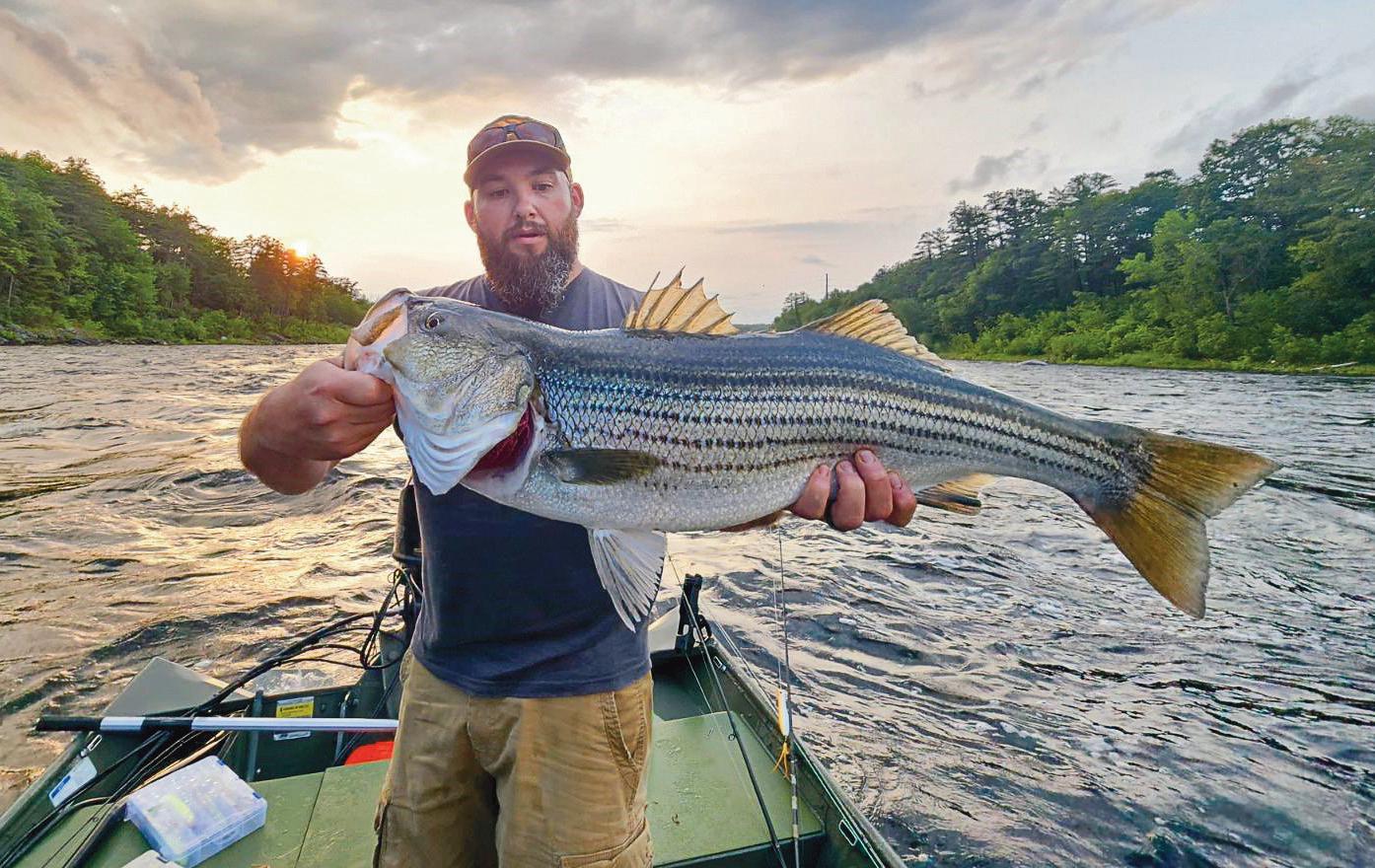
high school classmate, and now, as a professional colleague— sees his role as an opportunity to be both an important voice for his people and a crucial partner to TPL. “The most significant challenge is fundraising,” he says. “There are not many federal programs that exist that work with the Penobscot Nation’s desire to gain back ancestral homelands.”
Many of us grew up within large families that take great pride in our tribe’s outdoor traditions. We are taught from a young age about hunting and fishing and, most importantly, that harvesting game is part of the balance and reciprocity of the relationship between all living things. These are core values for our people: sustainability, sustenance, respect, trust, and the knowledge that the health of the natural world is ingrained in everything.
Those values are reflected in the magnitude of what this project means for our tribe. Located in the heart of the Penobscot Nation’s territory, the land carries profound importance for our people, who rely heavily on the Penobscot River and consider it a valued member of our community. “We are looking at this as a significant landscape-scale restoration project where we can let the forests heal from their previous industrial uses and focus on improving fish habitat, as well,” says Chuck.
But this partnership with Trust for Public Land to regain our ancestral land is not just about restoration and growth. It is about healing. The lands heal from generations of misuse. The Penobscot people heal from generations of theft and disruption of connection to these places of our creation stories. When we can harvest game and medicine or do ceremony in sacred places where our ancestors did these same things, our connection is restored, and our communities and families are given new life. Our tribe finds a great amount of joy and hope in what this collaborative land return means.
I haven’t met with a single tribal citizen whose eyes didn’t light up at the prospect of us gaining back the Wáhsehtәk w parcel.”
– CHUCK LORING, PENOBSCOT NATION DIRECTOR OF NATURAL RESOURCES
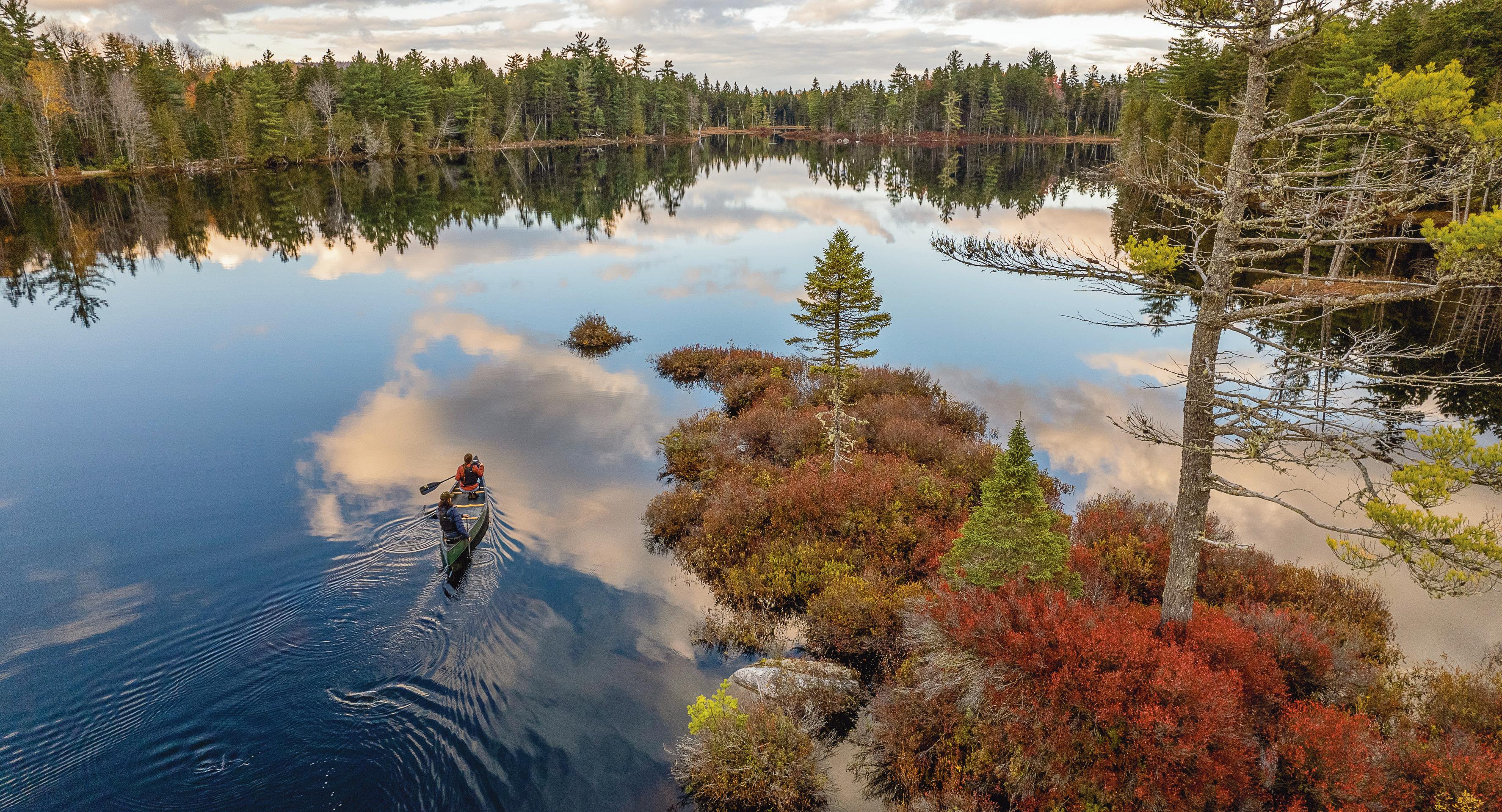
“This land back work is some of the most rewarding and important work I’ve been involved in,” says Chuck, who also serves as an advocate for our tribal administration and councilors. He sees its value on a regular basis: “I haven’t met with a single tribal citizen whose eyes didn’t light up at the prospect of us gaining back the Wáhsehtәk w parcel,” he reflects.
Chuck finds himself focused on the sacredness of the land itself and what it means to protect it; for him, it’s an opportunity to practice that same reciprocity that comes from being in balance with nature—a reciprocity he learned about as a boy, sitting in the forest, feeling the breeze, and appreciating the peace and stillness of the hunt.
Now, as a key spokesperson for TPL’s Wáhsehtәk w land back effort, Chuck gets to weave together his life experience as a Penobscot tribal citizen and his education in forest operations. “As a tribe that relies on sustainable timber harvesting for our main source of income, Wáhsehtәk w affords us more opportunities now and in the future to provide for our people’s needs while also returning our ancestors’ land into our care,” he says with enthusiasm.
“We once had claim to all of this land, which ultimately dwindled,” he continues. “We held that land in our minds in perpetuity. We are not your typical landowner. We have no record of development of any of our current lands; we are not a threat to shoreland or wetlands. We are responsible stewards, guided by our ancestors, elders, chief, and council
to do the right thing by our land for our people.” It’s a sentiment shared by many members of our community.
Diane Regas, TPL’s president and CEO, agrees: “Trust for Public Land recognizes the profound and vital significance of returning land,” she says. “It’s not just an isolated act, but a deep acknowledgment and reaffirmation of a timeless bond, a rich history, and a promising future.”
Though there are certainly obstacles to progress, our tribe is cautiously optimistic and hopes that through storytelling and cultural exchanges, we can fully express to potential funders and supporters how much this land means to our people—past, present, and beyond.
And as a father to a young daughter, Chuck is certainly looking ahead. He feels a responsibility to make things better, just as his family felt while he sat as a boy in a hunting stand, listening to the forest and the lessons of our ancestors carried on the breeze.
Maulian Bryant has been Penobscot Nation Tribal Ambassador since 2017. She is working closely with TPL’s Federal Affairs team to help identify funding sources for the Wáhsehtәk w land return. Show your support for land conservation across the country by making a gift today at tpl.org/land&people learn more @ TPL.ORG/TRIBAL
Embracing the joys and challenges of climbing— including breaking down racial barriers—with the first all-Black team to summit Mount Everest.
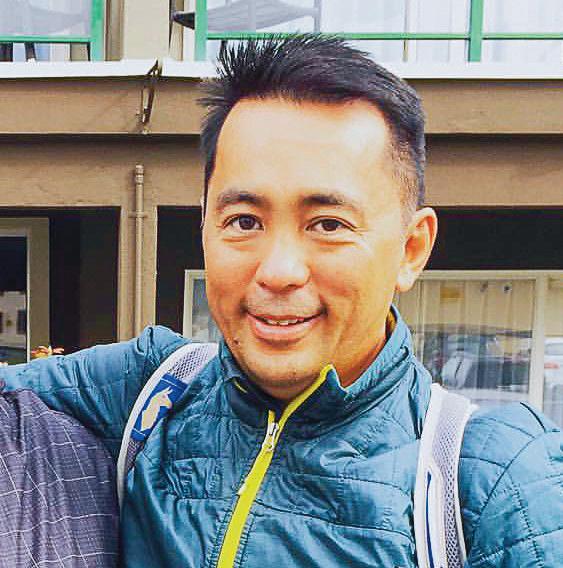
Last fall, TPL Northwest Director Mitsu Iwasaki (right) was joined in conversation by three members of Full Circle Everest, the first all-Black team to summit Mount Everest. Together with seven other people of color, expedition lead Philip Henderson and mountaineers Demond “Dom” Mullins and Adina Scott climbed the highest mountain on Earth in May 2022. Read an excerpt from their enlightening discussion with Iwasaki about inclusion and equity in outdoor recreation, presented in partnership with Seattle Arts and Lectures.
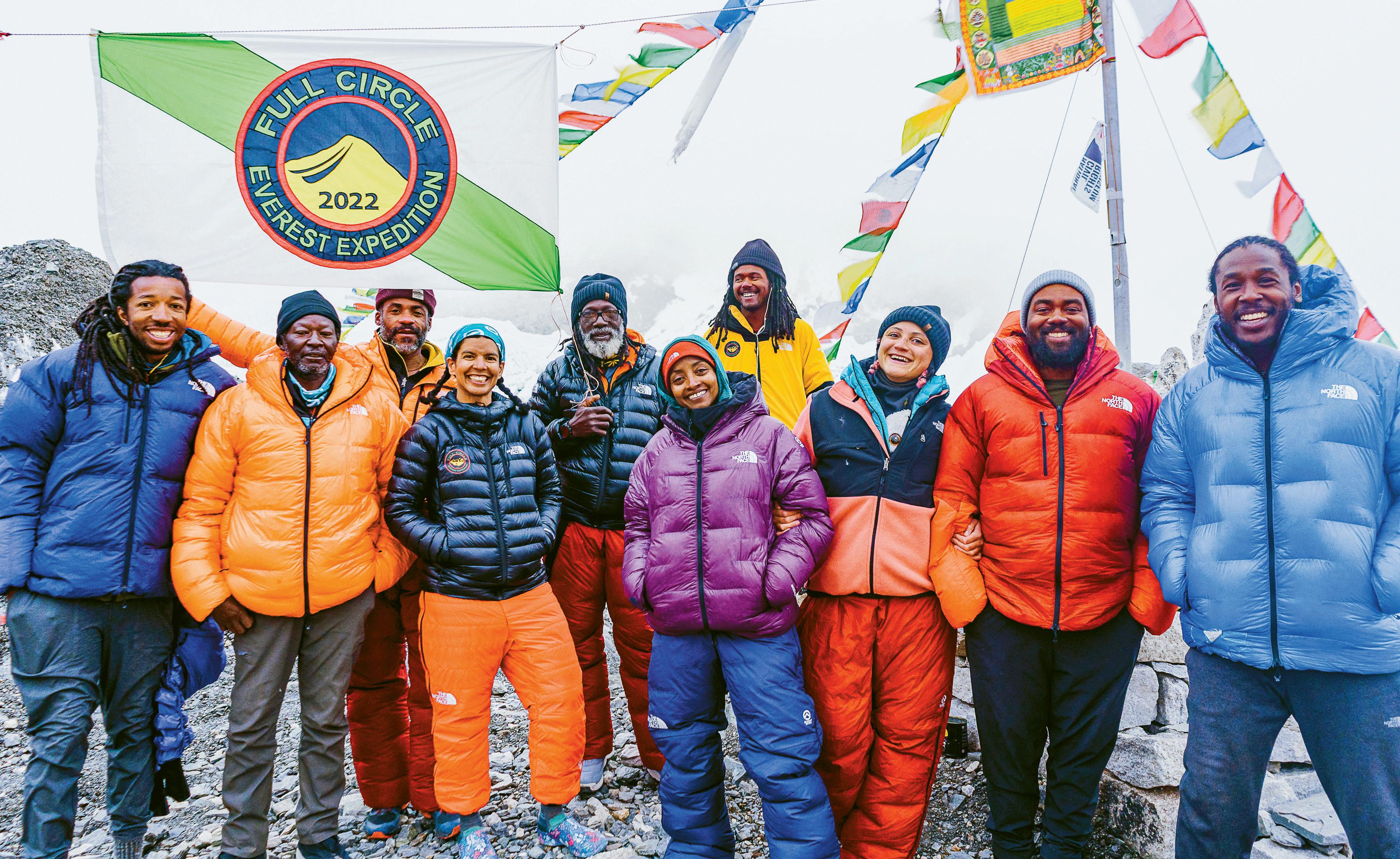
MITSU IWASAKI: What is Full Circle?
PHILIP HENDERSON: Full Circle is about giving back. In the early ’90s, when I started working in the outdoor industry, I realized that there were people out there who wanted to know about camping and hiking and skiing and climbing. They just didn’t know how—at least from my community.
MI: How did this team come together?
DOM MULLINS: It was all sort of happenstance. Philip was kind of a unicorn—this African American dude who worked in the outdoor industry for 30 years. Philip had the opportunity to meet, by chance, all these other athletes that wound up being part of our project.
ADINA SCOTT: I did a trip to Denali in 2013 . . . Philip was there. Fast-forward a while, I get this phone call [from Phil]:
“Hey, how ya doin’? We’re going to Everest. You coming?”
I think a lot of the people on the team have a similar phonecall-coming-from-out-of-the-blue story.
PH: When I was building the team, it wasn’t like, “I’m going out to find 10 Black people to climb Everest to make a point.” All of our paths just happened to [cross]—everybody has a story. Our lives were just there, so we made it happen.
MI: Climbing is a lot of work. There’s a bit of suffering in there—and a lot of time and resources invested. There’s also a great deal of joy in it. What is the joy that you find in climbing?
AS: To me, it’s become really integral in spending this time outside, and with people, and in places that are magical. Finding the right people to do it with, there’s nothing like it.
DM: I grew up in Brooklyn. I didn’t know anything about wilderness. I learned about wilderness when I was in the army. I fell in love with it, but it didn’t even have a name for me. It was like, “This is army stuff.” Stacy [Bare, a fellow climber] introduced me to mountaineering. Part of the joy of climbing for me was realizing that I had an education that
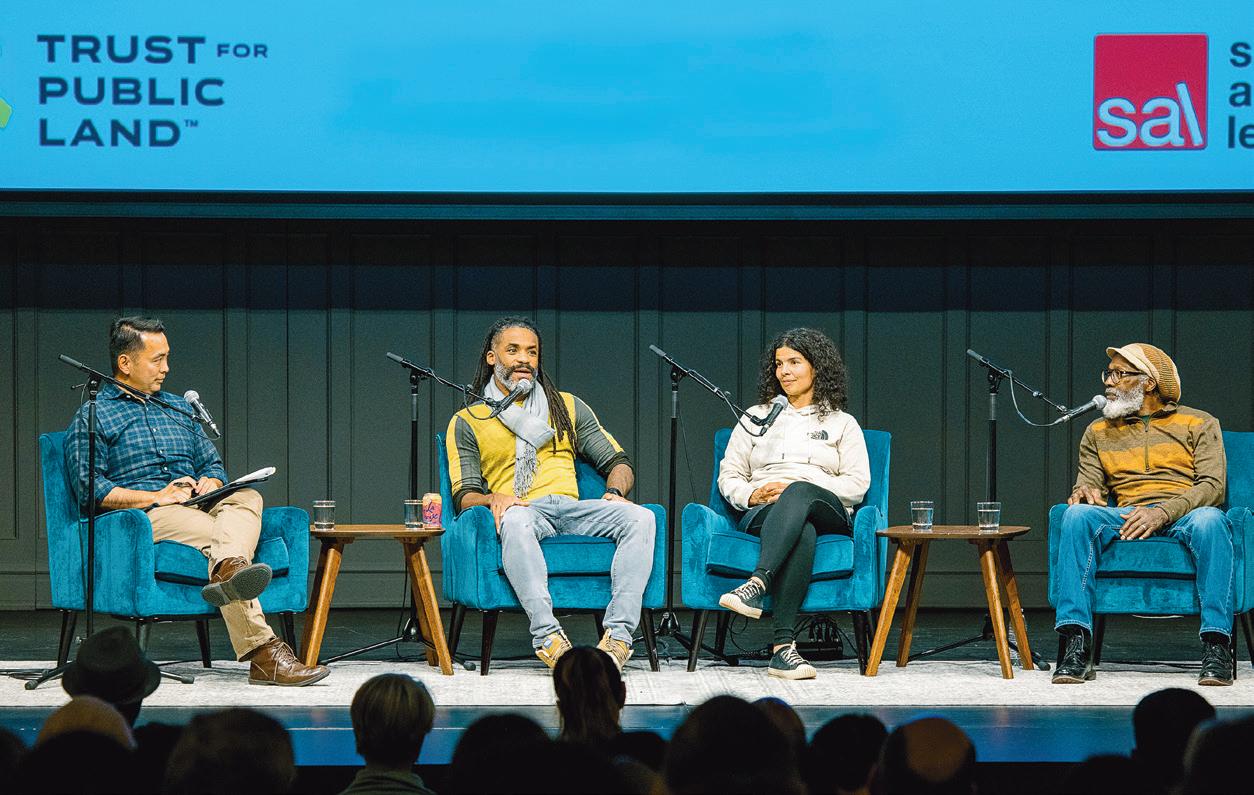
was conducive to all of that. I learned how to climb with a veterans’ group. It became a vehicle for community for me, after service, and also to get myself into the sort of exciting trouble that I missed.
PH: The joy in climbing to me is just that I like doing things with my hands. It’s the technical aspect and the problem solving. As well as, if you’ve ever had birds flying below you, to me that’s one of the joys of climbing. Being outdoors . . . I’m just peaceful. I’m happy. I’m free.
MI: For Full Circle, there is an incredible amount of responsibility in representing your community—and a sense of not having space to fail. Can you talk about that?
AS: I think the really scary thing about showing up publicly and showing up out loud is that people are going to think what they think. People are going to judge a community based on [us]. We do have expertise. Everybody there has a lot of experience. But it’s like, “Did I show up right? Are my
The joy in climbing to me is . . . the technical aspect and the problem solving. Being outdoors . . . I’m just peaceful. I’m happy. I’m free.”
–PHILIP HENDERSON, FULL CIRCLE EVEREST EXPEDITION LEAD
Climbing is a lot of work. There’s a bit of suffering in there—and a lot of time and resources invested. There’s also a great deal of joy in it.”
–
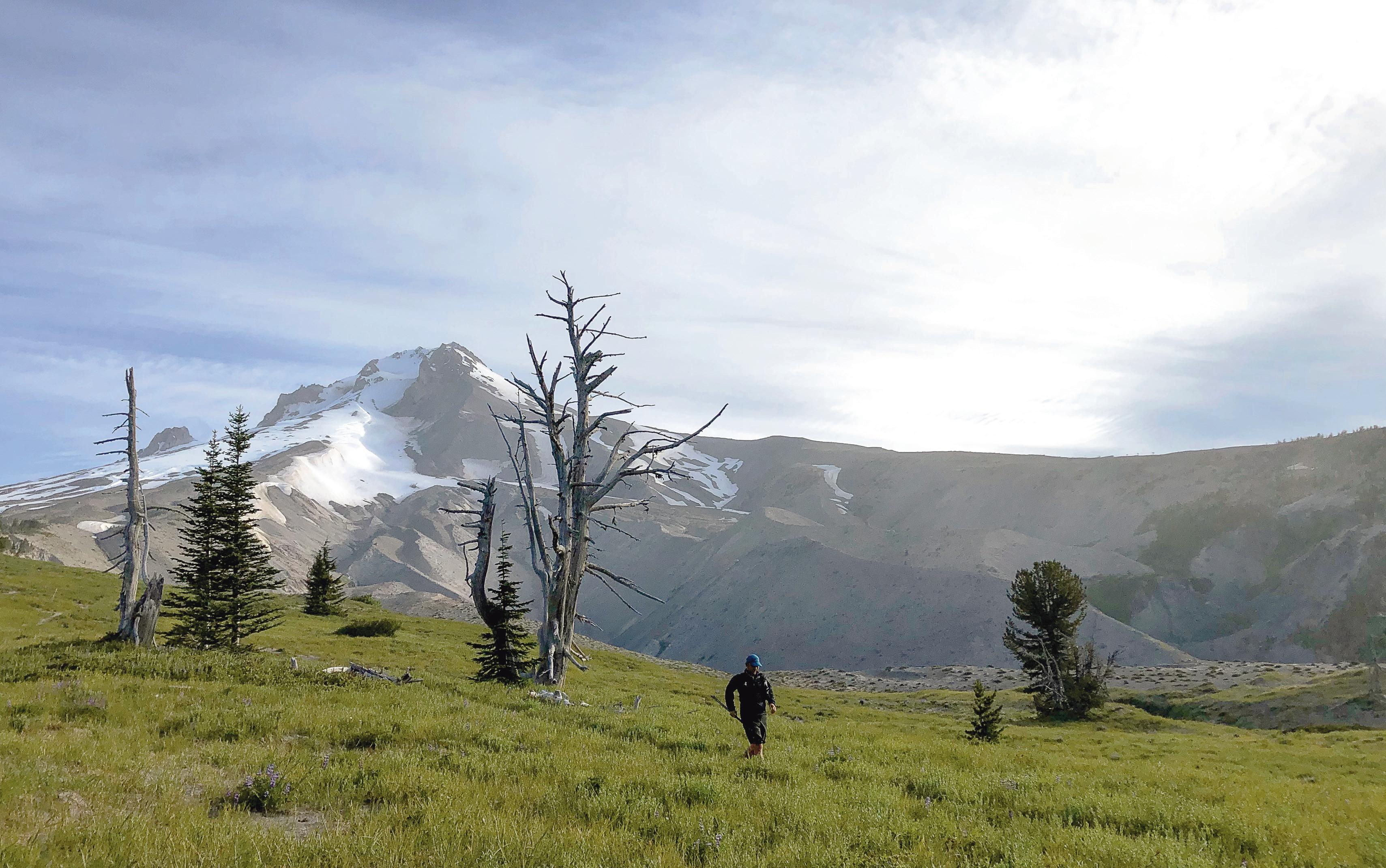 MITSU IWASAKI, TPL NORTHWEST DIRECTOR
MITSU IWASAKI, TPL NORTHWEST DIRECTOR
crampons good?” All of those extra anxieties. The outdoor industry can be a pretty darn judgy place at times, and sometimes it’s for good reasons [such as safety], and sometimes it’s not. Being confident in our own abilities is kind of hard.
MI: Can you talk about what it means to be different among often intimidating and exclusive climbing communities?
DM: Particularly in mountaineering, I know we all have had experiences where we find ourselves the only person of color in a whole situation. I had become accustomed to having that type of experience in other institutions—in my professional life, when I was in the military. When I encountered that in the outdoor community, it was actually funny to me, because I didn’t realize it at first. I had become so used to it. It was other people who noticed it before I did.
Now is a productive moment in the outdoor industry, where we’re starting to have conversations about how to make these spaces more conducive to diverse peoples. It’ll lead to better outdoor education, and it’ll lead to better rapport and even earnings for the companies in the outdoor industry. It’s a win-win situation for everyone involved.
PH: When I started working at NOLS [National Outdoor Leadership School], I was the only Black American instructor there for six years. None of my coworkers—in the office or in the field—looked like me. But whatever is in the past is in the past. We want to normalize being in the outdoors and that connection to the outdoors. I can blame all the things that happened previously, but if I don’t change that moving forward, then that’s on me. [I can] provide [that experience] for someone else because I know what the benefits are. So that’s full circle.
Trust for Public Land recently completed the first phase in a complex land protection project that offers an array of benefits for people and wildlife in Colorado and beyond.
Planes and plains come together on the unique piece of land known as Bohart Ranch, part of which TPL protected last fall. Located east of Colorado Springs, the site includes a remote runway known as Bullseye Auxiliary Airfield, a critical training area for the U.S. Air Force; the wide-open skies above the ranch are also used by the Air Force Academy.
Protecting the site from encroaching development is important for a variety of reasons. Beyond the airfield, an active cattle ranch—maintained by multiple generations of the same family—helps sustain the area’s economy and identity, as cattle ranching is the lifeblood of many rural communities. (The same family will continue to lease and steward the land moving forward.) Plus, the rolling grasslands and miles of streams at Bohart Ranch provide native habitat to over 200 plant species and iconic fauna such as bison and elk.
An outcome of the SOAR initiative (which stands for Security, Open space, and Agricultural Resilience), the protection of this 11,900-acre property was a collaborative effort with partners such as The Nature Conservancy, and it’s
been many years in the making. “Through the SOAR initiative, we have a once-in-a-generation opportunity to make major progress in securing the natural, economic, and cultural vibrancy of the Colorado Springs region,” says Jim Petterson, TPL’s Mountain West region vice president.
This is the first acquisition in a multiphase project that will result in the permanent conservation of the entire 75-squaremile ranch. In one more boon to local communities, the Colorado State Land Board will direct the proceeds from this and related projects toward its mission to support public education. “You know you’re onto something when a project emerges that conserves important wildlife habitat and open space, supports agricultural production, provides muchneeded funds for public education, and enhances national security," adds Petterson. Turn to page 48 to learn more about our conservation of working lands.
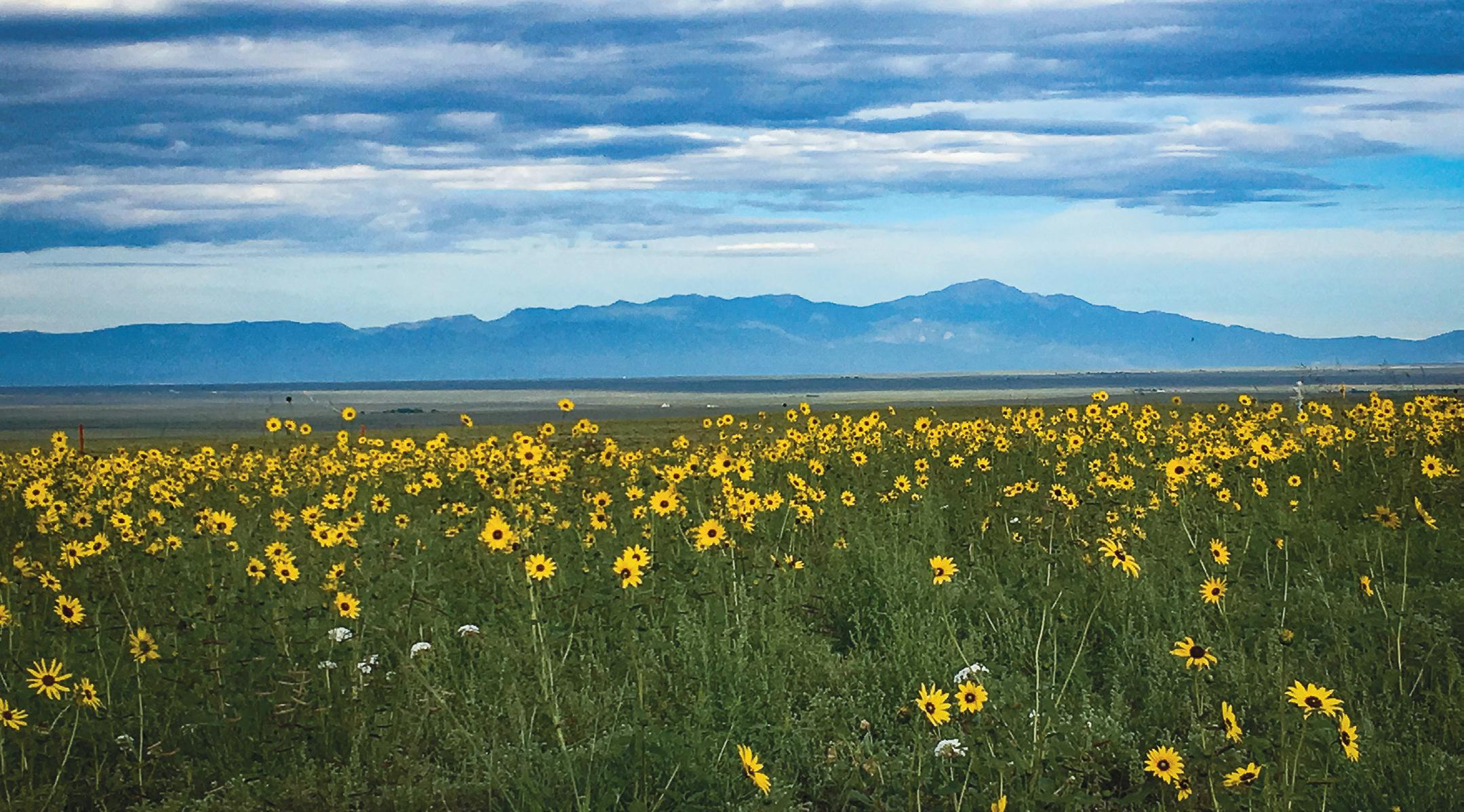
We couldn’t achieve our commitments to climate, equity, community, and health without their generous financial contributions to our mission and our work. Thank you for helping us connect everyone to the outdoors.

Community Schoolyards® initiative & Parks for People | Boston, Massachusetts; Los Angeles, California; & Denver, Colorado
Transformation of ‘A‘ala Park | Honolulu, Hawai‘i
Community Schoolyards® initiative | California; Pennsylvania; Washington, DC; & Washington State
Wildfire Resilience Initiative | Southern California
Park Creation & Accessibility | Nationwide
Dalio Center for Health Justice support of the Community Schoolyards® initiative | Brooklyn & Queens, New York
Community Schoolyards® initiative | Los Angeles, California Tribal Schoolyards projects | Nationwide
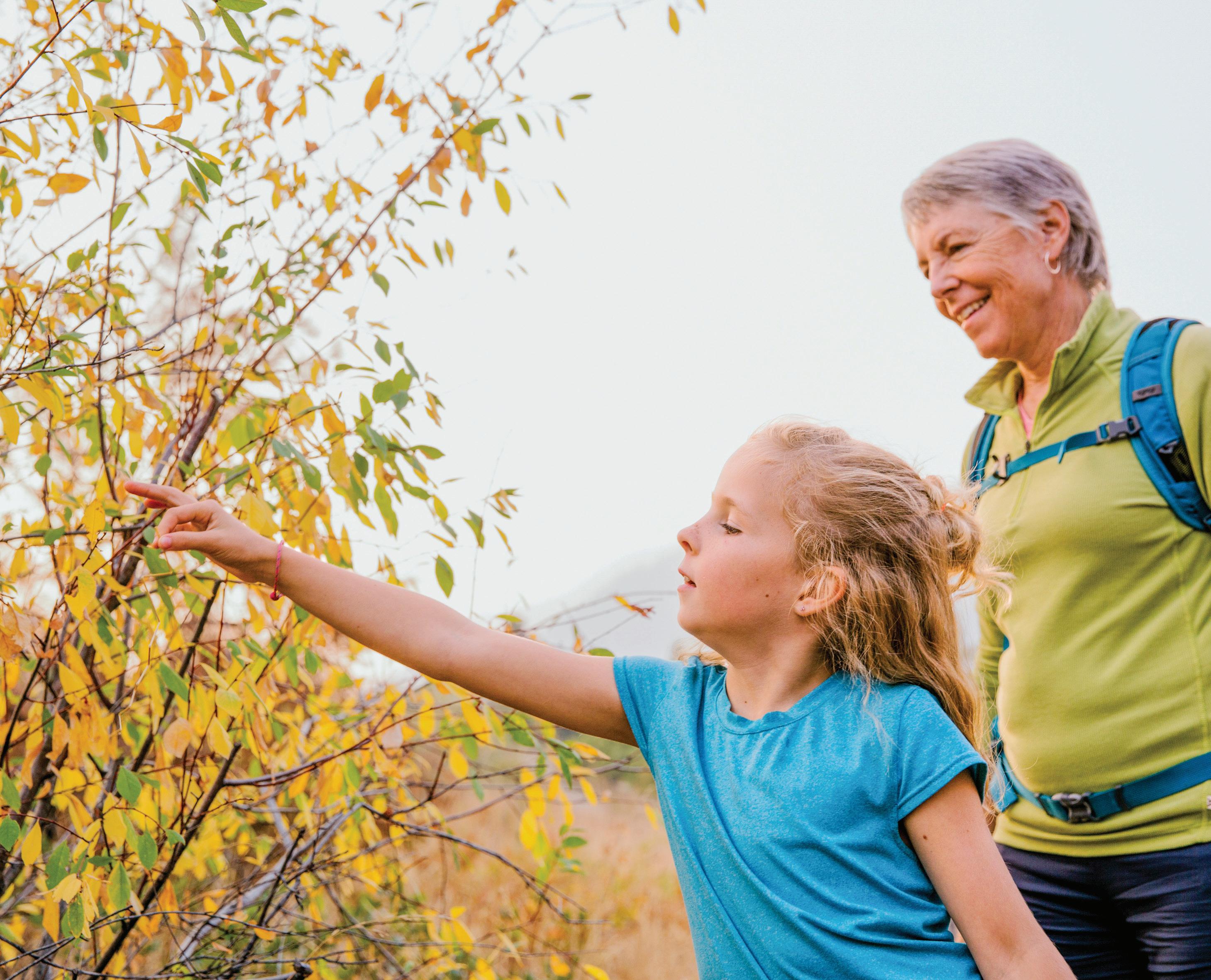
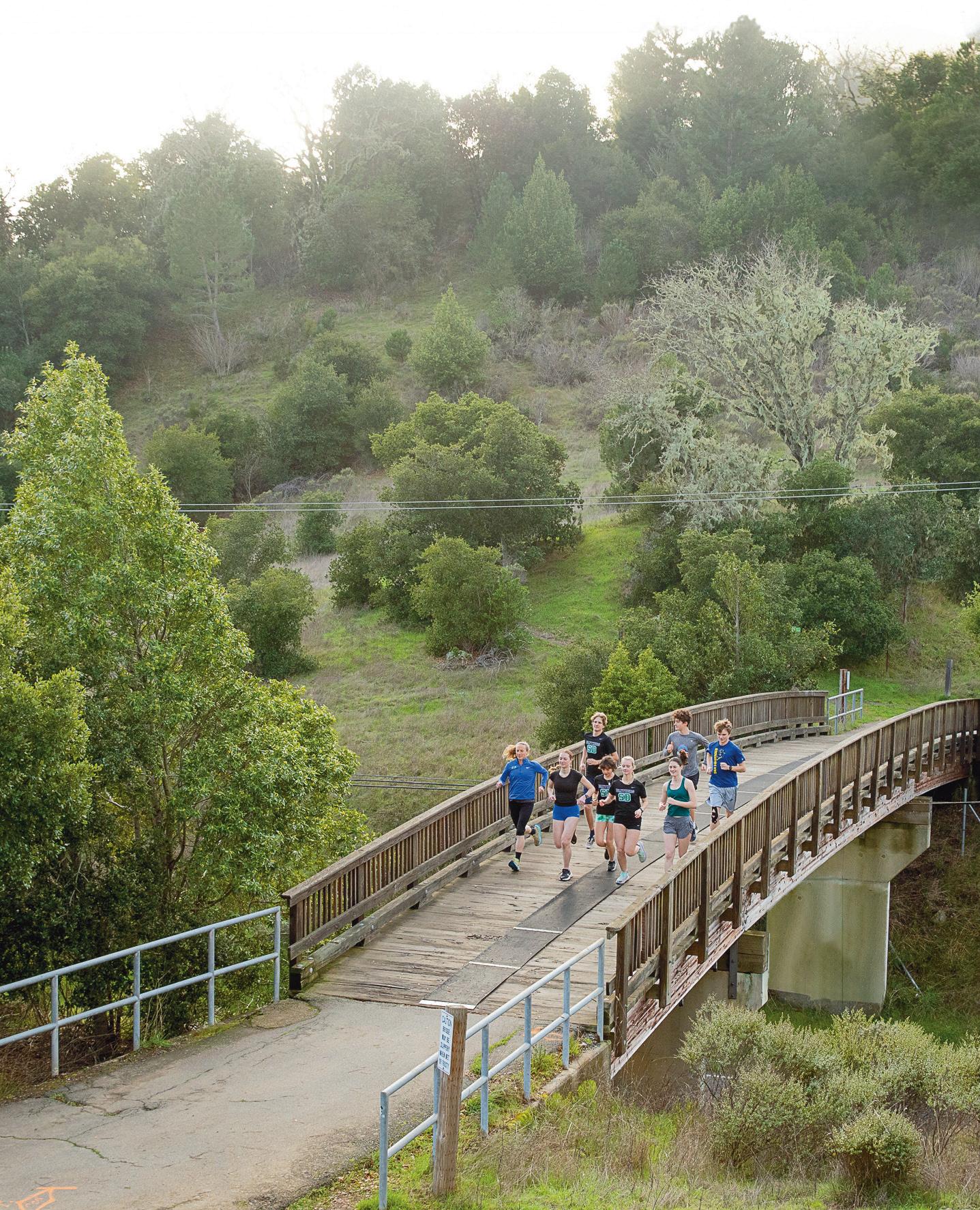
Since its transition from golf course to public green space, San Geronimo Commons has become a beloved setting for the community, including runners from the nearby San Domenico School, who enjoy the rolling terrain and beautiful scenery.
In California, communities and partners are working with Trust for Public Land to turn former golf courses into resilient, biodiverse sanctuaries where wildlife can thrive and more people can connect with nature.By Amy McCullough
In the snug, emerald valley of San Geronimo, California, three words mark a paved trail in thick white chalk: “You’ve got this!” Written by the coach of a local high school cross-country team, the message was meant to encourage runners during a recent race. But it’s indicative of much more. It reflects the positive attitude and proactive manner of a community that’s working together to meet the challenges of climate change.
The 157-acre site where these words appear, once an 18-hole golf course, has been undergoing a transformation since 2018, when Trust for Public Land bought it and began working with residents to best realize its next iteration as a community asset. Soon after, irrigation stopped, and a grand and complex effort to restore the landscape began. And in the months and years to follow, people started visiting the site for a wide variety of uses.
San Geronimo Commons, as this public space is now known, is one of three former privately owned golf courses TPL is helping reimagine along the California coast—an area plagued in recent years by extreme heat and devastating weather events such as floods and wildfires. Marin County Fire Chief Jason Weber puts it bluntly, “It seems like a year-round business of disasters,” he says. “It has certainly changed in the last 10 years. You can’t say ‘the new norm’ anymore. It’s really just the normal.”
That reality is why communities are partnering with TPL to make the most of their landscapes—and gaining a host of benefits for wildlife and people in the process.
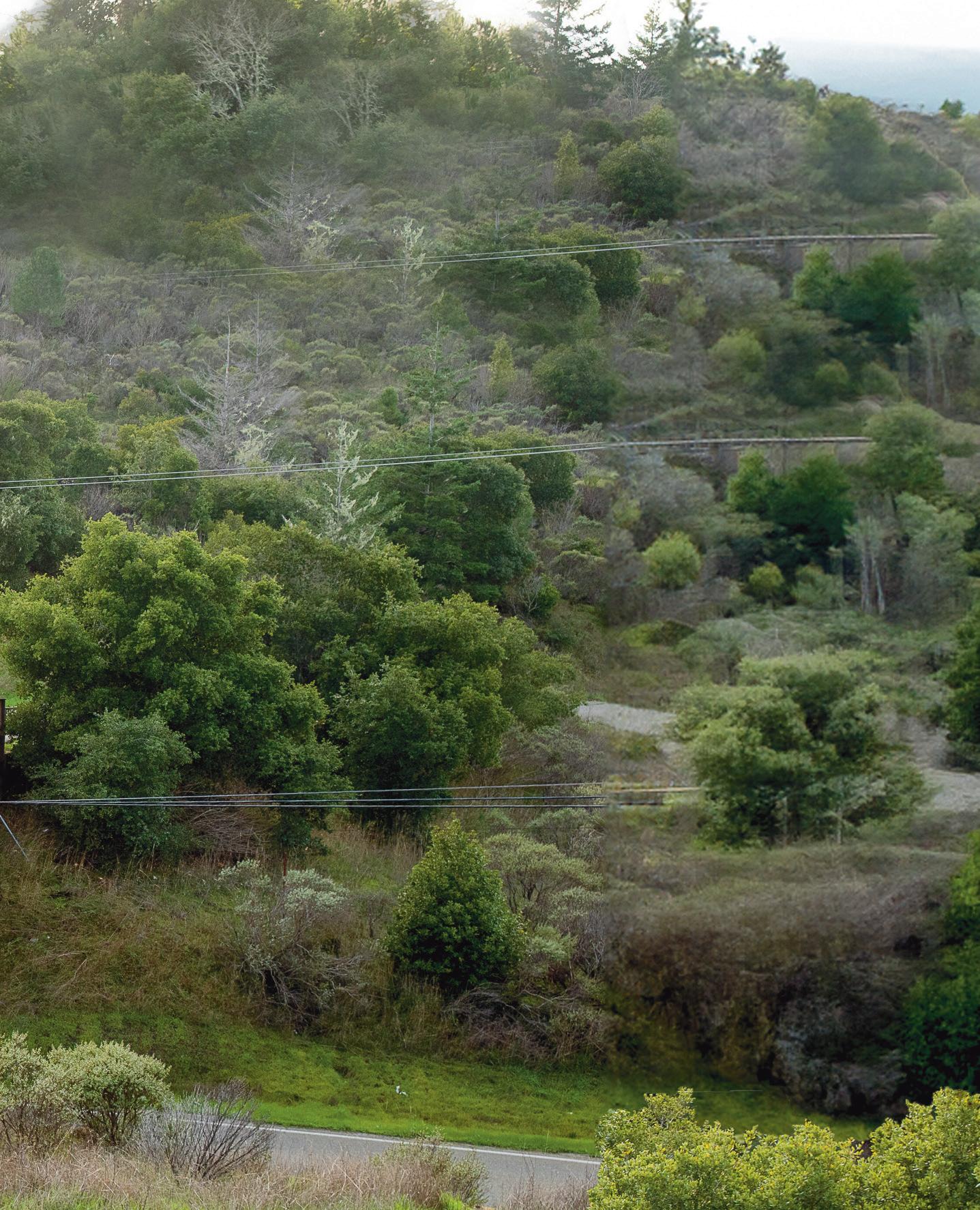

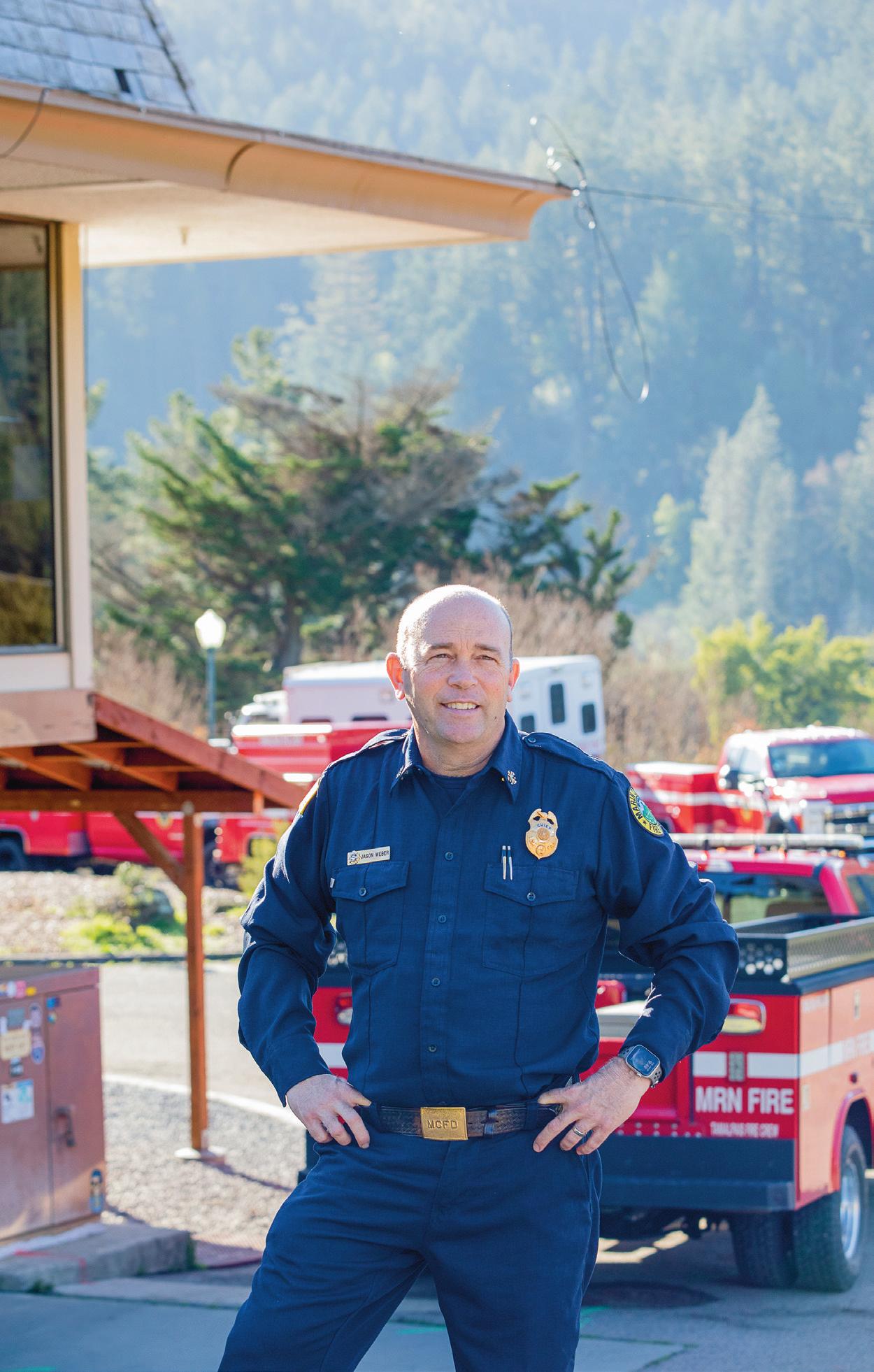
Mary Churchill, the aforementioned cross-country coach, says training at San Geronimo Commons (SGC) has provided her team with an enhanced appreciation for nature and a connection to their community. “Students see an area being used by the public, their neighbors, their classmates, and shared with animals,” she explains. “They are also aware that we work in collaboration with the fire department to use the area.”
She’s referring to Chief Weber and his staff, who have turned the former golf course clubhouse into the Marin County Fire Department’s administrative headquarters. Weber, a strong advocate for the restoration project, says the new natural area is in alignment with Marin’s vision, noting that more than 50 percent of land in the county is preserved for open space.
“The community saw pretty early on the value of the property for public use and public safety.”
– MARIN COUNTY FIRE CHIEF JASON WEBER
He sees an added bonus, since the fire department will be more centrally positioned than in their previous headquarters, greatly improving response times, which is more important than ever for this region. “The community saw pretty early on the value of the property for public use and public safety,” Weber observes. He’s glad the fire station is at a local nexus too: “The community gathers here pretty regularly,” he says, citing a weekly food pantry, track meets, cycling events, even a recent car show. “Everyone’s finding so many uses for the property as a commons, and it’s good for us to interact.”
Churchill, who teaches biology in addition to coaching, says SGC “has everything: hills, trails, vistas, and great parking,” adding that it’s not only beautiful but also feels safe. Her student athletes agree. George Kunze, a graduating senior, describes the site as “a pleasant, secluded area to train and race in where I’ve made a lot of valuable memories.”
Of course, not everyone was on board. Alexa Davidson, a lifelong resident of the area and executive director of the nearby San Geronimo Valley Community Center, says there was a sense of real loss for people who had used the space as a golf course. Homeowners who’d grown accustomed to having a manicured golf course outside their doors are also adjusting.
Davidson and other local leaders embraced the community engagement process and saw the site’s evolution as a time to do a lot of listening. They focused on being good neighbors, asking, “How can we support each other?” And as residents enjoy more regular access to the land for walking and recreation—and the broader community sees new possibilities at the property—attitudes are shifting.
Erica Williams, a senior project manager at TPL, says community engagement efforts and transparency about the process, including a monthly newsletter, helped assuage some concerns. The pandemic also played a role: “It represented a paradigm shift,” she says, “with property users reaching out to express their gratitude for the land and deep appreciation for its natural beauty, easy access, and trails.” Many neighbors have since come forth as land stewards, offering to help however they can: “They really are very in touch with the land and care about it,” says Williams. “We’re not philosophically opposed to golf,” she adds. “There was just an incredible restoration opportunity that also had a lot of community benefits.”
The acquisition also connected San Geronimo Commons to four adjacent green spaces: Roy’s Redwoods, Gary Giacomini Open Space Preserve, Maurice Thorner Memorial Preserve, and French Ranch Preserve. That connectivity not only expands recreational opportunities for the public; it also improves wildlife habitat, enhancing the region’s biodiversity and climate resilience at once.
A return to native plants is part of that resilience. Restoring the region’s natural grasslands will help mitigate climate change, as their deep root systems hold carbon, reducing the amount of greenhouse gases released into the atmosphere. And reconnecting waterways to the floodplain will create a moister landscape that is resilient to fire. “That’s where the restoration piece is really important as a climate benefit,” says Williams.
Chief Weber agrees: “We’ve been able to prove that this space can be used for public access, along with fire protection.”
Current community uses for the site include a food pantry (right), where an estimated 750 individuals receive groceries each week.
Coach Mary Churchill (below, in blue) and runners from the nearby San Domenico School regularly train on site.


In Marin County hotel bathrooms, prominent signs recommend keeping shower durations to five minutes or less in the name of water conservation. A rest area near Salinas displays a similar “every drop counts” message on a placard near the vending machines. Clearly, this is a state with water issues— and a population concerned about usage.
“Certainly, from the standpoint of water conservation, that’s a very glaring example of how this work is beneficial,” says Williams. Removing fertilizer and pesticide from stormwater runoff is another collateral benefit of transitioning golf courses to natural landscapes. In addition to being better for residents, cleaner water is hugely important to fish populations.
Anna Halligan of Trout Unlimited (TU), a national nonprofit and important TPL partner on the SGC project, explains how the watershed restoration will benefit both endangered coho salmon and threatened steelhead trout: “One thing that we know is really beneficial for fish is reconnecting the stream
channel with floodplains,” she says, which is what TU is helping achieve in the San Geronimo Valley. For other wildlife, too, such as birds, insects, amphibians, and mammals, “there’s this really great opportunity to create seasonal wetlands.”
The golf course had previously covered—literally, with dirt—much of Larsen Creek and directed its water into a holding pond, which was then used for irrigation. Now, TPL and Trout Unlimited are redesigning the landscape to hold water for as long as possible, which will protect the community from natural disasters.
A restored, naturally functioning floodplain means a more saturated water table, increased fire resilience, and better flood protection. “We want to have that buffer for those big weather events,” says Halligan, noting that natural streams allow fish refuge from strong storm flows, “so it’s not all just rushing downstream.”
Another aspect of the project will specifically benefit coho salmon. “There’s a limit to how far they can get upstream right now,” says Halligan, TU’s north coast coho project director.
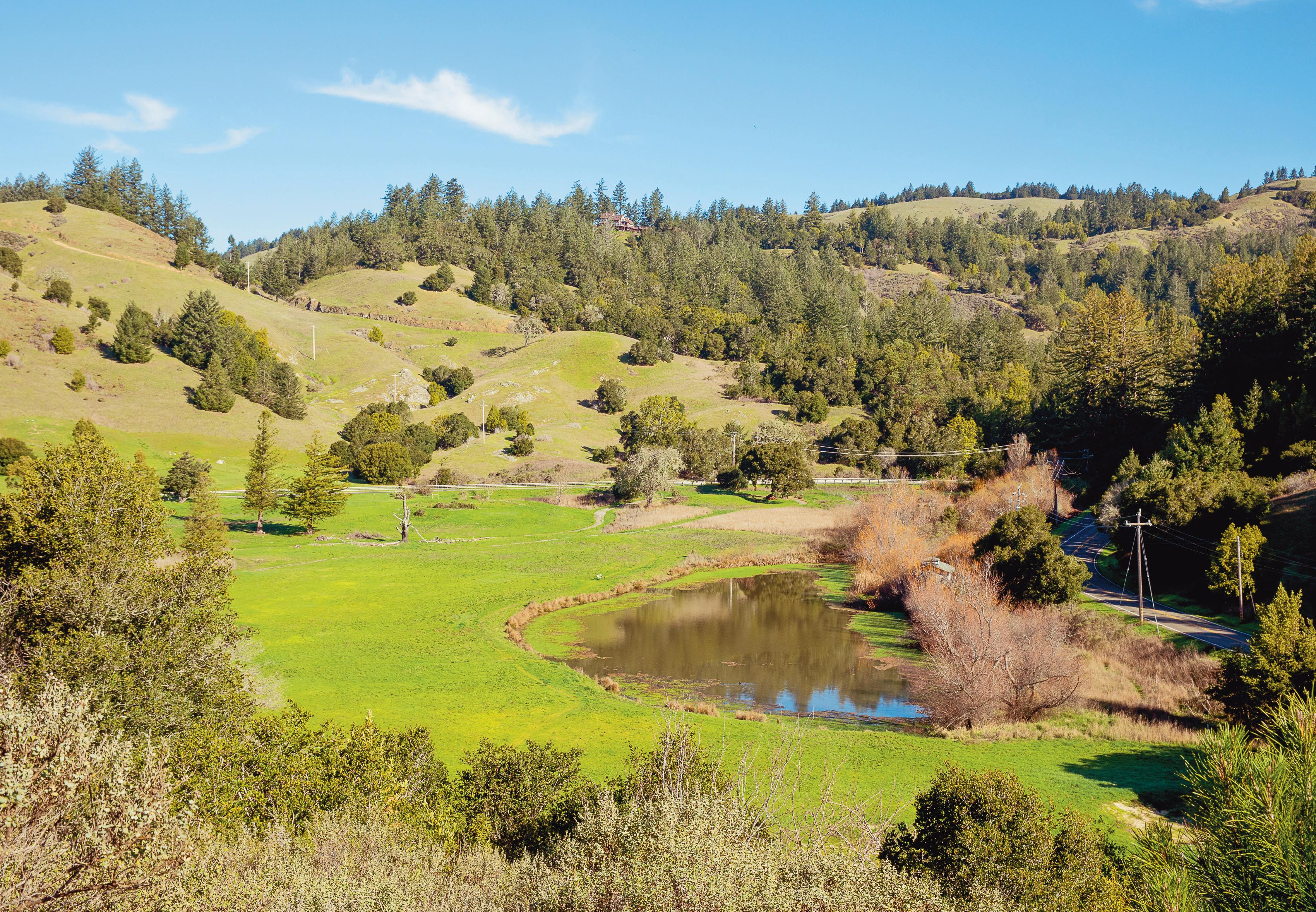
San Geronimo Creek, one of the waterways that runs through the property, provides roughly 40 percent of the available coho spawning habitat in the entire Lagunitas Creek watershed, and TU is working with TPL to restore this creek, maximizing the Bay Area’s largest remaining coho salmon run.
California has committed to the goal of conserving 30 percent of its lands and coastal waters by 2030, known as the 30x30 initiative. The transformation at San Geronimo Commons “checks that box right out of the gate” Halligan notes— as do TPL’s other golf course restoration projects in the Golden State, all of which support climate resilience.
As TPL Climate Director Brendan Shane puts it, “While each location is unique, these large sites provide amazing opportunities for each community to address climate risks. The same restored natural landscapes that improve habitat, biodiversity, and water quality can buffer against coastal storms, manage extreme precipitation, and recharge groundwater supplies. These restored public landscapes also capture and store carbon in their forests, wetlands, and soils—helping address the root cause of climate change.”
“These large sites provide amazing opportunities for each community to address climate risks.”
– TPL CLIMATE DIRECTOR BRENDAN SHANE
About 150 miles down the coast, Tim Frahm, also with Trout Unlimited, leans over a bridge and joyfully points out a juvenile steelhead trout in the Carmel River.
Here, the Monterey Peninsula Regional Park District (MPRPD), Trust for Public Land, and TU are partnering with the California State Coastal Conservancy and others on an ambitious riparian (riverside) restoration that will improve 40 acres of habitat along 1 mile of the river.
Formerly Rancho Cañada, a 36-hole golf course, the land was purchased by TPL and granted to MPRPD, who—like the Marin County Fire Department—moved their headquarters to the clubhouse, even converting the prior pro shop into a Discovery Center focused on environmental and cultural education. The golf course property adds a 185-acre parcel to Palo Corona Regional Park, a significant open space on California’s
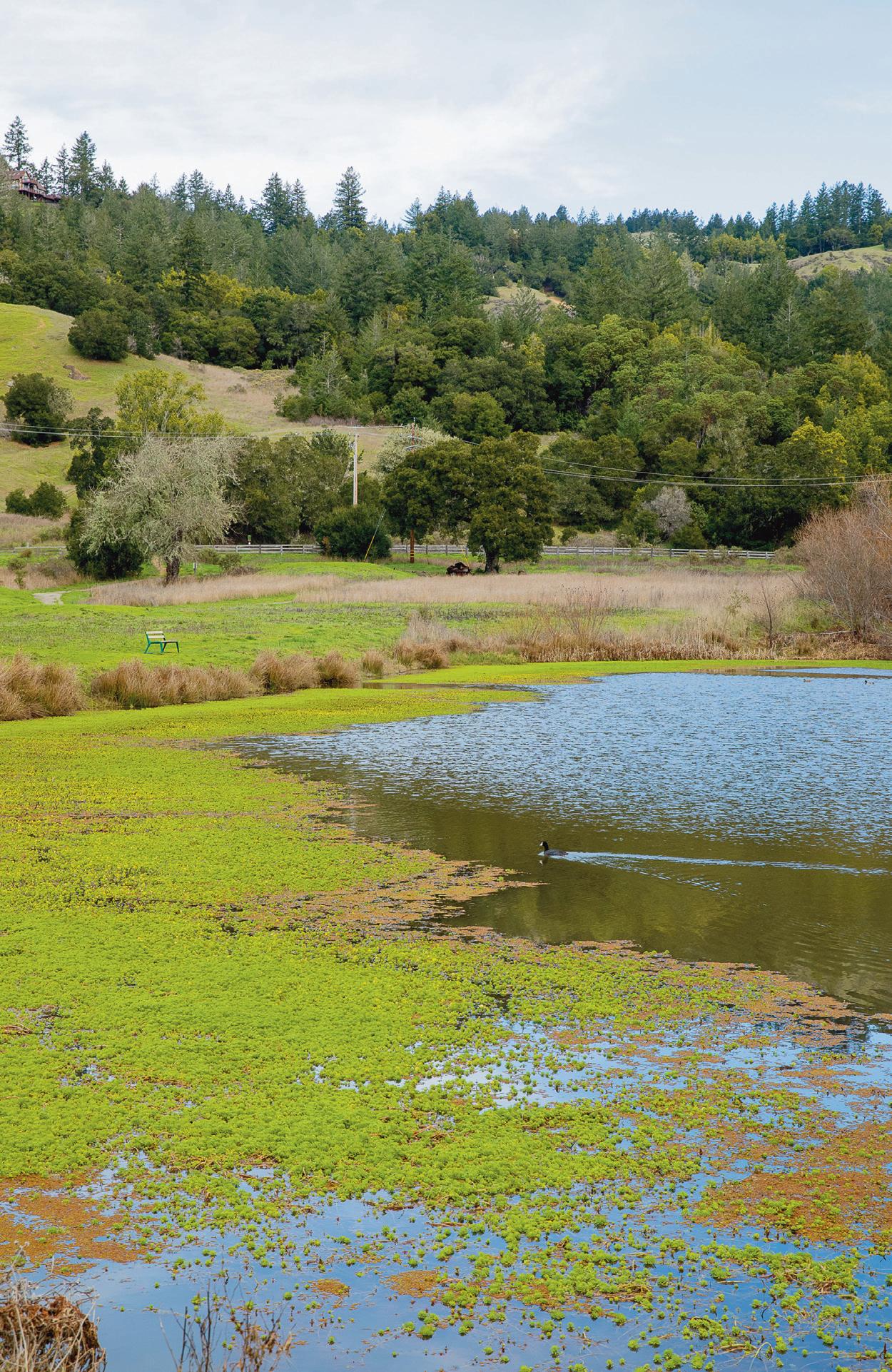
Trout Unlimited is working with TPL to restore Larsen Meadow (above and opposite) and other parts of the Lagunitas Creek watershed to support wildlife such as coho salmon.
central coast. And the transition will heal the landscape from prior damage, help prevent flooding, and provide new opportunities for recreation.
Christy Fischer, TPL’s conservation director for coastal Northern California, describes the project as “stunningly successful”: stunning because it very easily could not have happened. Previously the executive director at the Santa Lucia Conservancy, Fischer and MPRPD General Manager Dr. Rafael Payan each heard about the possibility of the golf course purchase on the same day—and both reached out to contacts at Trust for Public Land, knowing we’d have the expertise to help.
Facing competition from developers for both the land and the water, the groups needed to move quickly. They had a mere two and a half weeks to get under contract on the property—including a $100,000 deposit. That was before the challenge of raising an almost $11 million purchase price in 12 months. It seemed impossible, but TPL marshaled the resources necessary to quickly close the deal. And “off to the races we went,” says Payan.
Rethinking the resource of the Carmel River—which had previously provided irrigation to the golf course—was key, says Fischer. Frahm, who serves as TU’s central coast steelhead project manager (and happens to be Fischer’s husband), realized there was an opportunity to dedicate the irrigation water back to the river, enhancing its natural flow to the benefit of fish and other wildlife. A healthier, more natural Carmel River also means better resilience to the effects of climate change and cleaner drinking water for surrounding communities.
Much like the quest for funding, the proposed floodplain restoration at the former Rancho Cañada site requires plenty of creativity—not to mention flexibility.
“This is going to be a process-based restoration, where we create the footprint; we provide revegetation; but then the river is going to start carving her own locations,” says Frahm. Designs of this type used to attempt to keep rivers structurally in the same place, he explains. “Happily, we’ve evolved away from that.”
Frahm consistently refers to the river as “she” and “her”— an affectionate habit that reveals his close relationship with the landscape. Jake Smith, MPRPD’s planning and conservation program manager, describes the site with a similar rapture. When recommending the hike to Inspiration Point— which provides a bird’s-eye view of Carmel Bay—he advises planning in plenty of time for “blissing out” at the top.
And he’s similarly excited about discussing the forthcoming restoration, which is where the creativity comes in. The restoration team had to come up with new ways to allow the river to meander since they weren’t starting with a blank slate, given considerations such as nearby homes, existing roads, and the park next door.
They also had to remedy issues caused by the landscape’s former use as a golf course. That includes cutting away earth to lower the floodplain, dropping it as much as 15 feet in places.

Bringing the landscape down to the water table will create an accessible, drought-resistant water source for wildlife and provide greater capacity during storms—including an increased ability to capture and retain sediment—which is important to climate resilience.
Smith adds that a “nice wide, wet, intact riparian corridor also has the potential to buffer a lot of the negative effects of fire.” In other words, a healthy river and functioning floodplain mean better protection from wildfires. If a fire starts on one side of the Carmel River, for instance, a saturated landscape could help keep it from spreading to the other side.
The restored Rancho Cañada property will, in effect, act as “a kind of Swiss Army Knife to really mitigate a lot of climate change impacts and increase our capacity to adapt or respond to those events,” says Smith. This is great news for local communities, as flooding and wildfires are both top of mind for residents in California.
Much of the removed earth will be mounded in a manner that’s “sympathetic with the landscape,” according to Frahm, meaning the restoration aims to re-create a natural topography. The project team is also carefully considering the needs of wildlife, removing invasive species and adding native veg-
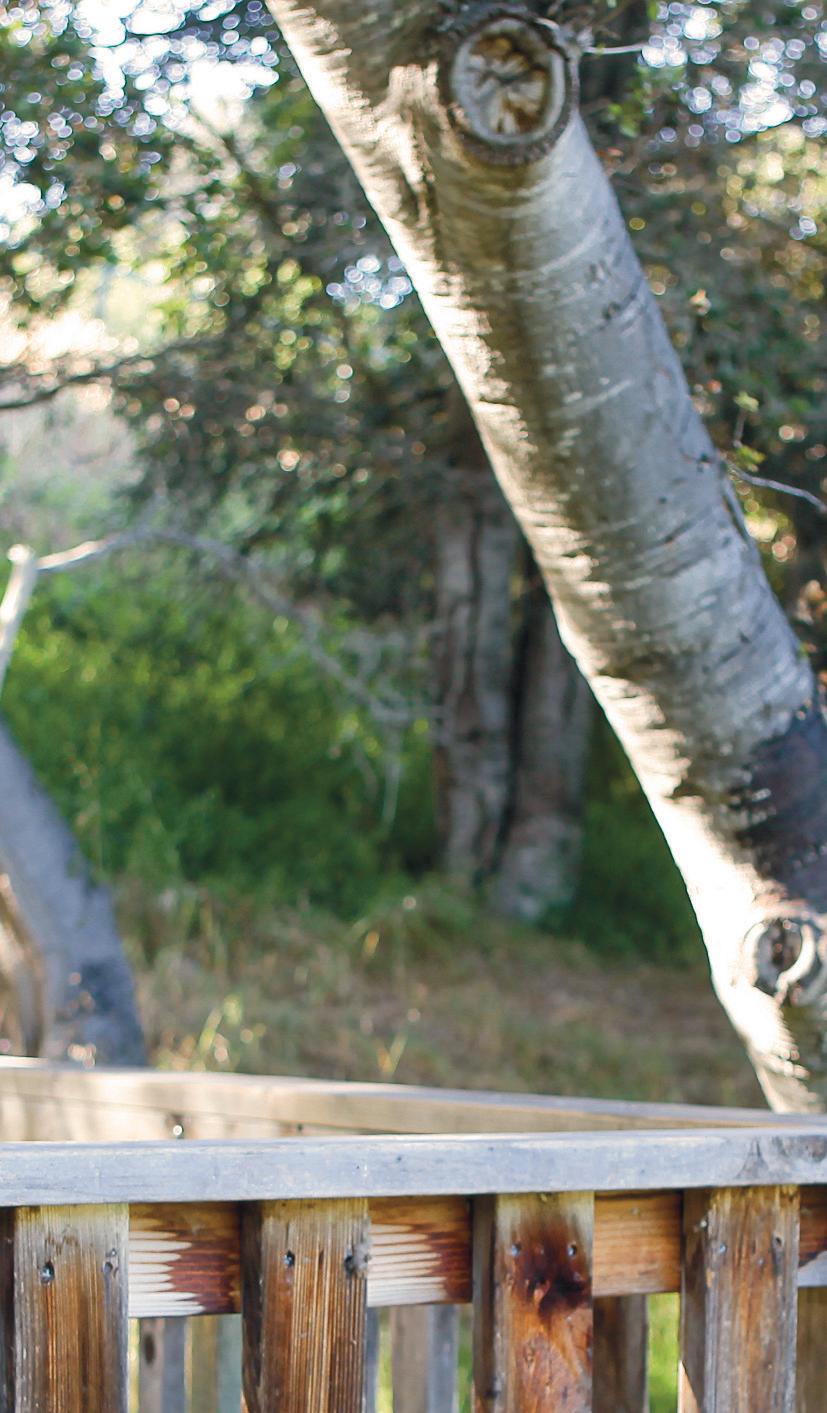
“One of our driving motivators, like TPL, is to reach and provide services to underserved, underrepresented, and under-resourced communities.”
– DR. RAFAEL PAYAN, MONTEREY PENINSULA REGIONAL PARK DISTRICT GENERAL MANAGER
Dr. Rafael Payan (opposite) and the Monterey Peninsula Regional Park District are partnering with TPL and Trout Unlimited to maximize water quality, steelhead trout habitat, and flood safety of the Carmel River (inset).
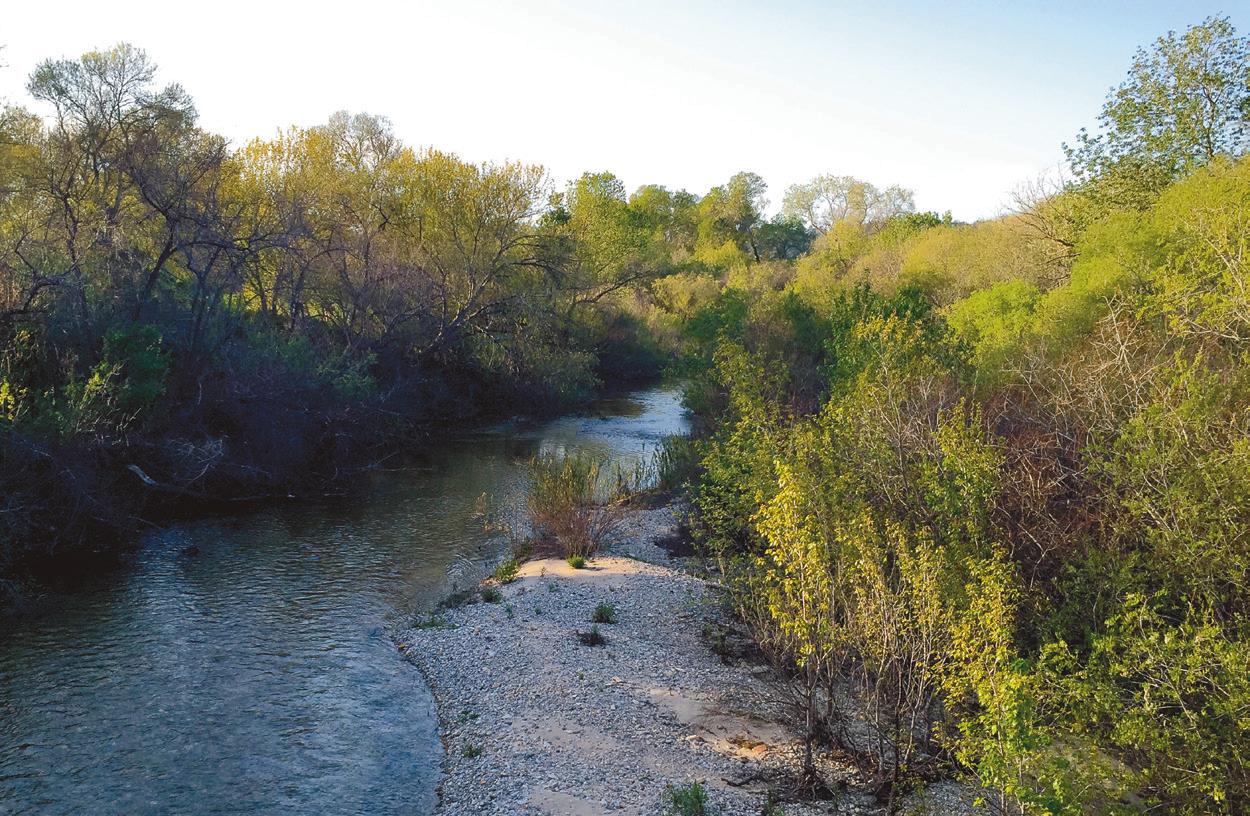
etation for a healthier ecosystem with improved refuge and new food sources.
Like San Geronimo Commons, Rancho Cañada fills a missing piece in a checkerboard of conserved land, in this case between Los Padres National Forest along the Big Sur coast north to Fort Ord National Monument near Monterey. Smith sees such connectivity as providing wildlife with a “pressurerelease valve,” allowing species access to more habitat if theirs is adversely impacted by an event like wildfire. He mentions black bears as one animal that has endured challenging circumstances by taking advantage of such openings.
Humans take advantage of new routes into nature, as well. Already, visitors can be seen walking dogs at the former Rancho Cañada site, pushing strollers along former golf cart paths, and generally enjoying the property—even though it’s
just getting started. Some parts are open now but will close during upcoming phases of construction, while other areas that are currently closed will open. “We’re designing it to maintain access,” says Smith, noting that its final design will strive to serve all ages and mobilities.
Payan is likewise concerned with equity and accessibility. “One of our driving motivators, like TPL, is to reach and provide services to underserved, underrepresented, and under-resourced communities,” he says. He hopes the park will become a beloved natural area to all in the region, from the Salinas Valley’s agricultural workforce and their families to elderly residents from nearby retirement communities to members of local Indigenous groups.
Payan, who is of San Carlos Apache and Mexican descent, is also interested in preserving local cultures and educating users of the park through interpretive signage and educational programming. He says the community overall has been very supportive, and keeping residents informed of the project’s progress and benefits is one of his primary goals.
“It’s easy to see what resonates with people when you start ticking off all the things that this multibenefit project does,” adds Frahm. “Reducing flood risk for the retirement community living upstream? That’s a big deal. Protecting a domestic water source? That’s a big deal. Creating a favorable, stable environment for threatened steelhead trout and other wildlife? That’s a big deal.” And while partners like the MPRPD, Trout Unlimited, and the California State Coastal Conservancy are invaluable to seeing it through, all agree this is truly an “if not for TPL” project.
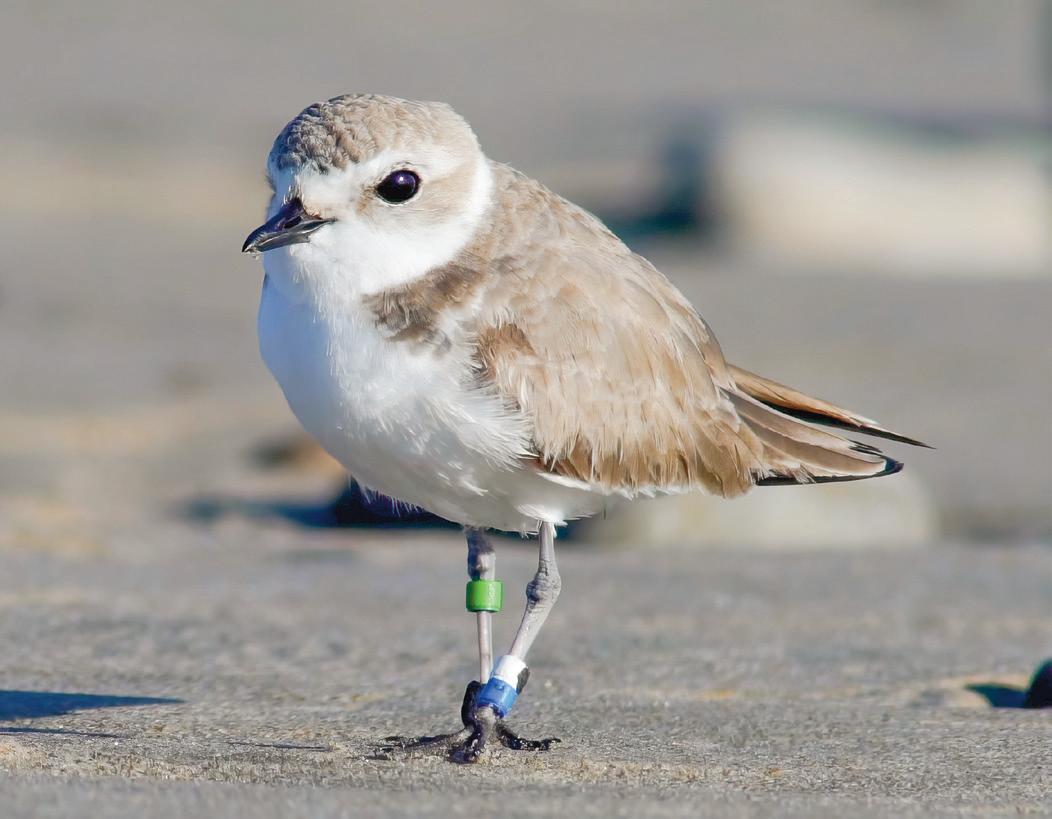


Decisions about the restoration at NCOS, led by Dr. Lisa Stratton (above right), are made to optimize habitat for a variety of wildlife, including western snowy plovers, tidewater gobies, and Baja California tree frogs (from top to bottom).

It takes all of two minutes on a trail with Dr. Lisa Stratton, director of ecosystem management at the University of California Santa Barbara’s Cheadle Center for Biodiversity and Ecological Restoration, to see the strength of community at North Campus Open Space (NCOS). This is where TPL secured 64 acres of a former golf course for a wetland restoration that is benefiting residents—including students of all ages—and endangered shorebirds.
Stratton, who showed up on a bicycle and with a backpack full of aerial site images, sees a familiar face and shouts, “Hi, Jim!” at a birder passing by. “Hi, Greg!” and “Hey, Jeremiah!” are soon to follow, and each interaction focuses on birds, from American bitterns and black-crested night herons to killdeer, sandpipers, and pipits.
Jim, who’s carrying a large scope, is on his way to (hopefully) view a horned lark, causing Stratton to exclaim, “Oh!
I gotta see that. That’s a new bird for us. Cool.” Jeremiah, encountered a bit later, explains that the lark is a juvenile so not as recognizable, or so he’s heard on the birding grapevine.
Stratton is overseeing the restoration at North Campus Open Space—which ceased being Ocean Meadows Golf Course in 2013, broke ground in 2017, and fully opened to the public in 2022—and is the property’s biggest ambassador, according to Alex Size, TPL conservation director for Southern California.
Indeed, it’s not uncommon to hear her described as a force of nature—or, rather, a force for it. As Mark Holmgren, former curator of the Cheadle Center’s vertebrate collections, puts it, “Lisa is a unique person, able to blast ahead and ignore obstacles that hold normal humans back.”
Though retired from UCSB, Holmgren has continued working closely with Stratton as a member of the local Audubon chapter’s science and conservation committee. “We take on issues locally that are meaningful to birds,” he says, which has led to many discussions about how to best restore the NCOS site, located on Devereux Slough, to provide for shorebirds at risk of losing habitat due to climate change.
Western snowy plovers are one example; Belding’s Savannah sparrow is another. The former breed on sandy shores, using beach material to build nests. The latter is a wetlanddependent species that resides in Southern California’s coastal salt marshes year-round.
Holmgren began conducting bird surveys at the property in 2011, when it was still a golf course—and while, in fact, he was simultaneously golfing. “We were having so much fun watching birds that we gradually weened ourselves off the golf,” he says with a chuckle. Data shows that the restoration has, without a doubt, improved bird diversity. “We have more variation in habitats,” he observes. “Now we have freshwater riparian, salt marsh, grassland, coastal sage scrub, and vernal pool habitats”—all of which also serve other wildlife.
Beaming from under a bucket hat, he reports that the beach at Devereux Slough has the largest population in the county of breeding western snowy plovers; more than 60 nests have been recorded annually. Belding’s Savannah sparrows have also been documented breeding on-site.
“Another thing we’re really proud of,” says Stratton, “is that we have two populations of federally endangered plants here”: Ventura marsh milkvetch and salt marsh bird’s beak. It’s not just about putting native plants in the ground, she says. It’s about asking, “How can we create these unique ecological niches for different organisms?”
And, as with the other former golf courses, NCOS connects with adjacent natural areas—such as Ellwood Mesa, a 137-acre overwintering site for monarch butterflies that TPL and partners protected in 2005—linking more than 600 acres of land. “The connections are as important as the open spaces themselves,” comments Holmgren. “Because if one area is hit by fire or disease or some other kind of calamity, wildlife needs those corridors to quickly recolonize.”
In 1965, developers added an estimated 500,000 cubic yards of soil to Devereux Slough to create the nine-hole course, essentially covering up a natural estuary. Once TPL bought the land and conveyed it to UCSB, removing and rethinking some of that fill was an early step in planning North Campus Open Space.
Stratton says they excavated 350,000 cubic yards of earth, likening the effort to a ballet of machine operators. Nearby residents—many of whom are university faculty—were mostly very supportive of the changes, she says. In recent years, new arrivals have even told her they moved here because of the project.
“But,” she continues, “the public had to psychologically conceive of the change. Guiding that change and communicating [about it] was more of a nuanced challenge.”
Both Holmgren and Stratton credit the project’s genesis, in part, to Duncan Mellichamp, an emeritus professor of chemical engineering at UCSB and a onetime member of TPL’s California Advisory Board. “He realized this is part of what institutions can do: preserve open space and manage it,” says Holmgren. “It has created a fabulous perception in the community.”
“Thanks to you guys and other groups,” adds Stratton, “there was bond money available.” By “you guys,” she means TPL—specifically our expertise and leadership in supporting environmental ballot measures, which can result in important funding for projects like hers. Rachel Couch, a project development specialist with the California State Coastal Conservancy who worked on both Rancho Cañada and North Campus Open Space, describes it this way: “Everyone wanted to be a part of such a cool idea to undo the damage that the golf course had done to this coastal watershed.”

Horned larks are one of many bird species to visit NCOS.
Stratton identifies several climate benefits tied to the restoration, which is ongoing, but points to one very convincing piece of evidence: “All these people don’t have to buy flood insurance anymore,” she says, gesturing to a line of houses adjacent to NCOS. “We dropped flood elevations by a foot and a half, which took all these people out of the danger zone.” While protecting nearby communities, they also designed the wetland so it can become tidal for longer during rain events, knowing that as sea levels rise, such topographical changes will protect the salt marsh habitat. Much like the floodplain restoration at Rancho Cañada, it does this by lower-
“All these people don’t have to buy flood insurance anymore.”
–
ing water levels. “Instead of being bermed behind a sandbar,” says Stratton, “it becomes tidal, which drops the water level by about 5 feet.” Couch puts it more simply: “It basically just provides more room for the water to go.”
Guillermo Rodriguez, TPL’s California state director, says these projects “bring critical green infrastructure to landscapes and communities that need it, with benefits ranging from increased public access and flood control to reviving critical habitats.”
He notes that TPL is also providing technical assistance to a local land trust in Palm Springs, where three contiguous former golf courses will be developed into a nature preserve.
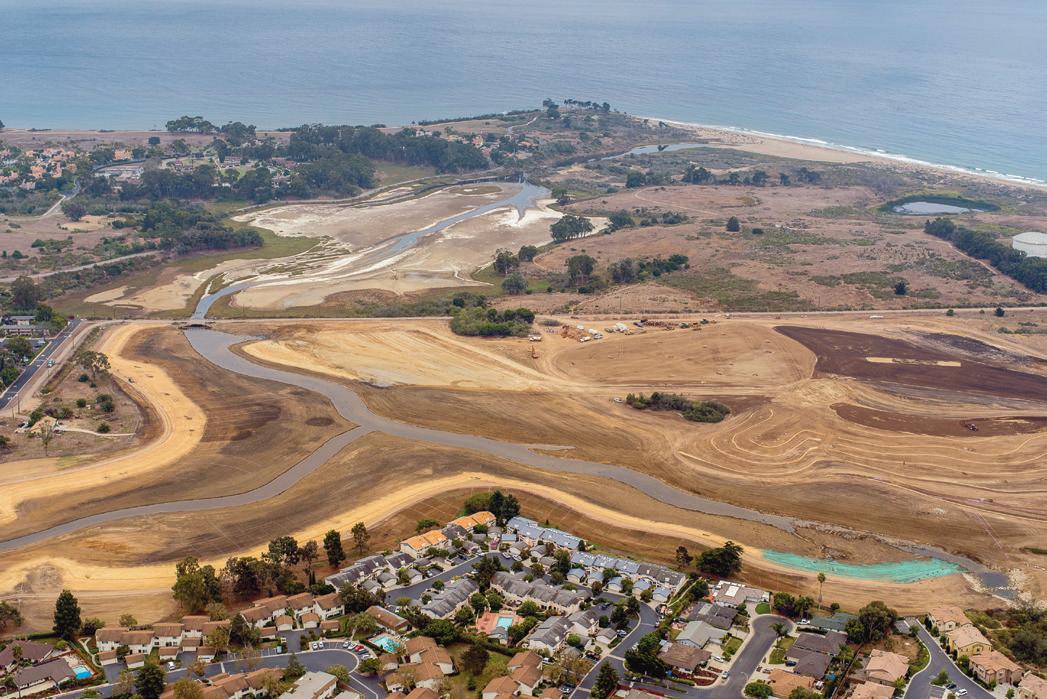

North Campus Open Space during restoration (inset) and recently (opposite), showing much-improved water capacity. Planting native species such as purple sage (right) was an important part of returning the NCOS landscape to a natural state.
All of this intentional, thoughtful design is why Stratton uses the term “rewilding” with caution, noting it can give the impression of letting something go, with little to no management. “We’re making conscious decisions,” she says, which is true of each of these former golf course sites.
TPL’s Christy Fischer makes a similar point, noting that “golf courses left to their own devices go to hell in a handbasket really quickly,” typically with invasive species running rampant. In essence, deliberate effort, planning, and cooperation are needed to best serve wildlife and people.
Plus, we can’t truly go back to a pristine, “wild” state. From agriculture and ranching to golf courses and development, people have been affecting these landscapes for centuries. What we can do is learn from the past and strive for healthy, functioning ecosystems moving forward. In Holmgren’s words, “History informs restoration, but it doesn’t necessarily dictate restoration.”
The educational aspect is key. Exposure to restored landscapes teaches such ecological lessons, and there are plenty of students who will benefit, from children at Lagunitas Elementary School and West Marin Montessori Preschool near San Geronimo Commons to attendees at environmental education programs led by the Santa Lucia Conservancy at Rancho Cañada—and certainly by college students at UC Santa Barbara. “Doing this through the university has been special beyond what we ever anticipated,” Holmgren remarks.
Stratton agrees: “Being on campus is our biggest asset. We are a place with 5,000 new students every year. They’re out here collecting data; they’re getting that field experience.” It’s become a living laboratory that’s engaging students who are otherwise often divorced from the land around them. “There are about 30 classes that use the space in some way,” says Stratton—“not just ecology and biology, but also writing courses, anthropology, field trips.”
The site also serves as a route for Isla Vista Elementary School students, who bike through NCOS on their way to
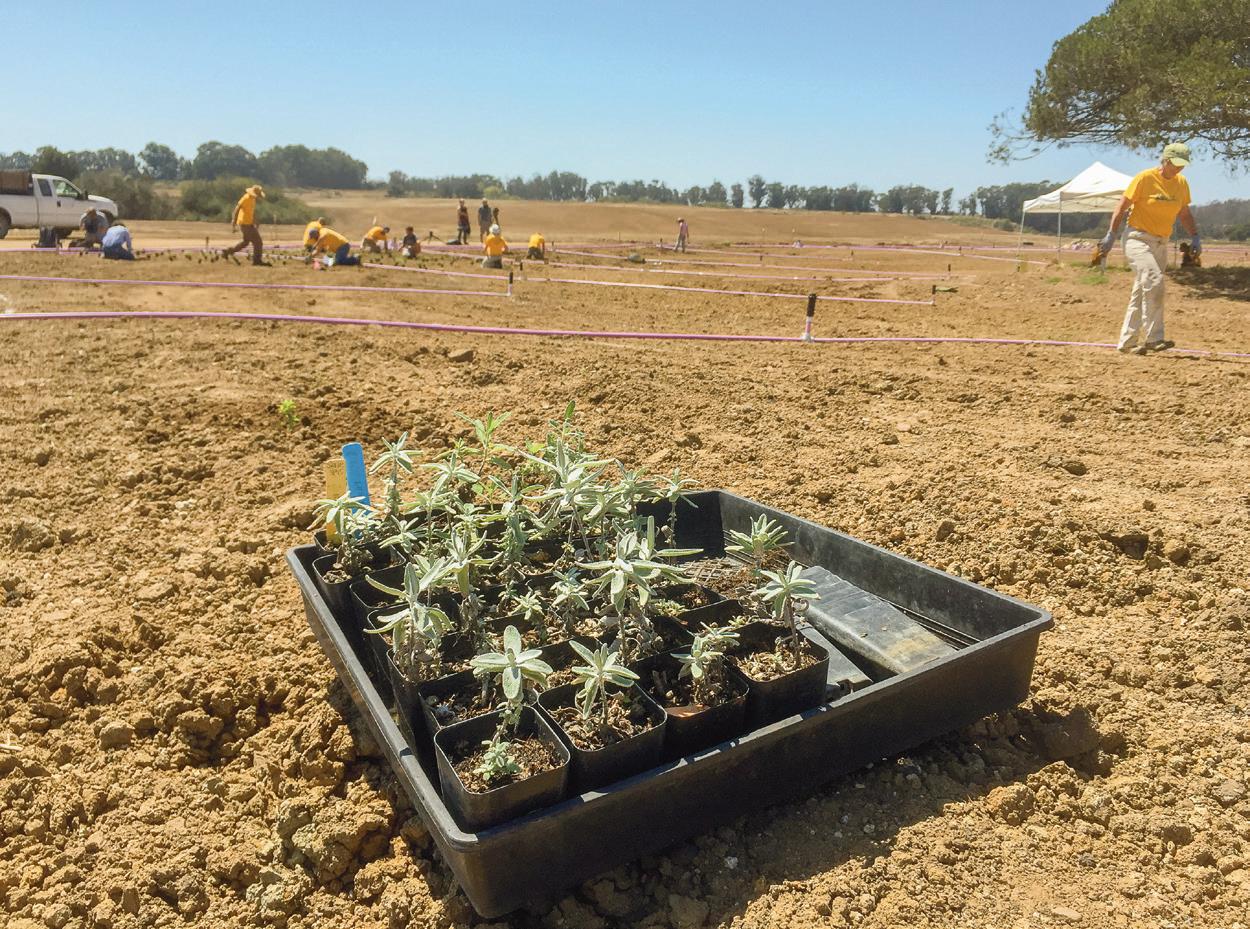
school each morning. And there are two nearby preschools that use the site for outdoor education, even helping plant native species and watching them grow.
UC Santa Barbara is also working with members of the local Chumash community to raise awareness about Indigenous land management, such as controlled fire. “Cultural burning was a really important practice here,” says Stratton, who conducted a burn in partnership with the Chumash in fall 2023. “We want to bring back their practices and help highlight how sustainable they are while educating people and engaging the community in their value and importance.”
When asked about her favorite use of the site, Stratton pauses, then says, “I think birding is really cool because there are new discoveries all the time, but I’m really proud that it’s used for all this different education.”
And she’s particularly moved by the experience of her own students. “They go into this environmental studies program, and all they hear about is disaster,” she says. But many have told her that working on the NCOS restoration made them feel something unfamiliar: hope. “This made them feel like they made a difference.”
It’s a feeling that recalls those three encouraging words written by the cross-country coach: You’ve got this. When it comes to fighting climate change, we do have this—we can, that is, if we work together to conserve land with resilience in mind.
See page 58 for reading and viewing recommendations from community members and partners in this story. For more on birding, turn to page 14.
Amy McCullough is senior writer and editor for Trust for Public Land and managing editor of Land&People magazine. She is also the author of The Box Wine Sailors, an adventure memoir.
From Manhattan to Montauk, Trust for Public Land’s Long Island Greenway will fill a major gap in a statewide corridor for hiking and biking while supporting local economies, combatting climate change, and connecting 27 communities to the outdoors.
By Bradford McKee · Photos by Tara Riceproposed off-road alternative off-road proposed on-road alternative on-road existing on-road existing off-road
The first 25-mile section of the Long Island Greenway will lie in reach of 250,000 residents. It will begin in Nassau County at Eisenhower Park, then run east to Bethpage State Park and continue into Suffolk County to Brentwood State Park. Construction is planned to start in 2025, but more funding is needed to make the full trail a reality. Help us bring projects like the Long Island Greenway to communities across the country. Donate at tpl.org/land&people.
In late 2020, the State of New York provided a way for anyone to hike or bike its vast expanse almost entirely— almost. Despite two routes totaling 750 miles, the Empire State Trail, the nation’s longest multiuse state trail, stopped short of Long Island. Between Manhattan and Long Island’s tip near Montauk, not far from some of the world’s most beautiful beaches, there was still no trail. It’s this glaring omission that TPL’s Long Island Greenway proposes to remedy.
A new trail stretching 200 miles, the Long Island Greenway will provide 27 communities with greater access to green space and connect to 26 existing parks, all while offering New Yorkers an escape into nature. And it will link residents of Long Island, including those in Brooklyn and Queens, to the Empire State Trail (inset, left). Urban trails like the Long Island Greenway are also important for mitigating growing climate risks.
Of course, building the Empire State Trail was no easy feat. It took almost four years, 58 construction projects, and $297 million to become a reality. But trail advocates still quickly took note of—and issue with—Long Island’s omission. “That’s 8 million people you’re not serving,” says Danny Gold, TPL’s project manager for the Long Island Greenway. He adds that the greenway will connect to communities that don’t currently have easy access to trails.
Someone close to the early planning process for the Empire State Trail surmised that Long Island’s dense development would be prohibitively difficult to navigate. According to Gold, TPL challenged that opinion. Difficult maybe, but not impossible. In 2018, as the Empire State Trail was under construction, TPL conducted a study. It concluded that a multiuse trail extension on Long Island was, indeed, feasible. And the island’s density could be seen as making an even stronger case for the trail: more people to reach with its benefits.
Multiuse trails like the Long Island Greenway support climate resilience in many ways. Reducing greenhouse gas emissions is a major one. Long Island is carpeted with cars— more than 2 million of them. Nassau and Suffolk County drivers are said to travel 70 million daily vehicle miles. And three-quarters of them drive to work alone. If a portion of these people swapped their gas-powered commutes with active transportation alternatives provided by the new trail, such as walking or cycling (or by using it to more easily access public transit), Long Island could see a meaningful reduction in carbon emissions.
Then there’s climate mitigation in the form of green infrastructure along the trail. For example, TPL recently transformed a roadside stormwater ditch into a thriving native landscape and rain garden near the proposed greenway at Edgewood Oak Brush Plains Preserve. It can soak up the heavier downpours global warming brings to the region, and the palette of plants—such as milkweed and native mint—is a magnet for pollinators. The addition of plants and trees also cleans the air, mitigates high temperatures, and captures carbon—while providing cooling shade for trail users. Exposure to green space also nurtures people’s passion for the outdoors, raising awareness and cultivating climate advocates of all ages.
That study positioned Trust for Public Land to spearhead the Long Island Greenway—an ideal match, as creating trails under challenging circumstances is one of the things TPL does best. And there is plenty of incentive: Extensive multiuse trails bring numerous benefits, such as improving public health, generating new economic activity, and reducing environmental hazards such as air and water pollution and—the big one—greenhouse gas emissions. And they make excellent community amenities, enabling active transportation. People can commute, run errands, visit friends, go out to dinner, and engage in other routine activities without having to use a car.
While it’s a great advantage to Long Island residents that the greenway will connect to so many communities and parks, the complexities and nuances of mapping such a route can’t be overstated. For TPL project planners, route-finding is among the most critical—and technically challenging—steps.
“If you’re thinking about laying out a trail in an urban landscape like Long Island, existing linear features are one of the best ways to connect people,” says J.T. Horn, director of Trust for Public Land’s national Trails initiative. “When there’s a rail line or a utility corridor, it can be used for a dual purpose,” he explains. In fact, the existing 10-mile North Shore Rail Trail, which runs between Port Jefferson and Wading River on Long Island, follows a former train route turned electric path. Trust for Public Land is working with the Long Island Power Authority to share similar right-of-way access for stretches of the Long Island Greenway.
The Long Island Greenway effort, which is projected to cost $114 million and is actively fundraising, needs to win support among public officials and agencies in Brooklyn, Queens, the counties of Nassau and Suffolk, and in multiple Long
Island towns and villages. There is also the broader public to enroll in favor of the idea: the landowners, residents, and businesspeople who will find themselves near the greenway route. And of course, there is an urgent need to raise millions of dollars for the project from various federal and state programs, grantmaking organizations, and individual donations small or large.
Mike Lieberman, who strategizes planning and development for the Long Island Greenway as senior program manager for community trails in TPL’s New York State office, has carved the greenway’s planning into five sections. As TPL implements them, there could be a dozen concurrent construction projects in multiple locations and on various schedules, all working toward completion.
The built terrain of Long Island is quite complex. It’s densely populated and developed, with few pedestrian or cycling routes as alternatives to some of the state’s most hazardous roads—the roaring expressways, parkways, and highways built chiefly as rapid conduits in and out of New York City. As Lieberman puts it, the Long Island Greenway project “sounds almost impossible—and is also the perfect fit for TPL.”
The Long Island Greenway sounds almost impossible—and is also the perfect fit for TPL.”
– MIKE LIEBERMAN, TPL SENIOR PROGRAM MANAGER

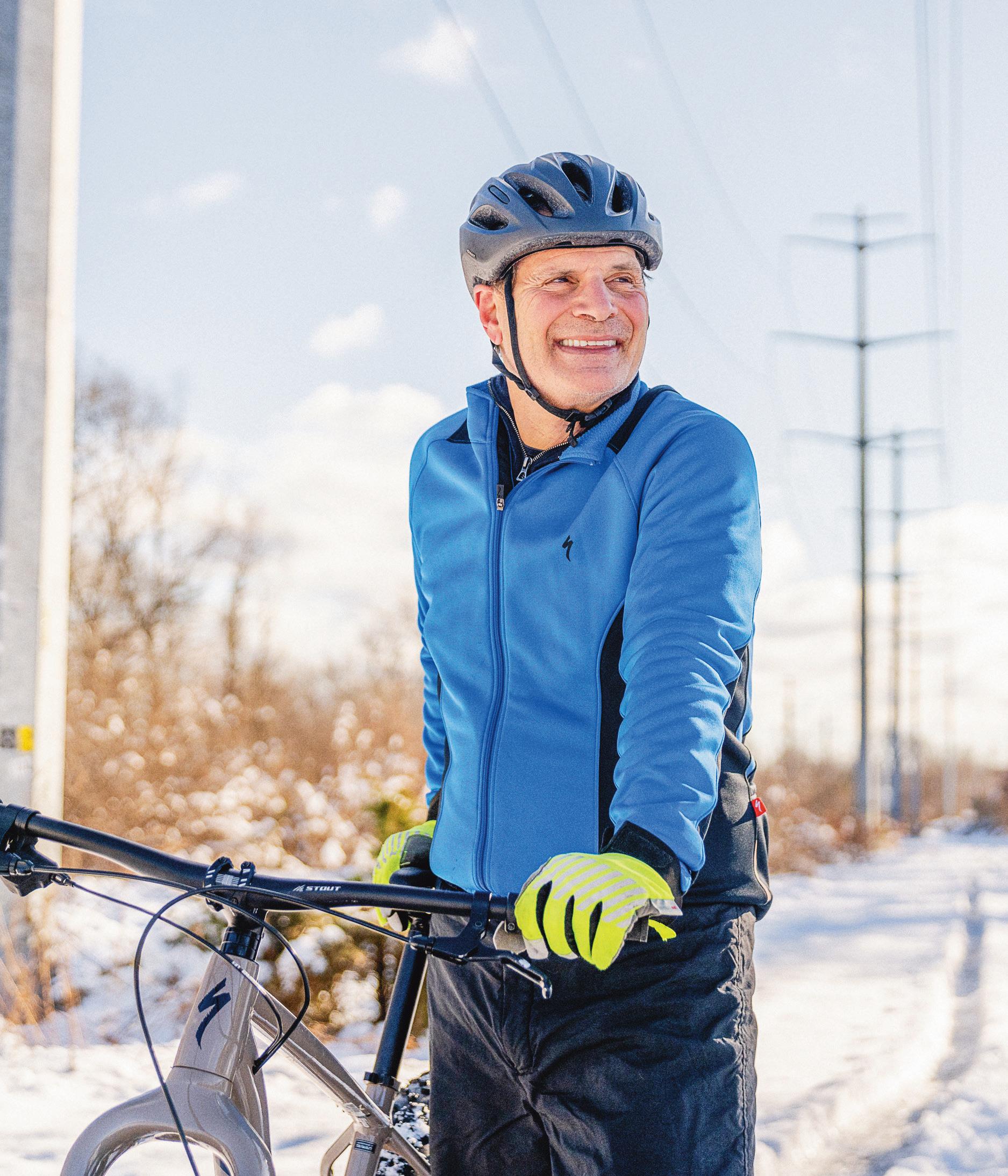
Elsewhere in recent years, TPL has led the development of similarly ambitious trails that seemed improbable, such as the Five Mile Creek Greenbelt, a 17-mile trail in Dallas to connect more than a dozen parks in one of the city’s most destitute districts when it comes to green space; the Atlanta BeltLine, a 22-mile trail that encircles the city on former rail lines; and the 3-mile Bloomingdale Trail and linear park at The 606 in Chicago, which also repurposed a former railway.
The 606 has brought public health benefits to surrounding communities; the BeltLine has improved Atlanta’s climate resilience and economic stability; and the Five Mile Creek Greenbelt is on track to revitalize local neighborhoods and improve urban ecosystems. Numerous other TPL greenways have added substantial new outdoor space and connectivity in parts of cities where they had been lacking.
In 2019, Trust for Public Land conducted a detailed survey of the first section of the Long Island Greenway, a 25-mile stretch from Eisenhower Park to Brentwood State Park (see map, page 38). The site analysis included lidar imaging (a remote sensing technique that uses pulsed radar light) from aircraft to produce detailed images of the ground features; such granular information helps planners consider the finer points of topography and overall feasibility of the route.
Trust for Public Land also led a public engagement process that helped elicit insights about the trail’s development from nearby residents, businesspeople, and public officials—all of whom stand to benefit from its realization. In doing so, TPL gained support for the greenway by bringing people together and guiding them toward a common goal.
Marty Buchman, a cyclist and trail advocate who lives in Port Jefferson, on the island’s North Shore, says the sheer density of development and people on Long Island poses the greatest difficulty in bringing the greenway to life.
“But that’s also the real necessity of it,” he adds. “Suffolk County, especially, wasn’t designed for the amount of traffic it holds. It was originally a rural county, and you have roads that were originally rural county roads now being absolutely choked at rush hour.”
Having ridden bikes in 27 countries and in almost every state, Buchman laments that “Long Island is the absolute worst place to ride.” He and his wife have ridden from London to Krakow, through Israel, Spain, Italy, and Thailand. He’s been hit by vehicles twice on his bike—both times on Long Island. One instance happened to occur on a Bike to Work Day (though he regularly biked 26 miles to his job as a history teacher in Plainview before retiring to teach yoga) in a spot where he had the right of way. It was a busy road, he says, but “at that section of Long Island, there was no alternative.”
Crucially, 60 percent of the planned Long Island Greenway trail would be off-street, meaning users wouldn’t have to travel alongside cars. The first portion is planned to follow a major corridor for utility lines, and in satellite images, a good deal of the prospective route already resembles a trail in the rough.
It’s a practical approach to adding trails in dense areas—and a strategy TPL employs in projects across the country. This typically positions trails away from roads, as well, meaning cooler, shaded places to ride or walk—and, for people like Buchman, the peace of mind that comes with safety.
Long Island is the absolute worst place to ride.”– MARTY BUCHMAN, TRAIL ADVOCATE
Michael Vitti of Glen Head, a North Shore community not far outside New York City, is a serious mountain biker and president of a group called Concerned Long Island Mountain Bicyclists, or CLIMB. He describes the group as “the premier advocate” for bike paths in the area.
He estimates the group, which he and some friends started in 1990, has built and continues to maintain more than 200 miles of mountain bike trails on Long Island, and longdistance paths like the greenway would make those trails easier to reach without a car. “We don’t like putting our bikes in cars to drive an hour to go ride a bike,” Vitti says.
In the late 2000s, CLIMB joined 10 other stakeholder groups in assembling a vision plan. The idea was to build a multiuse trail across Nassau and Suffolk Counties, largely along the former path of the Long Island Motor Parkway, much of which the first section of the Long Island Greenway aims to follow.
Opened in 1908 (and closed in late ’30s), the route is also known as the Vanderbilt Motor Parkway and hosted one of the earliest auto-racing events, the Vanderbilt Cup.
On Long Island, as with many of its previous trail projects, Trust for Public Land is leading an effort to realize a vision that had percolated among residents and grassroots advocates for years, but who ran into repeated roadblocks toward their goals.
As TPL began formulating its strategy to create the Long Island Greenway in 2018, Danny Gold called, among others, Vitti, because he was widely known as a biking and trail advocate. “He wanted to pick my brain about a Long Island Greenway,” Vitti recalls. “To be honest, I wasn’t really interested in calling him back. Because I’m like, ‘This is crazy! This guy is nuts. He’ll never be able to do it. He doesn’t know how much patience you have to have, and all this other stuff.’”
Eventually, Vitti managed to connect with Gold. “He explained he was from the Trust for Public Land,” Vitti says. “So, I did some research, and [thought], ‘Wow, this is a national organization. They’re amazing. And they want to do this on Long Island? Yeah, I’ll help them. But I hope they don’t give up.’” When TPL hired an engineering firm to aid in planning, he knew things were getting serious.
Vitti invited other trail advocates to a meeting TPL convened. The guest list included Denis Byrne, who has studied the history of the Long Island Motor Parkway extensively. “We provided input on which ways to go, because we’d already been planning this, our dream greenway,” Vitti explains. Byrne has long hoped a formal trail could help preserve historic remnants of the parkway. Otherwise, “the route is going to get erased by time,” he says.
Having overcome their initial reservations, Vitti and his fellow bikers at CLIMB are now eager partners, helping TPL gain wider community input and support. And you can bet your knobby tires they’ll be ready to hit the trail as soon as the first section opens.
We don’t like putting our bikes in cars to drive an hour to go ride a bike.”
– MICHAEL VITTI, PRESIDENT OF CONCERNED LONG ISLAND MOUNTAIN BICYCLISTS (CLIMB)


Kim Covell of Water Mill, New York, near Southampton, describes herself not as a dedicated activist but says, “I just give my two cents here and there where the trails are concerned.” When it comes to trails, Covell, who works at an area news organization, qualifies easily as a superfan. “I ride mountain bikes. I ride road bikes. I ride fitness bikes, and I also walk,” she says.
Getting out on trails to ride bikes is also something she and her husband and son enjoy doing together. “You know, every weekend, and when we’re off [work], we’re usually out doing a trail,” she says. Covell also follows several social media feeds that focus on trails, observing, “You get all sorts of tips on trails and hidden places.” She and her brother, who also lives on Long Island, go out together on mountain bike trails such as the 9-mile Calverton Mountain Bike Trail loop near the North Shore town of Wading River.
Covell has ridden the length of Long Island twice as part of a fundraising event but says twice was enough: “I paid my dues. I don’t need to do it again.” That said, her attitude would change with a new route. And she is aware of the Long Island Greenway project. “When they start getting [the trail] out here, I’m going to get super excited.”
As it happens, the Long Island Greenway’s easternmost segment, near where Covell and her family live, is second in line on Lieberman’s planning structure. It will run from Riverhead, near where Long Island forks north and south, to Montauk at the island’s eastern tip. For this approximately 50-mile segment, Suffolk County was awarded a $3.8 million RAISE grant in 2023 from the Department of Transportation (the acronym stands for Rebuilding American Infrastructure with Sustainability and Equity).
Trust for Public Land experts helped write the winning RAISE application, an effort that exemplifies the organization’s experience and ability to get the job done. “Because we are a national
organization with an office in DC and staffers who have deep knowledge and backgrounds in this work, we can provide insight and influence to help secure federal funding for these local communities,” says TPL’s J.T. Horn. “Federal grants are one of the most important ways that TPL can add value.”
The end goal is to get trail users away from roads and speeding vehicles—Long Island accounts for about one-third of the state’s bicycle fatalities. Improved climate resilience and the health benefits that come with time spent outdoors are noteworthy outcomes, as well.
Lieberman wants people to depend on the greenway and feel good about it—for it to serve as an active transportation corridor that connects communities. “It begins with people walking for exercise,” he says. “The next step, if the infrastructure is there, is that it becomes part of their commute, part of their lifestyle. It becomes a part of the way they see the world.” Or even just the state—the entire state.
When they start getting [the trail] out here, I’m going to get super excited.”
– KIM COVELL, TRAIL ADVOCATE
Bradford McKee has written about architecture, landscape, and the public realm since 1993. From 2010 to 2020, he was editor in chief of Landscape Architecture Magazine. He lives in Washington, DC, where he serves on the board of Rock Creek Conservancy.
How working forests offer a bounty of benefits, ensuring sensitive ecological systems flourish while local economies thrive.
By Lisa W. Foderaro
 photos by Tegra Stone Nuess
Sun glints through the trees in a lush, mature forest atop Chimacum Ridge in Washington State (above). Sarah Spaeth of Jefferson Land Trust sits among young, thriving white pine trees (opposite) and shows where deer or elk have rubbed bark with their antlers (center).
photos by Tegra Stone Nuess
Sun glints through the trees in a lush, mature forest atop Chimacum Ridge in Washington State (above). Sarah Spaeth of Jefferson Land Trust sits among young, thriving white pine trees (opposite) and shows where deer or elk have rubbed bark with their antlers (center).

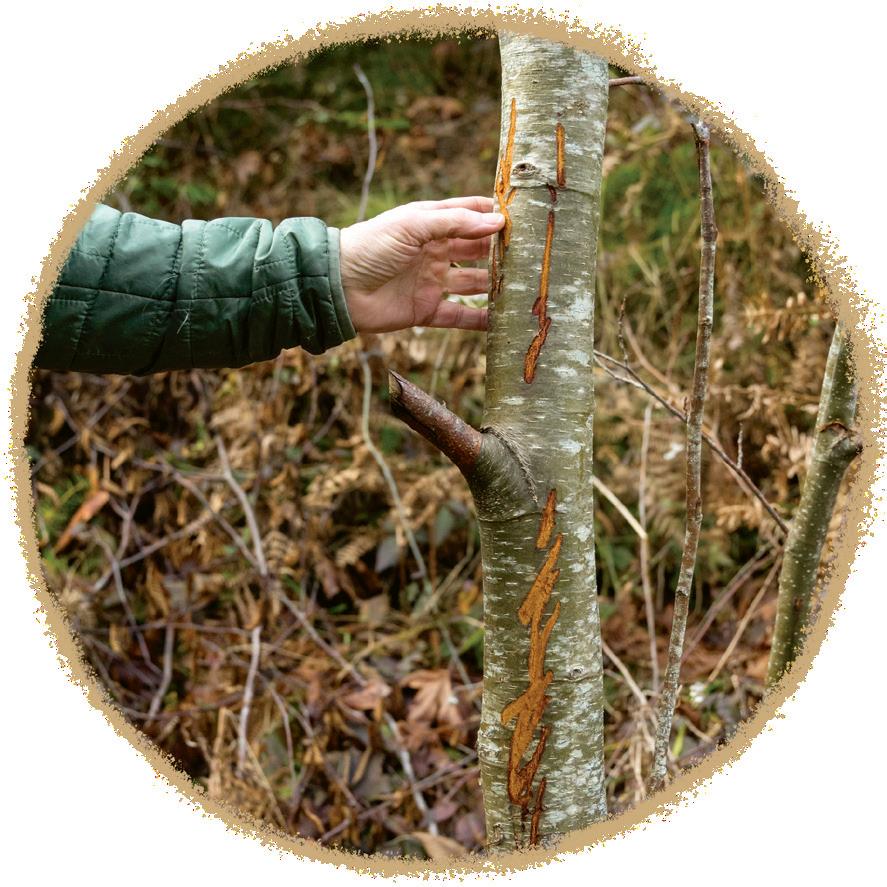


On a brisk afternoon, the earthiness of damp leaves and pine needles perfuming the air, Sarah Spaeth surveys the 853-acre forest in Chimacum, Washington, that her organization, Jefferson Land Trust, recently acquired with TPL’s help.
“We’ve got cedar, we’ve got maple, we’ve got some spruce coming in,” she says, looking pleased as her footfalls trace an old logging road that cuts through the property. “In the far-off corner where you see the tree line—there’s a native cranberry bog down in there.”
For contrast to that natural diversity, she points out the remnants of the forest’s recent past, when Douglas firs were planted so densely the branches were stunted and a fungal disease, laminated root rot, was allowed to spread.
Years ago, a patch that had been clear-cut was replanted with a monoculture of “Doug fir,” as locals call it, the ultralucrative source of lumber that thrives here on the Olympic Peninsula in Washington State. “They wanted those tall skinny firs with no branches,” Spaeth says, referring to the timber company that previously owned the land. “But we want a diversity of trees that have more green growth and get bigger in girth.”

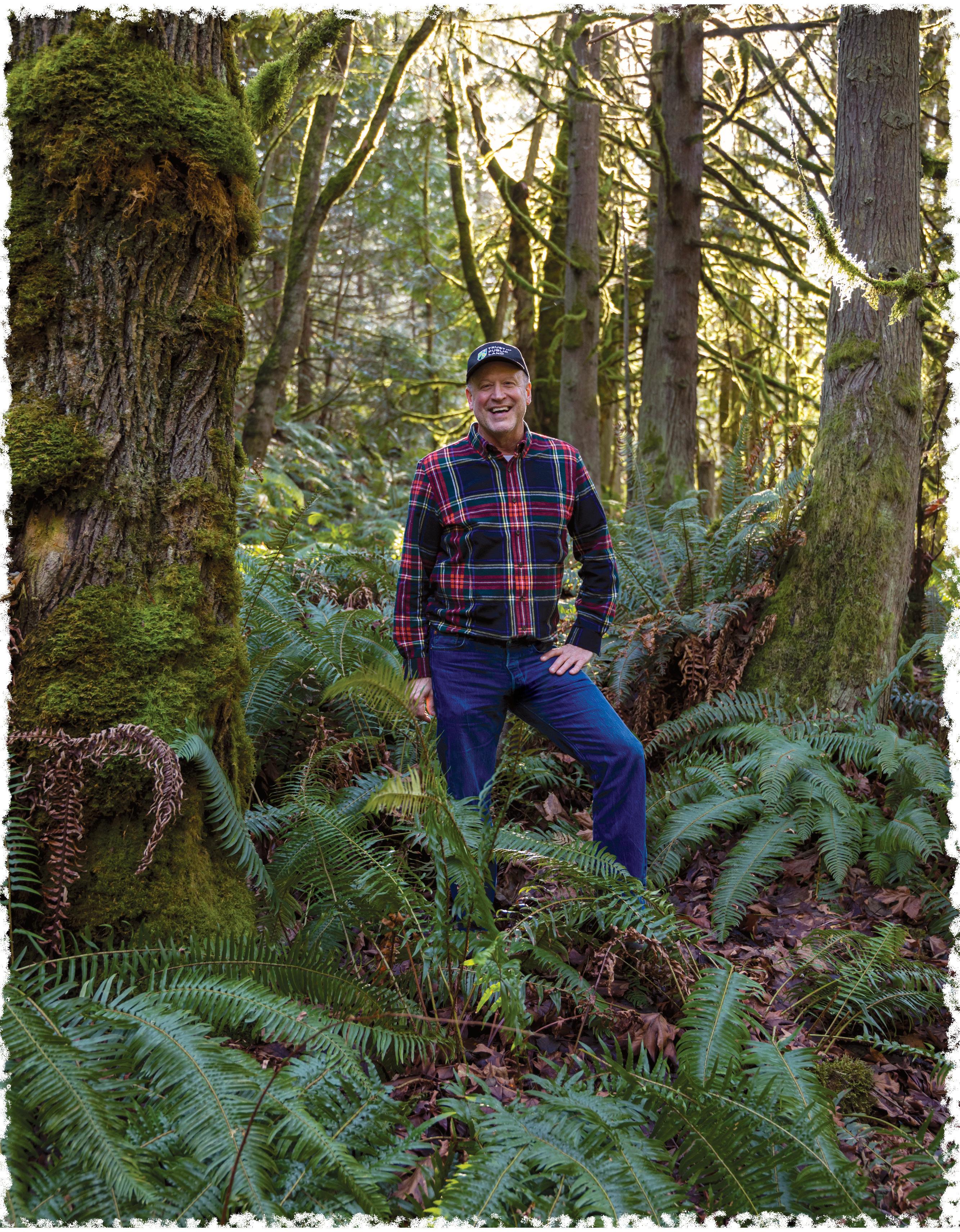
Richard Corff, TPL’s senior director of field programs, walks alongside Spaeth, gesturing toward the healthy understory of huckleberry shrubs and ferns. He notes that in negotiating the purchase terms, TPL and Jefferson Land Trust arranged for two conservation easements (or deed restrictions) on the property, respectively. One prevents any future real estate development. The other lays out a series of rules regarding future timber harvests, letting trees grow longer, for instance, and allowing for a variety of tree species.
“That will create longer harvest rotations that are not only productive but incredibly healthy for the forest,” Corff explains. “It will ultimately create landscapes that store a lot more carbon too.”
An earlier owner had considered selling to a developer that envisioned building a subdivision. Trust for Public Land worked with Jefferson Land Trust to protect and ultimately buy the property, now called Chimacum Ridge Community Forest. Instead of adding houses, lawns, and paved streets, crews are busy blazing trails on the property. They’ll soon be available to the public for healthy pursuits such as hiking, fishing, birdwatching, horseback riding, and mountain biking.
Unlike a lot of conserved lands, however, this property also doubles as a working forest. The model, with Jefferson Land Trust poised to harvest trees sustainably, preserves a way of
life that has dominated this scenic stretch west of Seattle for generations. It protects logging and milling jobs. It provides locally sourced timber for woodworkers and craftspeople in the region. And it demonstrates an ecologically sensitive approach to managing timberlands.
A lighter touch—logging less frequently and thinning trees rather than clear-cutting—reduces the threat of erosion and holds huge climate and environmental benefits. Without runoff from lawns and streets, creeks that support salmon on either side of Chimacum Ridge will remain clear and cold. And carbon stored in the forest will stay largely put.
In the public imagination, conservation groups look to protect undeveloped land by locking it up for wildlife habitat and maybe allowing the public a toehold for recreation. Indeed, Trust for Public Land often conserves lands that become state and local parks or that get added to existing national parks or wildlife refuges that include broader public access for recreation.
But that approach isn’t best for every community or landscape. Working farms, ranches, and timberlands are cornerstones, economically and culturally, of the nation’s diverse regions. Yet with populations rising in recent decades, development has swallowed many of these working lands.
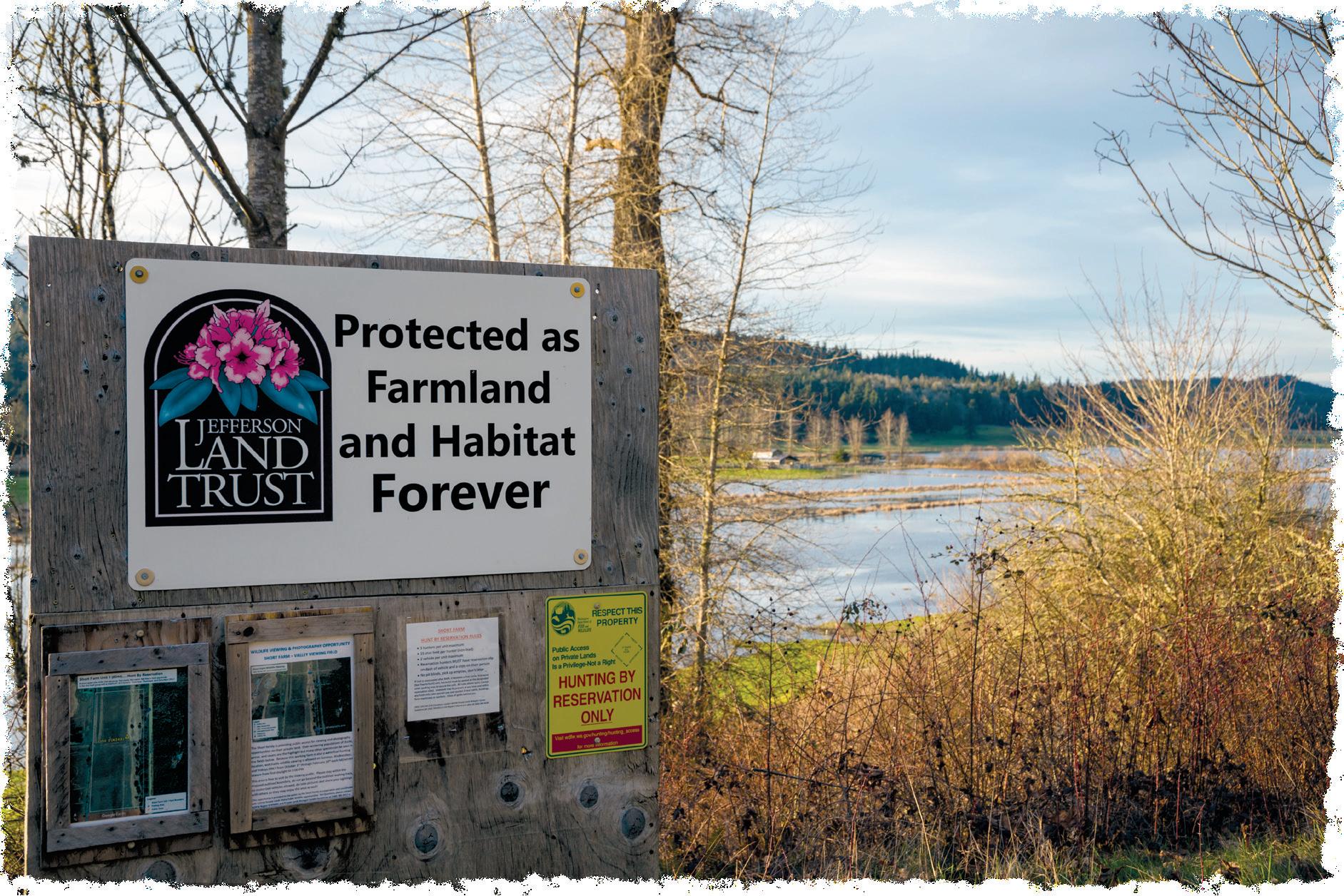

TPL Senior Director of Field Programs Richard Corff (opposite) among the trees and ferns of Valley View Forest, the gateway to Chimacum Ridge Community Forest. We work with local partners to protect land in perpetuity—that is, forever (this page).

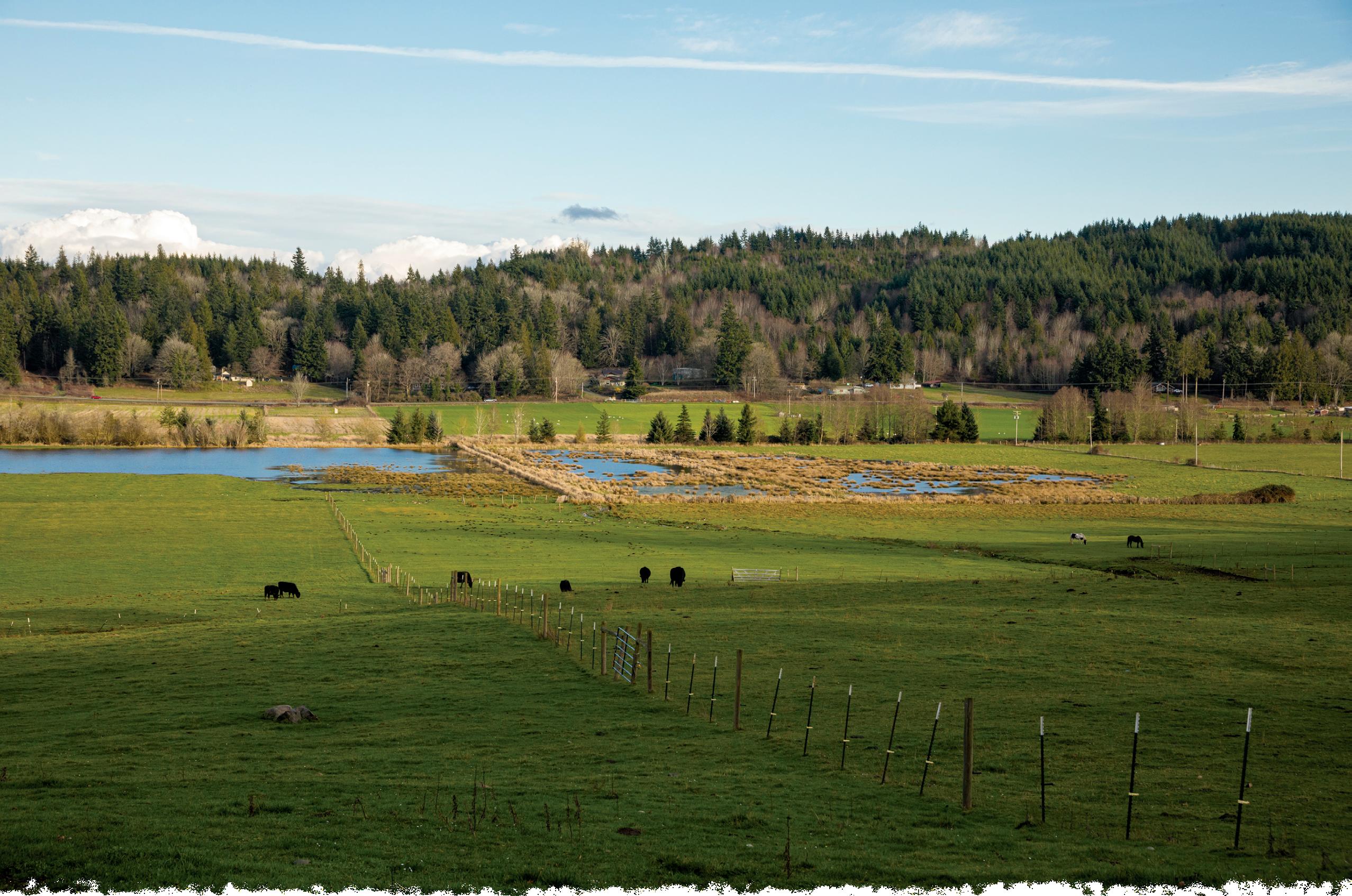
Most of the communities where we focus our energy rely on working lands for their economic well-being, as well as their identity.”
– DAVID PATTON, TPL NATIONAL LANDS INITIATIVE DIRECTOR
Open space and good-paying jobs have given way to shopping centers, subdivisions, and road networks. That, in turn, has consequences for the environment and public health, with aquifers becoming depleted, streams contaminated, and wildlife corridors blocked. In addition, the amount of time and tailpipe emissions required to transport products to market increases. For the public, the erasure of working landscapes can mean the collateral loss of recreational access to woodlands— access often granted informally by timber companies.
Although Jefferson Land Trust wound up purchasing the Chimacum Ridge property, most working land projects are achieved through conservation easements, in which timber companies or ranchers sell or donate their development rights. Those deals are cheaper than buying land outright, and as a result, we can protect more acreage.
“Most of the communities where we focus our energy rely on working lands for their economic well-being, as well as their identity,” explains David Patton, TPL’s national Lands initiative director. “Imagine if you were to take 50,000 acres and cut them up into 40-acre mansion lots. You would have a much different environment than if you retain an intact ecosystem. People continue to benefit from those jobs, and residents and tourists continue to use the land, whether for hunting or fishing or hiking.”
Trust for Public Land has protected hundreds of thousands of acres of working lands across the country in recent decades. Much of that conservation has centered on the
West, with its vast stretches of coniferous forests and fertile grasslands.
In Colorado, we’ve protected a half dozen ranches in the Upper Arkansas Valley, ranging in size from 400 to 3,200 acres. In the nearby Gunnison Valley, located four and a half hours southwest of Denver, TPL was part of a coalition that protected Trampe Ranch, whose operation comprises a fifth of Gunnison County’s agricultural economy.
At 6,000 acres, Trampe Ranch extends from the city of Gunnison to beyond Mount Crested Butte. Its protection yielded a cornucopia of benefits: Beautiful, wide-open spaces attract visitors that sustain the area’s outdoor recreation economy. Scientists from the Rocky Mountain Biological Laboratory conduct research there, including studies on climate change. And animals such as sage-grouse, elk, mule deer, black bears, and mountain lions consider the ranch home.
Conserving this ranchland also saved some of the most striking scenery in Colorado. “Trampe Ranch is in view of some of the state’s most epic trails and the ski runs of the Crested Butte Mountain Resort,” notes Jim Petterson, TPL’s Mountain West region vice president and Colorado and Southwest director. “So, from a visitor standpoint, we are preserving the outdoor experience for people who ski, mountain bike, camp, and hike in the wider region.”
Sometimes, providing public access to working lands is tricky. Think roaring chainsaws, high-pressure irrigation systems, or 1,200-pound heads of cattle roaming the land.
At the Harvey and Gladys Nyland Property in San Juan Bautista, California, for instance, active ranching coexists with public access and cultural preservation. While currently leased for cattle grazing, the land once belonged to the Amah Mutsun Tribal Band, for whom access is still important. The current arrangement, which serves a variety of purposes, was carefully and thoughtfully worked out when Trust for Public Land partnered with three different land trusts to conserve the 540-acre ranch.
After the property—a patchwork of grasslands, wetlands, and seasonal streams—was transferred from TPL to the San Benito Agricultural Land Trust, two other land trusts stepped in to oversee specific conservation easements: One held by the Land Trust of Santa Cruz County ensures continued agricultural use while protecting wildlife habitat.
Perhaps nowhere are our ambitions greater than in Montana. We recently pledged to protect a million acres of land through our Forever Montana campaign in response to rising development pressures there. That is on top of a half million acres we had already protected in the state, as well as in northern Idaho, most of it in the form of working forests.
Some protected timberlands were transferred to the U.S. Forest Service and the Montana Department of Natural Resources and Conservation, agencies that permit some logging. But the majority have remained in the hands of timber companies such as Stimson Lumber, Green Diamond Resource Company, and F.H. Stoltze Land and Lumber Company. Conservation easements on these lands require that timber harvesting be done in accordance with certified sustainability protocols.
Regardless of ownership, the forests are available for public recreational use, and their protection ensures that watersheds and habitats will remain intact for centuries to come. “If you scope out far enough, you’ll see that our conservation efforts protect almost all the private forests across northern Montana, knitting these ecosystems together,” explains Dick Dolan, TPL’s Northern Rockies director. “The valleys are still private because that’s where people live. But essentially, all the uplands will be conserved. Not every last acre, but if you look at the map, it’s a very large contiguous area.”

And a cultural easement held by the Amah Mutsun Land Trust—a novel and historic achievement TPL and partners hope will serve as a model moving forward—allows the tribe regular access to the property for Indigenous stewardship and ceremonial and educational activities without having to ask permission first.
“We hope to share our traditional Indigenous knowledge and practices regarding land management with our partners and the public, so we can all learn from each other,” says Valentin Lopez, president of the Amah Mutsun Land Trust and chairman of the Amah Mutsun Tribal Band.
For the public, the San Benito Agricultural Land Trust opens the property on the first Sunday of every month. These well-attended “Ranch Days,” as they’re called, invite visitors to go on a guided hike or help out with horticultural maintenance, such as planting and pruning. The idea is to give residents a window into the working cattle ranches that underpin the local agricultural economy—and serve as a source of scenic beauty.
One project that stands out for both its size and grandeur is the Kootenai Forestlands. A few years ago, TPL and our partners conserved 50,000 acres in the northwest corner of Montana. There, the rugged Cabinet Mountains are carpeted with Douglas firs, white pines, and ponderosa pines, while free-flowing rivers teem with rainbow trout and bull trout. Stimson Lumber continues to employ local residents in sustainable timbering jobs. Wildlife benefits from the protection of the 133-mile border between the timberlands and the Kootenai National Forest. And the public, meanwhile, has a seemingly endless playground in which to hunt, fish, forage, and hike.
Such is Montana’s popularity that in 2021 the state boasted the most expensive residential property sale in the nation. That’s when media magnate Rupert Murdoch plunked down $200 million for a 340,000-acre ranch (more than twice the size of Chicago) in southern Montana, near Yellowstone National Park. As further evidence of the runaway market, Dolan says some land prices in the area have tripled in the past three years.
“We have a choice,” says Dolan, referring to Kootenai Forestlands and other projects in the pipeline. “We either conserve these working forests, or their fate will be death by a thousand driveways. That’s the crossroads we’re at. The development pressures will not abate.”
Back in Washington State, real estate interest continues to seep west from Seattle and Tacoma into the Olympic Peninsula and environs. The 3,600-square-mile peninsula presents a diverse ecosystem, with glacier-topped peaks, temperate rainforests, and an expansive coastline. Much of it is protected, thanks to Olympic National Park and Olympic National Forest.
But a large swath of open space between Olympic National Park and Seattle—studded with farms, forests, and even a fjord—is being eyed for residential development. “A town like Bremerton in Kitsap County has grown dramatically,” observes TPL’s Richard Corff. “People commute to Seattle from there, which they didn’t use to do.”
In recent years, TPL has completed a string of conservation projects that together boost the region’s recreational appeal, economic vitality, and climate readiness. In fact, lands protected by TPL on the Olympic Peninsula capture nearly 37,000 metric tons of carbon annually, roughly equivalent to emissions from 30,000 gas-powered vehicles driven for one year.
In 2015, Trust for Public Land led an effort to protect some 6,300 acres of working forest along the Dosewallips and Duckabush Rivers, between Olympic National Forest and Hood Canal. In 2020, also on Hood Canal, we conserved more than 2,100 acres of the Dewatto Headwaters Forest, a timberland on the Kitsap Peninsula.
That same year, TPL completed a landmark conservation project at the southern reach of Puget Sound totaling 20,400 acres. Stretching from Case Inlet to Hood Canal, the South Puget Sound Coastal Forest will remain in active timber production, protected from development and accessible to the public forever. Another bonus: the landowner, Green Diamond Resource Company, manages the land under a habitat conservation plan that seeks to protect 51 aquatic and terrestrial species.
Then there was Camp Hahobas. The 430-acre site, a pristine expanse of mature forest and streams on the shores of Hood Canal, was a longtime Boy Scout camp. An hour west of downtown Seattle, Hood Canal is not a manmade canal at all, but a dramatic inland waterway that draws millions of visitors a year. It is also the only true fjord in the lower 48 states. On a clear day, the snowy peaks of the Olympic Mountains are reflected in its calm waters.
In 2019, TPL helped protect the Boy Scout property, transferring part of it to the Great Peninsula Conservancy, a nonprofit group. The conservancy now oversees Hahobas Shoreline Preserve, the portion of the former camp that includes a half mile along Hood Canal, where beds of eelgrass sway in the water. The state manages the rest of the property as a working forest, with revenues supporting public schools.
A key ecological reason for protecting the shoreline from development was preservation of the natural edge. “When the shoreline is armored with retaining walls, you degrade the habitat and you lose that eelgrass,” says Nathan Daniel, the conservancy’s executive director, while maneuvering an aerial photography drone over the preserve. “All these things are interconnected. The resident orca whales feed on the adult salmon, particularly the Chinook, and the Chinook, in turn, eat smaller forage fish that live in the eelgrass. The nutrients coming off the land feed the eelgrass too.”
Habitat protection is foundational to Jefferson Land Trust’s stewardship of Chimacum Ridge, as well. Recently, Spaeth, who is a certified wildlife tracker, found a cougar kill-site at one end of the property, with deer the target. Maintaining open space is critical for large animals such as cougars, also called mountain lions, that range over huge territories.

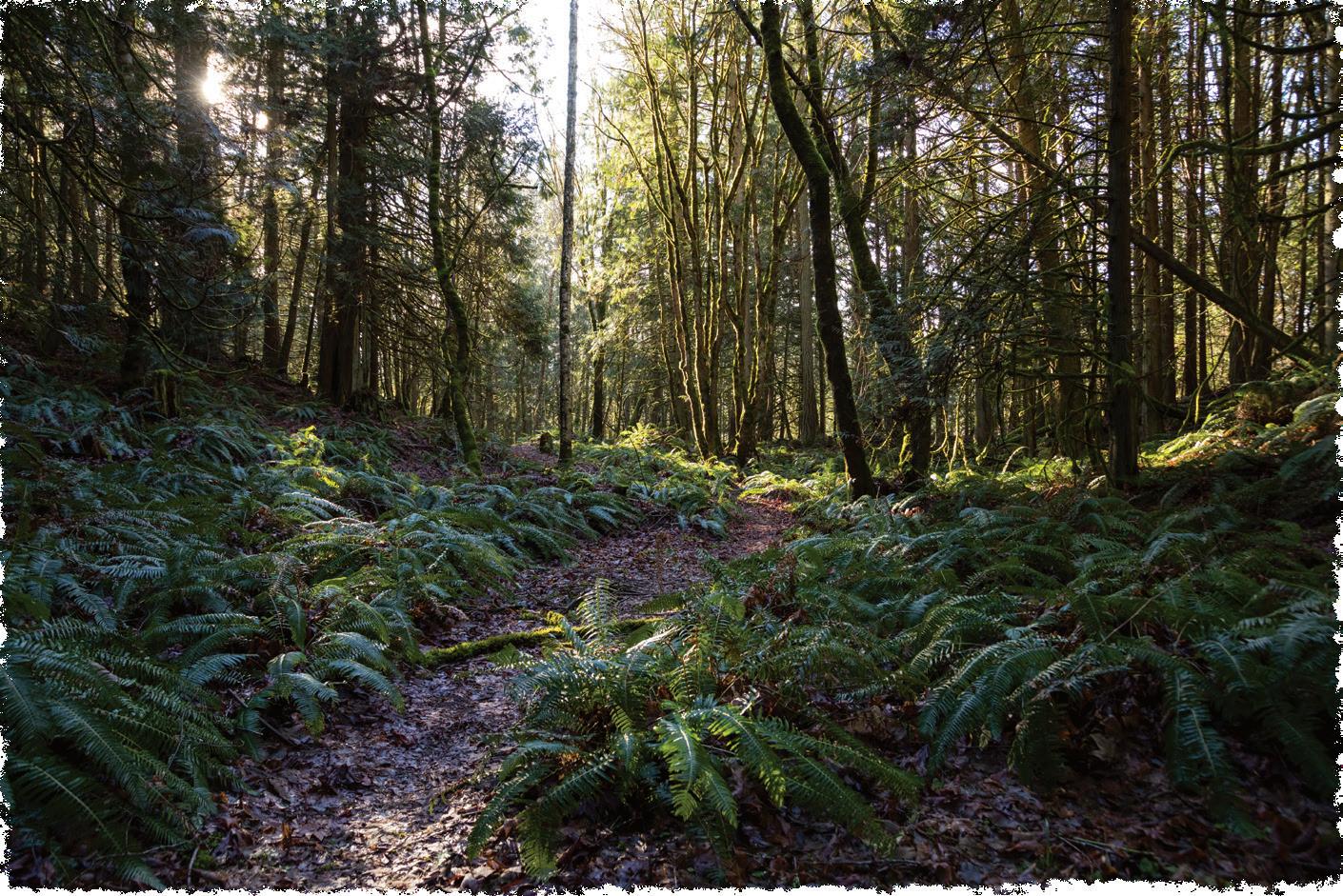
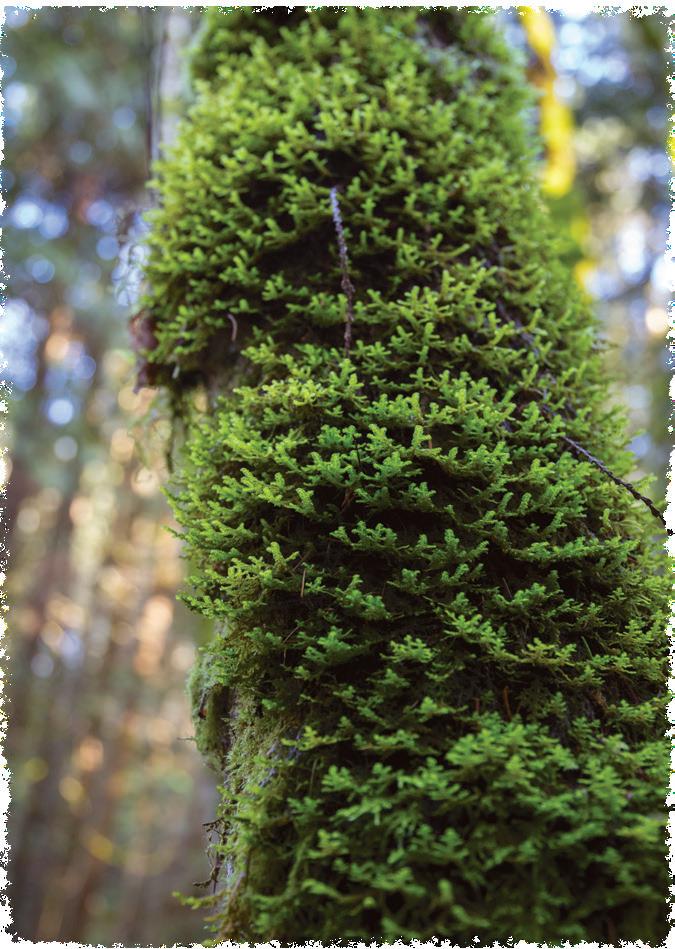
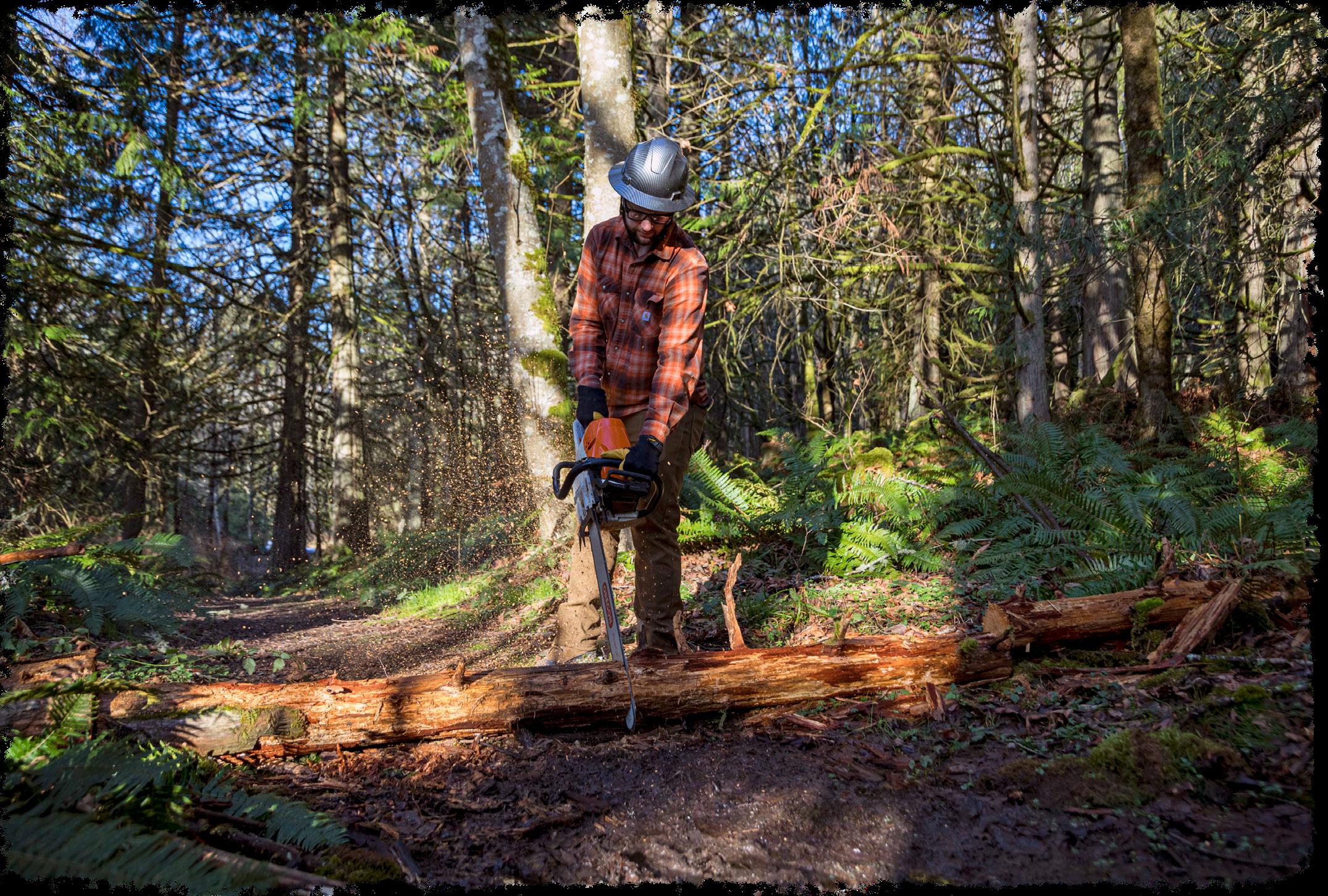
We have a choice. We either conserve these working forests, or their fate will be death by a thousand driveways.”– DICK DOLAN, TPL NORTHERN ROCKIES DIRECTOR Forest Manager Ryen Helzer (below) works to clear downed trees from a trail on Chimacum Ridge.
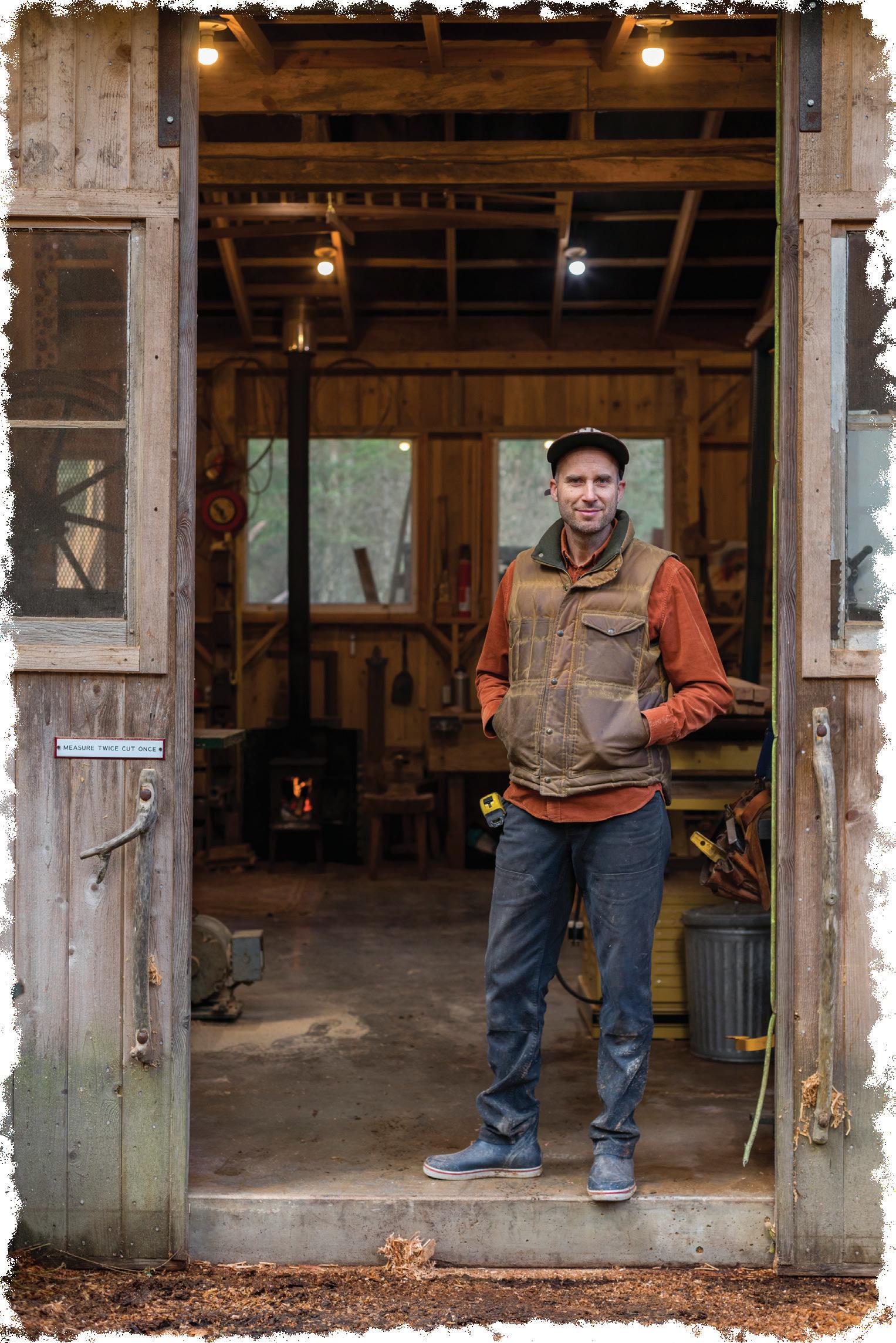
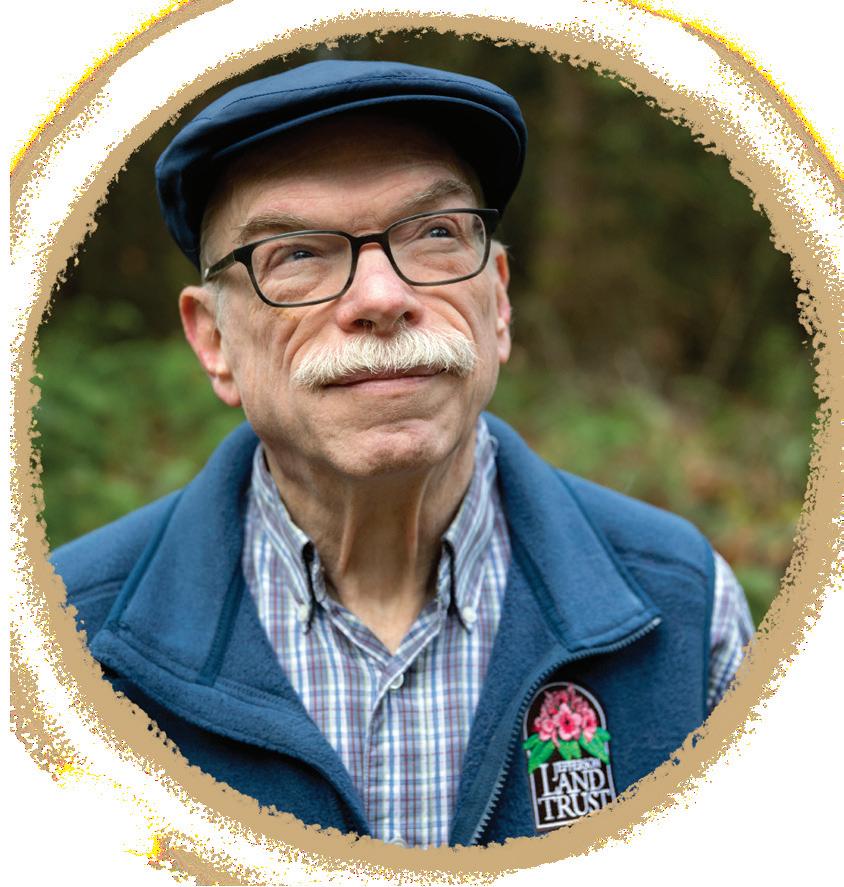
Woodworker Cody Wayland in his Port Townsend workshop (left) uses locally sourced timber as much as possible. Richard Tucker, executive director of Jefferson Land Trust (inset), envisions Chimacum Ridge as a living classroom. Betsy Davis, executive director of the Northwest School of Wooden Boatbuilding (right), shows off a beautifully crafted wooden boat.

When I go into a building that has that connectivity to the place or the land it sits on, I find it much more satisfying.”
– CODY WAYLAND, LOCAL WOODWORKER
In fact, biodiversity will inform the forest's management plan, which Jefferson Land Trust recently hired someone to oversee and implement. Richard Tucker is executive director of the land trust and formerly served as a Trust for Public Land attorney and interim state director of Georgia. “We want an older forest,” he says of Chimacum Ridge. “We want mixed species. We want mixed ages. And we want woody debris and snags.”
Tucker also hopes to turn Chimacum Ridge Community Forest into a living classroom, instilling an appreciation of forests in children and adults alike. For adults, the land trust already offers guided nature walks and workshops on the ABCs of using a chainsaw. For youngsters, Tucker envisions expanding the school groups that now visit the property to something deeper. “Port Townsend has a maritime curriculum where kids learn how to sail,” he says, referring to the city on the northeast tip of the Olympic Peninsula. “We could have a working-landscape curriculum for students in Chimacum, where they learn about forestry and agriculture, as well as related products and careers.”
To be sure, local woodworkers are looking forward to the first harvest from Chimacum Ridge Community Forest. Cody Wayland, a sawyer, furniture maker, and homebuilder in Port Townsend, strives to use locally sourced tree species whenever possible. That lumber might wind up being a bit more expensive than farther-flung, industrially extracted timber, but he thinks it’s worth it. “It’s hard for some clients to choose local lumber for something they will never see, like a stud inside a wall,” he allows. “But for me, when I go into a building that has that connectivity to the place or the land it sits on, I find it much more satisfying.”
Betsy Davis, executive director of the Northwest School of Wooden Boatbuilding, agrees. The school, in Port Hadlock, educates 40 to 60 students a year in the skills and artistry required to become a successful boat builder. Instructors even lead student groups into the woods so they can see the living trees before they become boats.
Douglas fir and western red cedar are favored materials, but generally the trees need to grow for an unusually long time before they’re harvested. Davis plans to ask Jefferson Land Trust to set aside an acre or two of trees that are left to grow for hundreds of years. “We are trying to be sensitive to our carbon footprint, so the more we can source our wood locally, the better,” she says. “I think it’s amazing for a community to have a working forest, especially a community that places such a premium on craftsmanship.”
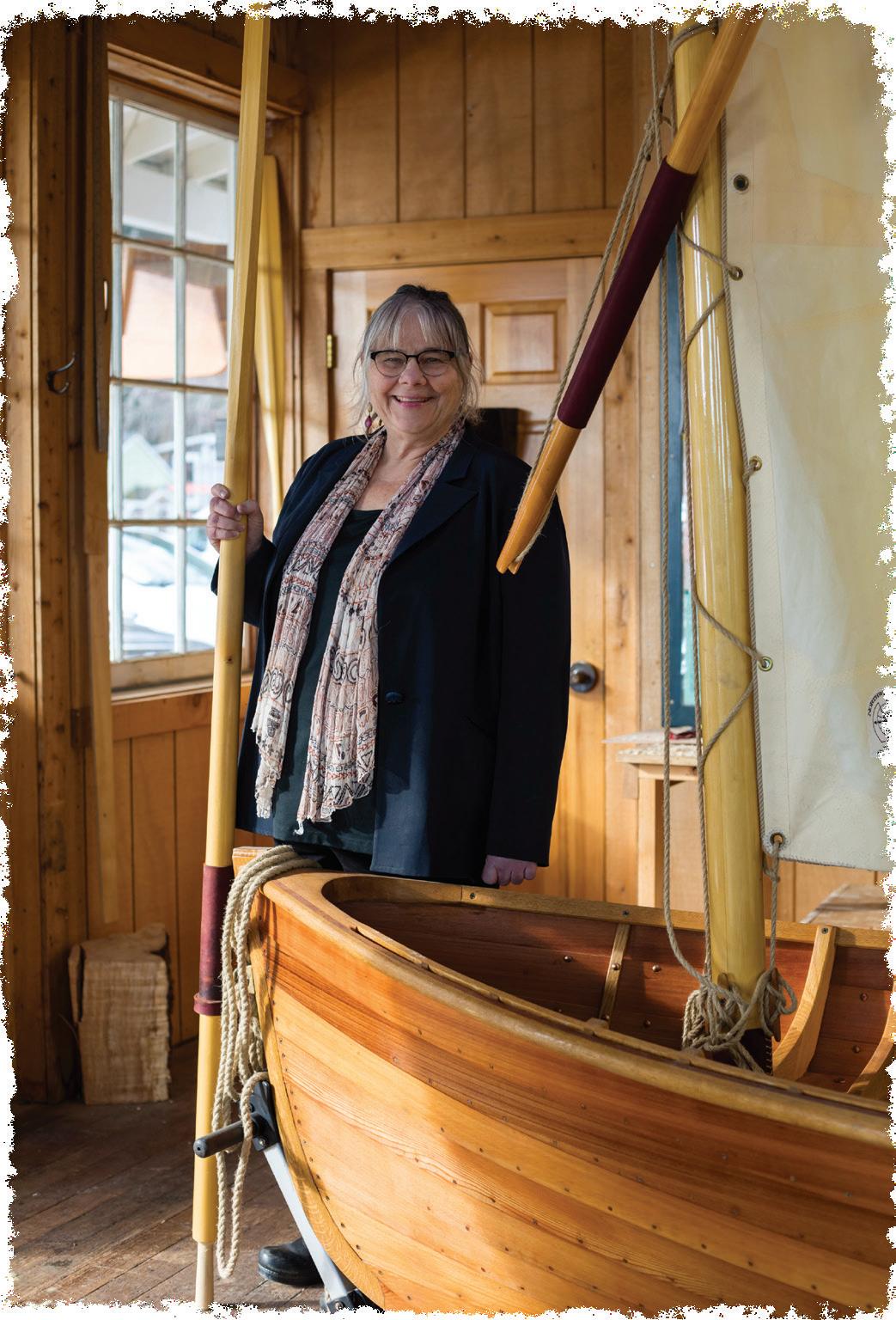
Spaeth, who directs conservation and strategic partnerships for Jefferson Land Trust, makes the analogy to the local food movement that took off in the 1980s, when people began to think and care about the origins of what they eat. “The relationship we have with local food—we want to have that with timber,” she explains.
To encourage this, the land trust did a pilot project a few years ago: it offered local nonprofits and lumber mills a free tree from its Valley View Forest, the 65-acre property adjacent to Chimacum Ridge. “We did a small harvest and said, ‘We’ll cut down the tree if you haul it away,’” she recalls. The uptake was good.
The event showed there is an appetite for local wood and raised awareness about what’s possible. “We’d like to see that chain of timber stay local,” says Spaeth. With groups like Trust for Public Land working to keep forests functioning with and for their communities, there is a much better chance it will.
Lisa W. Foderaro is a senior writer and researcher for Trust for Public Land. Previously, she was a reporter for the New York Times, where she covered parks and the environment.

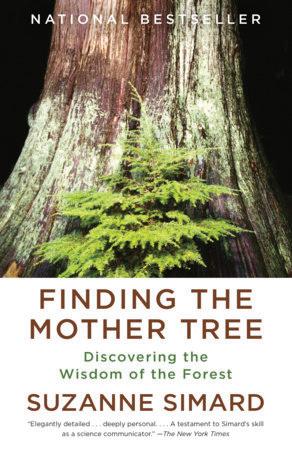

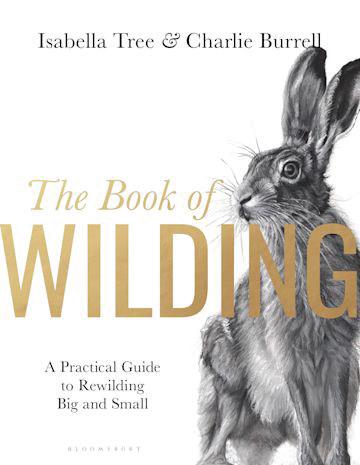
A community compendium of recommendations to bring you closer to the outdoors.
Consider these suggestions from TPL community members and staff on topics from this issue of Land&People, including climate change, community engagement, and landscape restoration.
The Heat Will Kill You First: Life and Death on a Scorched Planet, by Jeff Goodell
“This is an important book for anyone seeking to understand the current and future impacts of a warming world . Goodell covers the effects of extreme heat driven by climate change on cities you’d expect, like Phoenix—where officials reported nearly 500 heat-related deaths in the summer of 2023—and those you might not, such as Boston. The poor are especially vulnerable in neighborhoods that radiate heat and where residents lack air conditioning. Nonurban communities aren’t spared, either. Agricultural producers face heat and drought that reduce harvests. At TPL, such knowledge brings urgency to our work to find public land solutions that lower urban temperatures and protect rural communities.”
Jeff Danter, Chief Program Officer, Trust for Public Land
Explore some of TPL’s climate-smart parks on page 16.
the Mother Tree: Discovering the Wisdom of the Forest, by Suzanne Simard
“This book explores the relationship between mycorrhizal fungi and forest ecology. Simard was working for the U.S. Forest Service and was tasked with figuring out why all their nursery trees were dying. There was this whole idea that if they clear-cut everything, the nursery stock would grow better because there wouldn’t be competition from other vegetation. What she found was that the lack of the forest, the actual plant communities, was the problem, because they support each other by sending nutrients back and forth.”
Anna Halligan , North Coast Coho Project Coordinator, Trout Unlimited
See pages 26 and 48 for more on forest ecology.
Under a White Sky: The Nature of the Future, by Elizabeth Kolbert
“Kolbert provides a lot of examples of how we’ve modified natural systems
only to realize later that we’ve caused unforeseen problems. She also explains why our narrow-minded ‘solutions’ aren’t effective or can even become detrimental. The book acknowledges that we’re going to have to be comfortable taking big risks to offset the negative effects of climate change. The Rancho Cañada floodplain restoration project is an example of the big moves we need to make, where we embrace natural systems to build resilience in the face of increasingly dire projections.”
Jake Smith , Planning and Conservation Program Manager, Monterey Peninsula Regional Park District
Read more about landscape restoration starting on page 26.
The Book of Wilding: A Practical Guide to Rewilding, Big and Small, by Isabella Tree and Charlie Burrell
“Tree and Burrell have written an engaging and accessible book on bringing nature back to our fragmented, drained, and polluted world with many real-life examples
and graphics from their UK farm. The authors distinguish between conventional conservation practices, which have clear and specific outcomes, and wilding (or ‘rewilding’), which is focused, instead, on dynamic processes with uncertain results—for example, reintroducing hooved animals or influencing the timing and severity of floods. These efforts create the conditions that set the stage for recovery without being prescriptive.”
Dr. Lisa Stratton , Director of Ecosystem Management at the Cheadle Center for Biodiversity and Ecological Restoration, University of California Santa Barbara
See page 26 for more on restoring landcapes.
“This Netflix docuseries studies communities where a high percentage of the population lives to over 100. It has to do with physical environment, social environment—all the things that allow people to find purpose and health throughout their lives. As the director of a community center, I found it really interesting. What makes a community healthy and long-lasting? Recreation, shared space, and gathering are big parts of it.”
Alexa Davidson , Executive Director, San Geronimo Valley Community Center
See page 26 for more on our work with communities in California.
“Climate change is hitting the ski industry especially hard. Large ski areas can compensate, to some extent, by making their own snow—but not so for backcountry
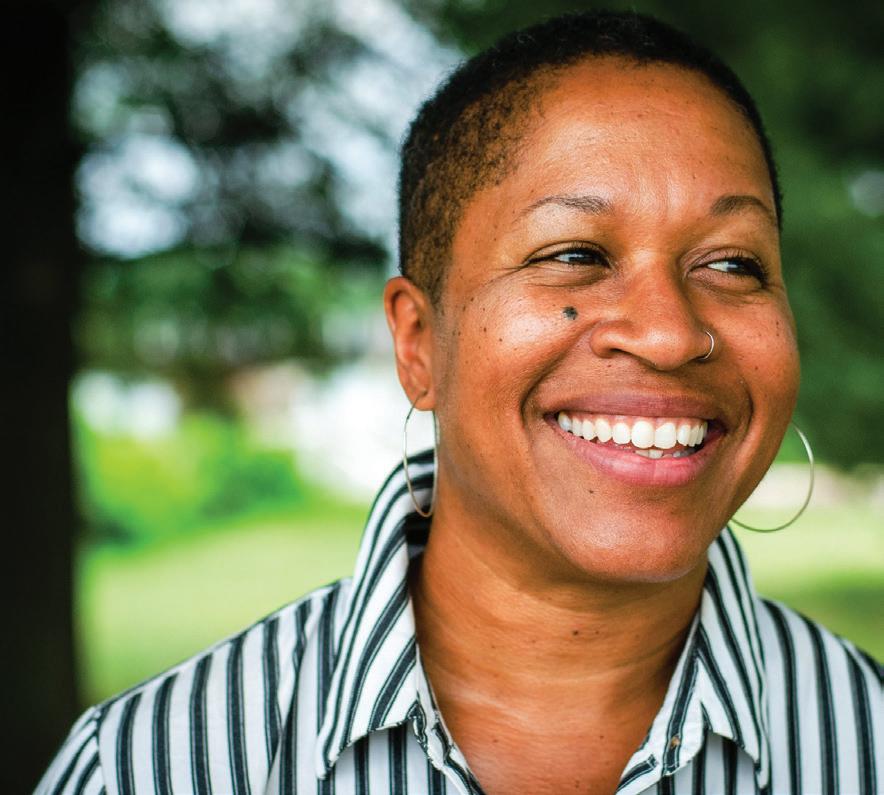
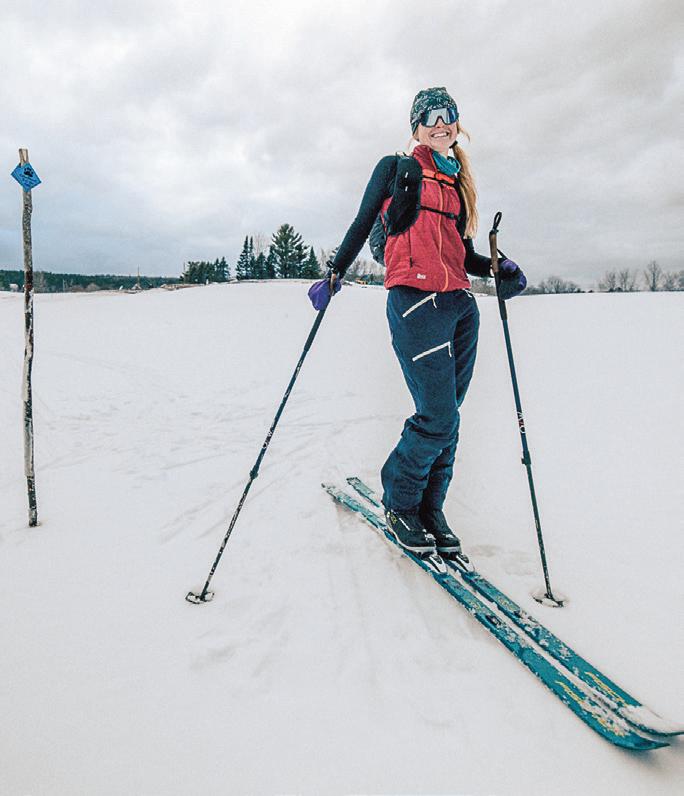
ski areas like the Catamount Trail in Vermont. The 300-mile trail extends the length of the state and draws cross-country skiers from across the Northeast. This documentary follows skier and activist Torey Lee Brooks as she attempts to ski the entire trail amidst a turbulent (and fickle) winter. The film, cosponsored by TPL, intersperses interviews with climate heavyweights like Bill McKibben and conservation gurus such as TPL’s own Shelby Semmes, vice president of our New England region. Come for the story, but stay for the sumptuous, hypnotic cinematography.”
Lisa W. Foderaro, Senior Writer and Researcher, Trust for Public Land
See pages 26 and 38 for more on climate change. 300milesmelting.com
Back
“We at TPL talk a lot about hope. The story of North Campus Open Space, an in-process landscape restoration and public natural area at the University of California Santa Barbara, is an example of what partnership can achieve on behalf of wildlife, public health, and climate resilience. This film by Michael Love features testimonials from students, showcases
inspiring bird life, and leaves you feeling like seemingly impossible goals can be achieved. The kicker? This group brought back a plant, the Ventura marsh milkvetch, that was considered extinct—yes, gone for good. Now NCOS is home to the world’s largest population—which is unirrigated, to boot. How’s that for hope?”
Amy McCullough , Senior Writer and Editor, Trust for Public Land
Also see page 26. vimeo.com/813893043
People. Nature. Big Ideas.
“Subscribe to TPL’s own podcast for fascinating conversations that reframe what it means to have quality outdoor experiences. Host Ronda Lee Chapman, TPL’s equity and belonging director, challenges listeners to consider the stories land holds for all of us, and her guests share unique insights on topics from birding and advocacy to outdoor access for all abilities. No matter the subject, each episode celebrates the importance of getting outside and connecting with nature.”
Deborah Williams, Editorial Director, Trust for Public Land
To subscribe and listen, visit tpl.org/ podcast

Seventeen-year-old Dallas, Texas, resident Ke Meh has a lot on her plate. A South Oak Cliff High School student and a Dallas College student, she’s also involved in extracurricular activities. South Oak Cliff Renaissance Park—the first completed public park in TPL’s Five Mile Creek Greenbelt—is her nearby green space where she goes to rest and recharge.
By Ke Meh, South Oak Cliff High School, Class of 2025South Oak Cliff Renaissance Park is where I go to relax and relieve stress, which has allowed me to persevere in my studies and succeed academically. As a junior in the P-TECH (Pathways in Technology Early College High School) program at South Oak Cliff High School, I balance both high school and college classes, the demands of which can take a toll on my mental health. I’m also on the golf team and a member of the
Junior Reserve Officers’ Training Corps (JROTC), both of which require time and focus outside of my classes.
Honestly, it’s a lot. I’ve found myself languishing in bed, scrolling on my phone, and losing motivation due to procrastination and stress. As a teen who has naturally fallen under the hypnosis of screens, I’ve found that getting outdoors is a better way of escaping. Going to this park, which is a mere five-minute walk from my high school,
When the weight of my future feels too heavy to handle, I visit the park.”
– KE MEH, SOUTH OAK CLIFF HIGH SCHOOL STUDENT
gives me a sense of relief and peace—allowing room for motivation and positivity.
I don’t just go to the park because it’s convenient. I go because it was built on the same values I advocate for, such as the importance of connecting with neighbors and with nature. I usually go to the park with my friends; we join in games with other people and build friendships through basketball, dodgeball, and board games. If I didn’t go to the park, I’d miss having simple conversations with my neighbors and competing in casual, low-pressure sports.
I started an outdoor garden at South Oak Cliff High School called SOC Cultural Garden for similar reasons: I wanted a welcoming space where student-grown crops could feed the community and give my classmates an outdoor activity with purpose. I took into account that our community has limited access to fresh groceries and came together with a group of classmates who shared the same ideas and worked with staff to execute the plan. As a result, the garden has 13 plots as of now, growing about eight different kinds of produce including leafy greens, peppers, and baby root vegetables. It’s run and taken care of weekly by a committee of 11 students, including myself.
South Oak Cliff Renaissance Park, like the cultural garden, is a uniting place for the community—and it was designed with the community. Trust for Public Land worked with us to create the park we wanted, incorporating requested features such as climbing boulders. It reflects the values of my school too; like the park, South Oak Cliff High School has an outdoor learning space for students to enjoy being outside while still benefiting from teaching. This space is also used by the JROTC program to hold lessons or practice different marches. Similarly, South Oak Cliff Renaissance Park can be used for larger high school or community events.
For all these reasons, I was happy when I initially heard, while still in middle school, that a park was being designed by the community and would be located near my future high school. Now, South Oak Cliff Renaissance Park is a great setting where I hang out with friends. We’ve been going there since my freshman year, especially after school during spring semester, since the weather is the best that time of year. Usually, we sit together and chat about school, our personal lives, and our future plans. Or we sometimes play
card games like Uno or spades. Overall, the park is a great place to connect and catch up, as well as have some fun.
Going there alone is also fulfilling. The park is like an oasis in a desert. When the weight of my future feels too heavy to handle, I visit the park by myself. I sometimes sit on the benches near the entrance and enjoy a good book (currently, I’m reading Fahrenheit 451), or I walk around while listening to my favorite musical artist, Daniel Caesar, and breathe in the crisp air. And when I need something to conquer, I like climbing the boulders and using the exercise equipment. I also appreciate how environmentally friendly the park is, with things like rain gardens and solar power.
I feel happier coming to school and more motivated to do my best because my body and mind feel great after time spent outdoors. It gives me the confidence to feel like I can balance everything. For all of these reasons, this park will always be a special place to me.
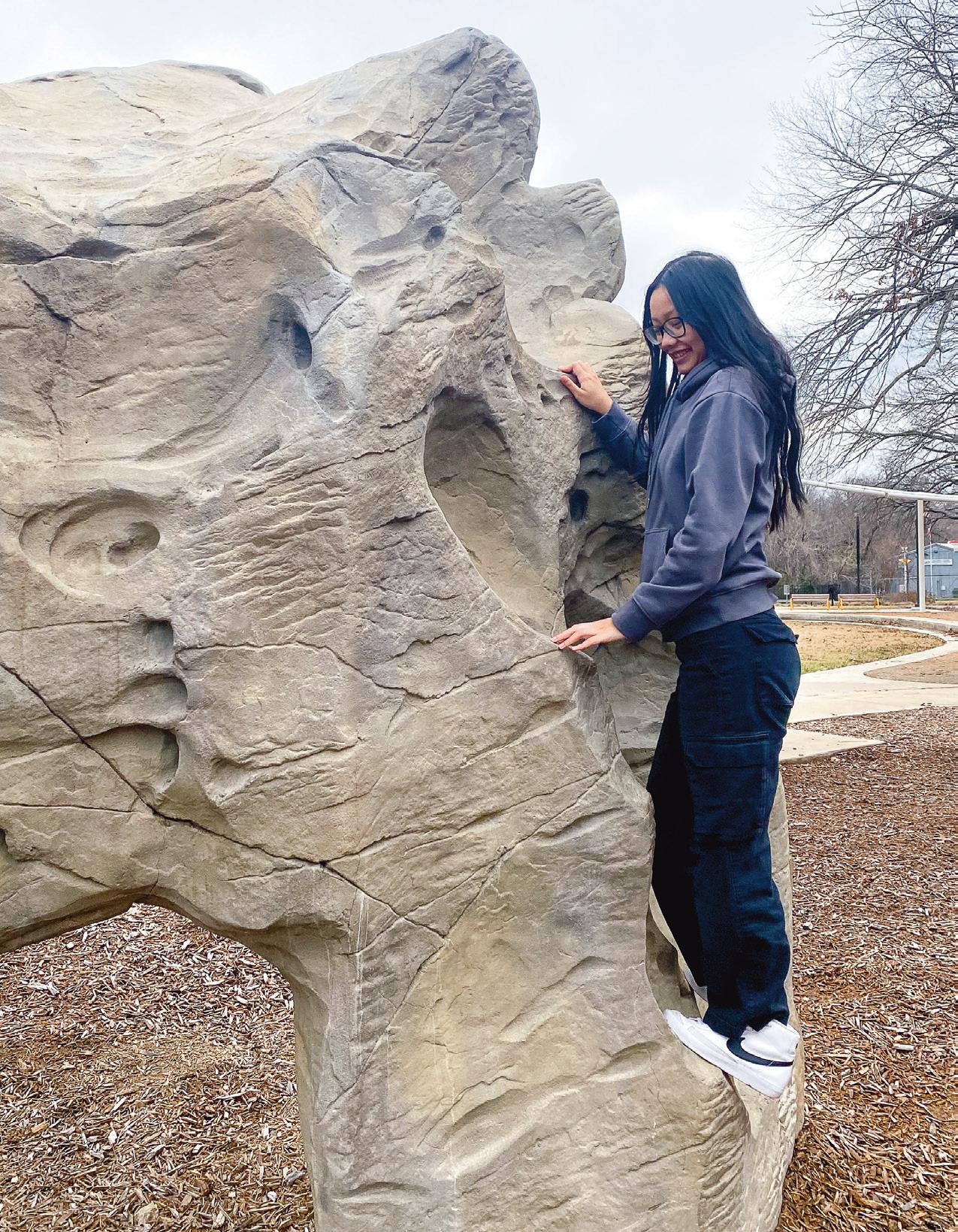
OUR MISSION: TRUST FOR PUBLIC LAND CREATES PARKS AND PROTECTS LAND FOR PEOPLE, ENSURING HEALTHY, LIVABLE COMMUNITIES FOR GENERATIONS TO COME.
As a Trust for Public Land member, you’re a leader in the movement to create healthier, more resilient, and more equitable communities for all. Together, we’re connecting everyone to the outdoors.
Since 1972, supporters like you have helped protect 4 million acres of public land; create more than 5,400 parks, trails, schoolyards, and iconic outdoor places; raise over $94 billion in public funding for parks and public lands; and connect nearly 9.7 million people to the outdoors. Our work depends on the generous contributions of people like you.
Land&People magazine is a benefit to members of Trust for Public Land.
Renew your membership today:
Our Mission:
Donate
Use the envelope inside this magazine or visit tpl.org/land&people to make an additional gift.
Match
Many employers match donations made to nonprofit organizations. Ask your workplace if they participate and sign up to start doubling your impact today.
Share
When you’ve finished reading this issue, pass it on! Or give a gift subscription to Land&People by making a donation on behalf of someone special.
For questions about our work, call 800.714.5263 or email donor.outreach@tpl.org
Trust for Public Land is a registered 501(c)(3) public charity. Because we spend so little to connect everyone to the outdoors, TPL is one of the country’s top-rated nonprofit organizations. Explore our standings at tpl.org/stewardship.

A copy of our latest financial report may be obtained by writing to The Trust for Public Land, 23 Geary St., Suite 1000, San Francisco, CA 94108. Telephone number (415) 495-4014. The Trust for Public Land has been formed to facilitate the transfer of privately held land into protective public and not-for-profit ownership, and to promote other ways to ensure healthy livable communities for generations to come. If you are a resident of one of these states, you may obtain financial information directly from the state agency: FLORIDA – A COPY OF THE OFFICIAL REGISTRATION AND FINANCIAL INFORMATION MAY BE OBTAINED FROM THE DIVISION OF CONSUMER SERVICES BY CALLING TOLL-FREE, 1-800-435-7352 (800-HELP-FLA) WITHIN THE STATE OR VISITING www.800helpfla.com. REGISTRATION DOES NOT IMPLY ENDORSEMENT, APPROVAL, OR RECOMMENDATION BY THE STATE. Florida Registration number CH104; GEORGIA – A full and fair description of the programs of (The Trust for Public Land) and our financial statement summary is available upon request at the office and phone number indicated above; MARYLAND – For the cost of copies and postage, Office of the Secretary of State, State House, Annapolis, MD 21401; MISSISSIPPI – The official registration and financial information of (The Trust for Public Land) may be obtained from the Mississippi Secretary of State’s office by calling 1-888-236-6167. Registration by the Secretary of State does not imply endorsement; NEW JERSEY –INFORMATION FILED WITH THE ATTORNEY GENERAL CONCERNING THIS CHARITABLE SOLICITATION AND THE PERCENTAGE OF CONTRIBUTIONS RECEIVED BY THE CHARITY DURING THE LAST REPORTING PERIOD THAT WERE DEDICATED TO THE CHARITABLE PURPOSE MAY BE OBTAINED FROM THE ATTORNEY GENERAL OF THE STATE OF NEW JERSEY BY CALLING (973) 504-6215 AND IS AVAILABLE ON THE INTERNET AT http://www. state.nj.us/lps/ca/charfrm.htm. REGISTRATION WITH THE ATTORNEY GENERAL DOES NOT IMPLY ENDORSEMENT; NEW YORK – Office of the Attorney General, Department of Law, Charities Bureau, 120 Broadway, New York, NY 10271; NORTH CAROLINA – FINANCIAL INFORMATION ABOUT THIS ORGANIZATION AND A COPY OF ITS LICENSE ARE AVAILABLE FROM THE STATE SOLICITATION LICENSING BRANCH AT 1-888-830-4989. THE LICENSE IS NOT AN ENDORSEMENT BY THE STATE; PENNSYLVANIA – The official registration and financial information of (The Trust for Public Land) may be obtained from the Pennsylvania Department of State by calling tollfree, within Pennsylvania, 1-800-732-0999. Registration does not imply endorsement; VIRGINIA – Virginia State Office of Consumer Affairs, Department of Agricultural and Consumer Services, P.O. Box 1163, Richmond, VA 23218; WASHINGTON – Charities Division, Office of the Secretary of State, State of Washington, Olympia, WA 98504-0422, 1-800-332-4483; WISCONSIN – a financial statement of (The Trust for Public Land) disclosing assets, liabilities, fund balances, revenue, and expenses for the preceding fiscal year will be provided upon request; WEST VIRGINIA – Residents may obtain a summary of the registration and financial documents from the Secretary of State, State Capitol, Charleston, WV 25305. Registration with any of these state agencies does not imply endorsement, approval or recommendation by any state.
president & chief executive officer
Diane Regas
chief program officer
Jeff Danter
chief impact officer
Luis Benitez
senior vice president & chief philanthropy officer
Patricia Watson
senior vice president & director of land & people lab
Howard Frumkin
senior vice president & general counsel
D. Malcolm Carson
senior vice president of policy , advocacy & government relations
Bill Lee
senior vice president & chief financial & administrative officer
Jim Obendorf
naTI onal o FFIC e S
National Office
23 Geary St., Suite 1000 San Francisco, CA 94108
415.495.4014
Federal Affairs
100 M St. SE, Suite 700 Washington, DC 20003
202.543.7552
STaTe an D loCal o FFICe S
C al IF orn I a
California State Office
23 Geary St., Suite 1000 San Francisco, CA 94108
415.495.4014
Also serves: Nevada
Pasadena Office
135 W. Green St., Suite 4400 Unit Q25-2 Pasadena, CA 91105
323.223.0441
Sacramento Office
1107 9th St., Suite 1050 Sacramento, CA 95814
916.557.1673
C olora D o
Colorado State Office
1410 Grant St., Suite D210 Denver, CO 80203
303.837.1414
Also serves: Kansas, Nebraska, South Dakota
C onne CTICUT
Connecticut State Office
101 Whitney Ave., 2nd Floor New Haven, CT 06510
203.777.7367
F lor ID a
Florida State Office
1834 Hermitage Blvd., Suite 100 Tallahassee, FL 32308
850.222.7911
Also serves: the Caribbean
G eor GI a
Georgia State Office
600 W. Peachtree St. NW Suite 1840 Atlanta, GA 30308
404.873.7306
Also serves: Alabama
hawa I ‘ I
Hawai‘i State Office 1164 Bishop St., Suite 1512 Honolulu, HI 96813
808.524.8560
I ll I no IS
Illinois State Office
55 W. Monroe St., Suite 3360 Chicago, IL 60603
312.750.9820
ma I ne
Maine State Office
30 Danforth St., Suite 106 Portland, ME 04101
207.772.7424
ma SS a C h US e TTS
Massachusetts State Office 6 Beacon St., Suite 615 Boston, MA 02108
617.367.6200
Also serves: Rhode Island
m I nne S o T a
Minnesota State Office 2610 University Ave., Suite 300 St. Paul, MN 55114 651.917.2240
Also serves: Indiana, Iowa, Michigan, Missouri, North Dakota, Wisconsin
m ISSISSIPPI
Mid-South Regional Office P.O. Box 16667 Jackson, MS 39236 601.213.8077
Also serves: Arkansas, Louisiana, Oklahoma
mon T ana
Northern Rockies Office 1007 E. Main St., Suite 300 Bozeman, MT 59715 406.522.7450
Also serves: Idaho
new jer S ey
New Jersey State Office 60 Park Pl., Suite 901 Newark, NJ 07102 973.998.9440
new mex IC o
New Mexico State Office 607 Cerrillos Rd., Suite F1 Santa Fe, NM 87505 505.988.5922
Also serves: Arizona and Utah
new york
New York State Office 632 Broadway, Suite 902 New York, NY 10012 212.677.7171
oh I o
Ohio State Office 1250 Old River Rd., Suite 202 Cleveland, OH 44113 216.928.7518
ore G on
Northwest Field Office 15 SW Colorado Ave., Suite 100 Bend, OR 97702 541.322.0133
P enn S ylvan I a
Pennsylvania State Office 1608 Walnut St., Suite 302 Philadelphia, PA 19103 215.240.7710
T enne SS ee
Tennessee State Office P.O. Box 3240 Chattanooga, TN 37404 423.265.5229
Also serves: Kentucky
T exa S
Texas State Office 3000 Pegasus Park Dr., Suite 752 Dallas, TX 75247 469.615.5448
vermon T Vermont State Office 3 Shipman Pl. Montpelier, VT 05602 802.223.1373
Also serves: New Hampshire
wa S h I n GT on
Northwest Regional Office 1218 Third Ave., Suite 1700 Seattle, WA 98101 206.587.2447
Also serves: Alaska
Northwest Field Office 18 North Wenatchee Ave. 2nd Floor Wenatchee, WA 98801 509.888.0844
wa S h I n GT on , DC Chesapeake and Carolinas Office 100 M Street SE, Suite 700 Washington, DC 20003 202.543.7552
Also serves: Delaware, Maryland, North Carolina, South Carolina, Virginia, West Virginia
wyom I n G
Northern Rockies Office
690 W Broadway, Suite 200 Jackson, WY 83001 307.739.3941
It’s a commemoration and celebration of Black Americans using land for their own purposes.
By Dr. Jocelyn Imani, TPL National Director of Black History and CultureI didn’t grow up celebrating Juneteenth. Not all Black Americans do.
I’m from Tennessee, and—for a long time—Juneteenth was a holiday recognized primarily in Texas and Louisiana. It’s a regional holiday that became a national one. I did, however, grow up going to African street festivals, Black family reunions, classics and homecomings at historically Black
colleges and universities, and other Black celebrations that evoke similar feelings of strength and belonging.
As TPL’s national Black History and Culture director, I think about land—a lot. I think about the ways it’s used by and meaningful to all people. This is why Juneteenth is important to me in my role at TPL: because it marks a time when Black Americans began to use public land for their own purposes.

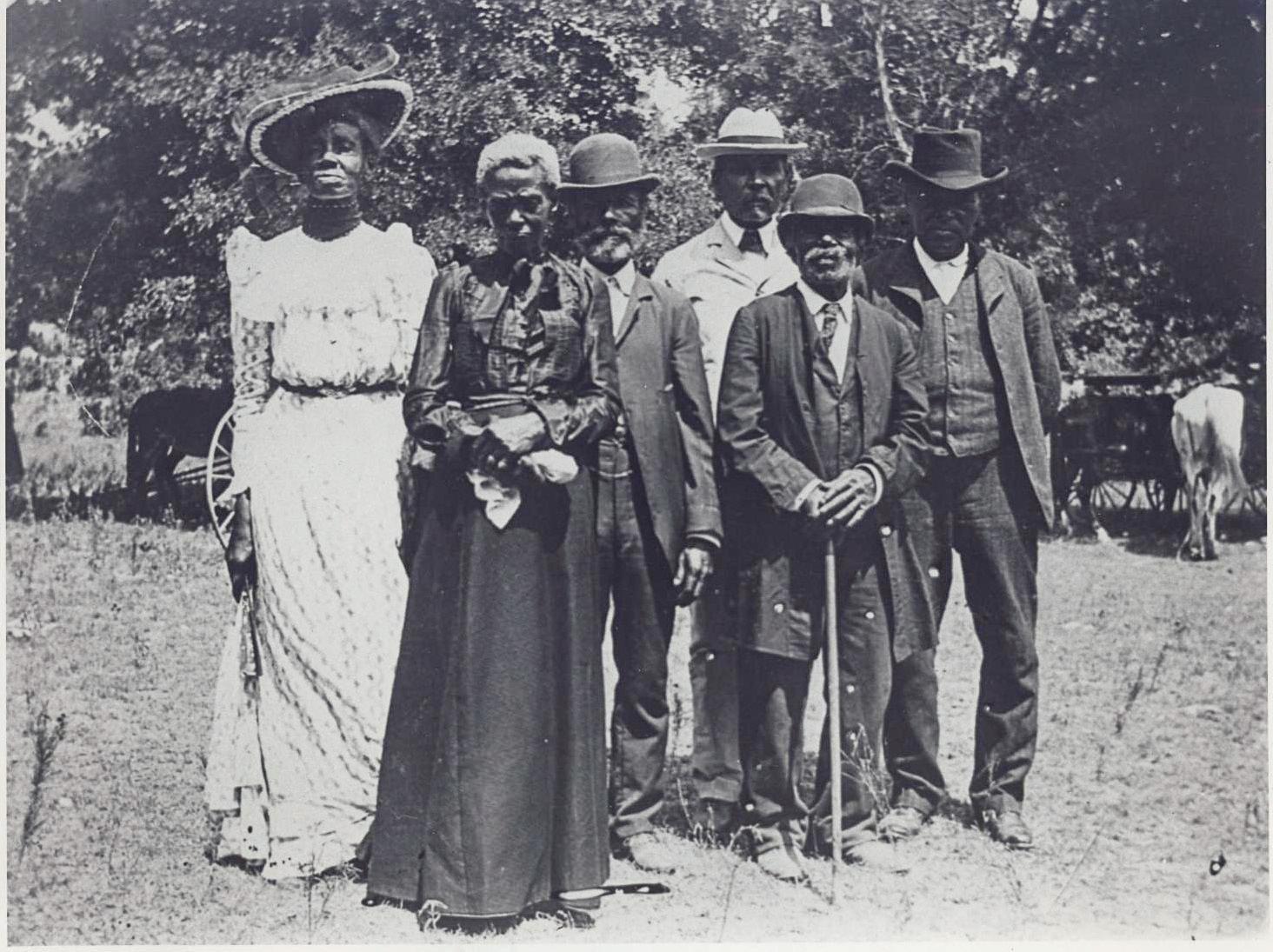

This is how Juneteenth is celebrated—by Black communities gathering outdoors, on public land, and asserting our humanity.”
As you may know, Juneteenth marks the day, June 19, 1865, when Union troops arrived in Galveston, Texas, and announced that enslaved people were free by executive decree.
But Juneteenth isn’t the only Emancipation Day celebrated in this country. The first was in Washington, DC, in 1862, when Congress passed the Compensated Emancipation Act to end slavery there, and the bill was signed into law. Mind you, this was a year before the Emancipation Proclamation, which marks the second Emancipation Day, on January 1, 1863.
In fact, Juneteenth is one of many emancipation days. It’s the one now known for spreading the final word of freedom. But the “news,” when shared with enslaved people in Galveston, wasn’t news at all. It’s a common misconception that Black people didn’t already know they were free.
In 1937, the Works Progress Administration published a landmark series of interviews with former slaves, many of whom said they were aware of the 1863 Emancipation Proclamation long before they were granted their freedom. “I done heard [in March of that year], but they didn't turn us loose then,” said Henry Lewis, a Black man born in 1835 in Pine Island, Texas, northwest of Houston.
Enslaved people knew. But when the period of legal enslavement ended, there was no slavery-to-freedom transition or 12-step program, no mass psychological counseling, no job corps, no fifty bucks to help you on your way. Many Black people were, in essence, stuck where they were.
Immediately, however, Black Texans began the search for family members, and very soon after started celebrating Emancipation Day. In 1872, four formerly enslaved Black men secured a permanent home for Juneteenth celebrations in Houston. They pooled their money, purchased 10 acres of land, and named the place Emancipation Park. In 1918, it became a city park—and it still exists today as the oldest park in Texas.
Let that sink in: a group of people who’d been held in dehumanizing captivity for much of their lives amassed enough resources to secure a landscape for annual freedom celebrations just seven years after gaining their freedom. That’s pretty incredible.
– DR. JOCELYN IMANI, TPL NATIONAL DIRECTOR OF BLACK HISTORY AND CULTURE
Black people have used public parks as settings for community building from the late 19th century to the present, and Juneteenth is no different. Public parks allow people to engage in cultural connections that satisfy needs beyond what their nuclear families or personal situations may provide.
The events in my own history that are akin to Juneteenth celebrations—the parades and festivals—included kids’ dance groups, high school bands, and church step teams; they’re proving grounds. I remember watching the festivities when I was very young and looking forward to participating in them when I got older—to being out in front of my community. Now, I’m the adult cheering the younger ones on from the crowd. These gatherings and annual emancipation celebrations are different, but they all facilitate intergenerational cultural transmission and memory making; that's powerful to me.
This is how Juneteenth is celebrated—now and long before it was a national holiday: by Black communities gathering outdoors, on public land, and asserting our humanity. By elevating and rejoicing in our culture, we remind ourselves that we have worth. We are loved and have a place to belong.
Black people have been leveraging public land for our collective benefit for a long time. Street festivals, church picnics, cookouts, family reunions, and Juneteenth celebrations happen on public land—and represent a consistent way we connect to public land. They are places where Black folks can see our own beautiful reflections and share that beauty with the next generation. These events provide the opportunity to use land—the same land our ancestors worked on and invested in—as a space to exert our freedom.
We can use public land to do so many things: feed people, educate people, employ people, raise policy awareness, and build community. In these spaces, we can reconcile the past and realize who we actually are, and that gives us the backbone and fortification to go boldly into our future.
Get to know Dr. Imani and TPL’s Black History and Culture work at tpl.org/imani and tpl.org/bhc. Subscribe to our podcast and stay tuned for a related episode at tpl.org/podcast
